MBA Project: Teamwork Effectiveness on Employee Motivation in Malaysia
VerifiedAdded on 2023/06/08
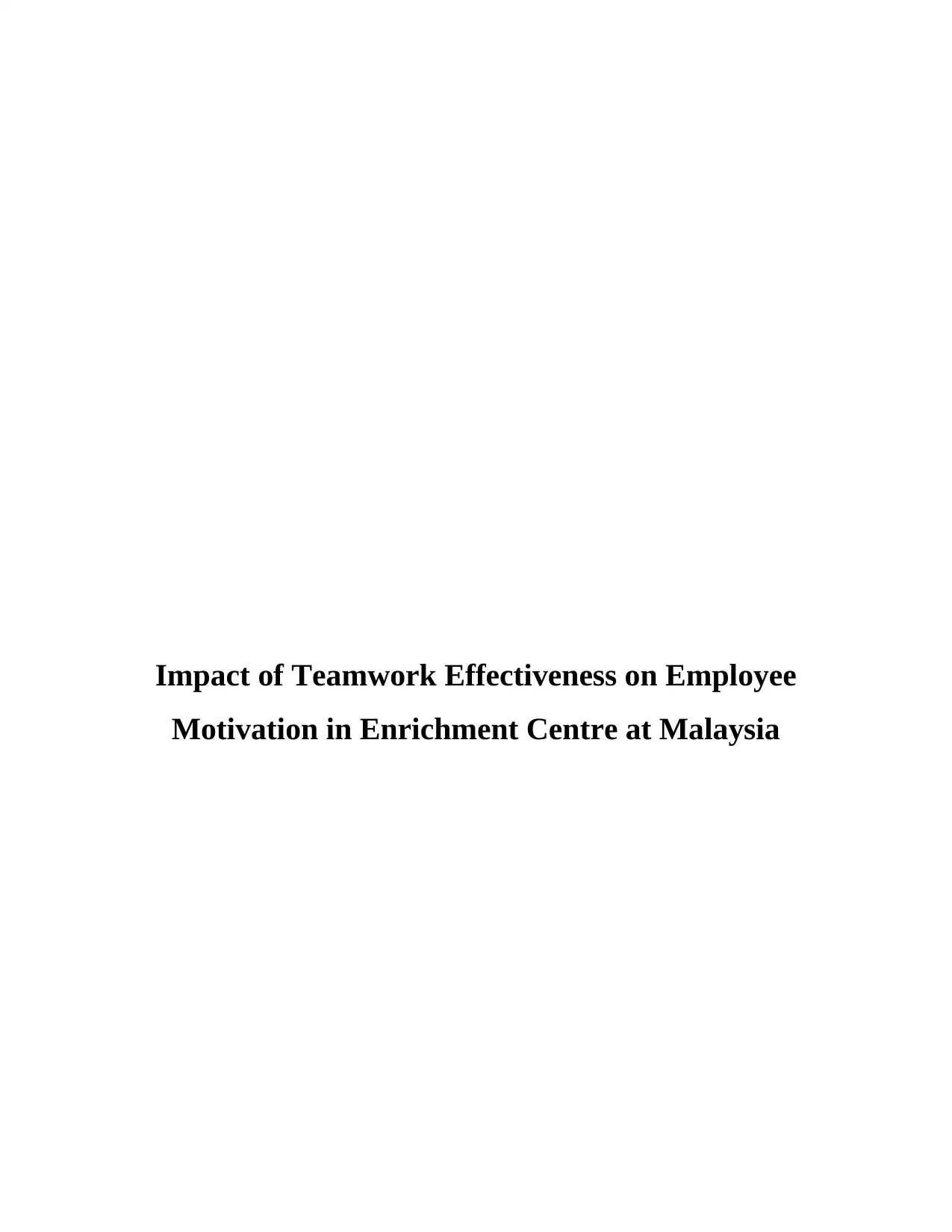
Motivation in Enrichment Centre at Malaysia
Paraphrase This Document
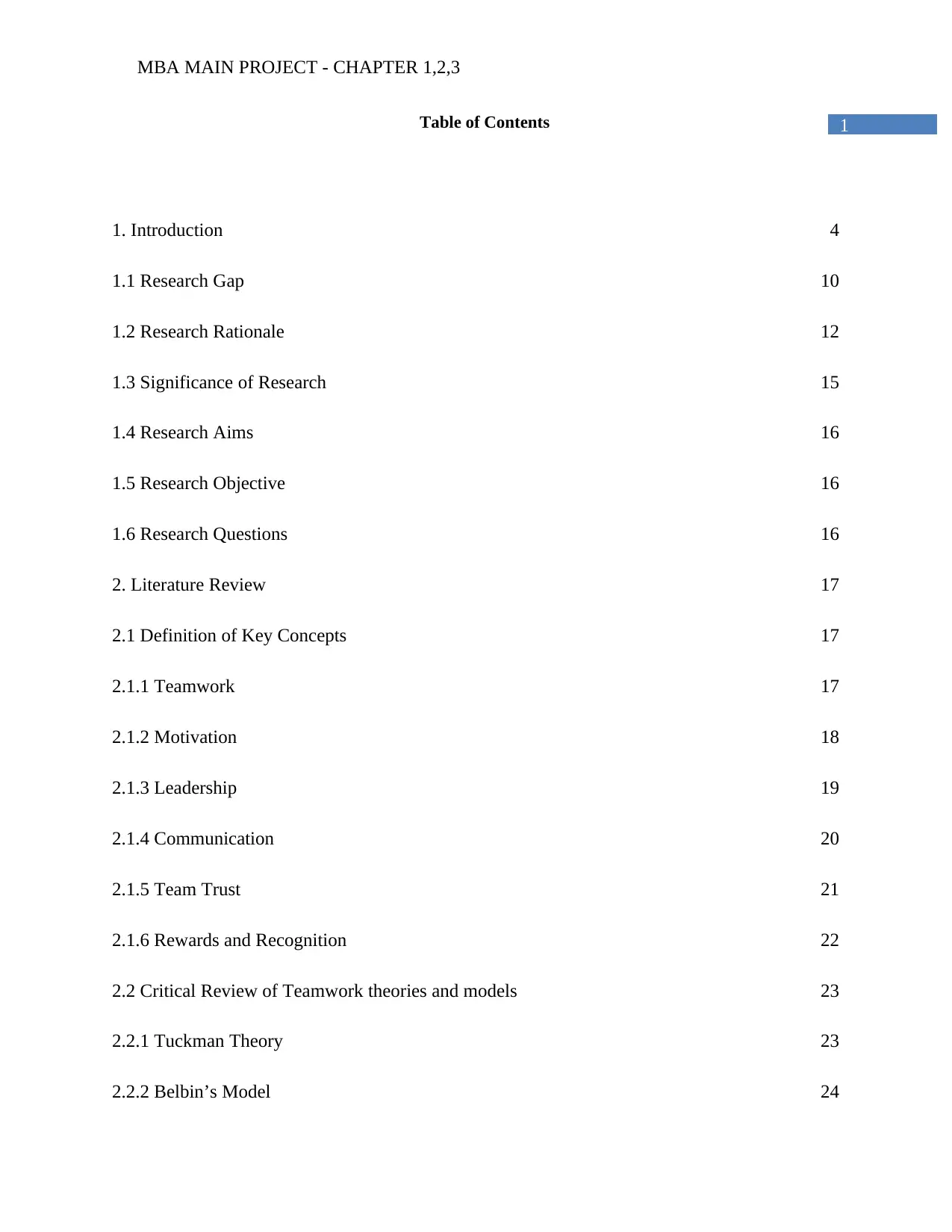
1Table of Contents
1. Introduction 4
1.1 Research Gap 10
1.2 Research Rationale 12
1.3 Significance of Research 15
1.4 Research Aims 16
1.5 Research Objective 16
1.6 Research Questions 16
2. Literature Review 17
2.1 Definition of Key Concepts 17
2.1.1 Teamwork 17
2.1.2 Motivation 18
2.1.3 Leadership 19
2.1.4 Communication 20
2.1.5 Team Trust 21
2.1.6 Rewards and Recognition 22
2.2 Critical Review of Teamwork theories and models 23
2.2.1 Tuckman Theory 23
2.2.2 Belbin’s Model 24
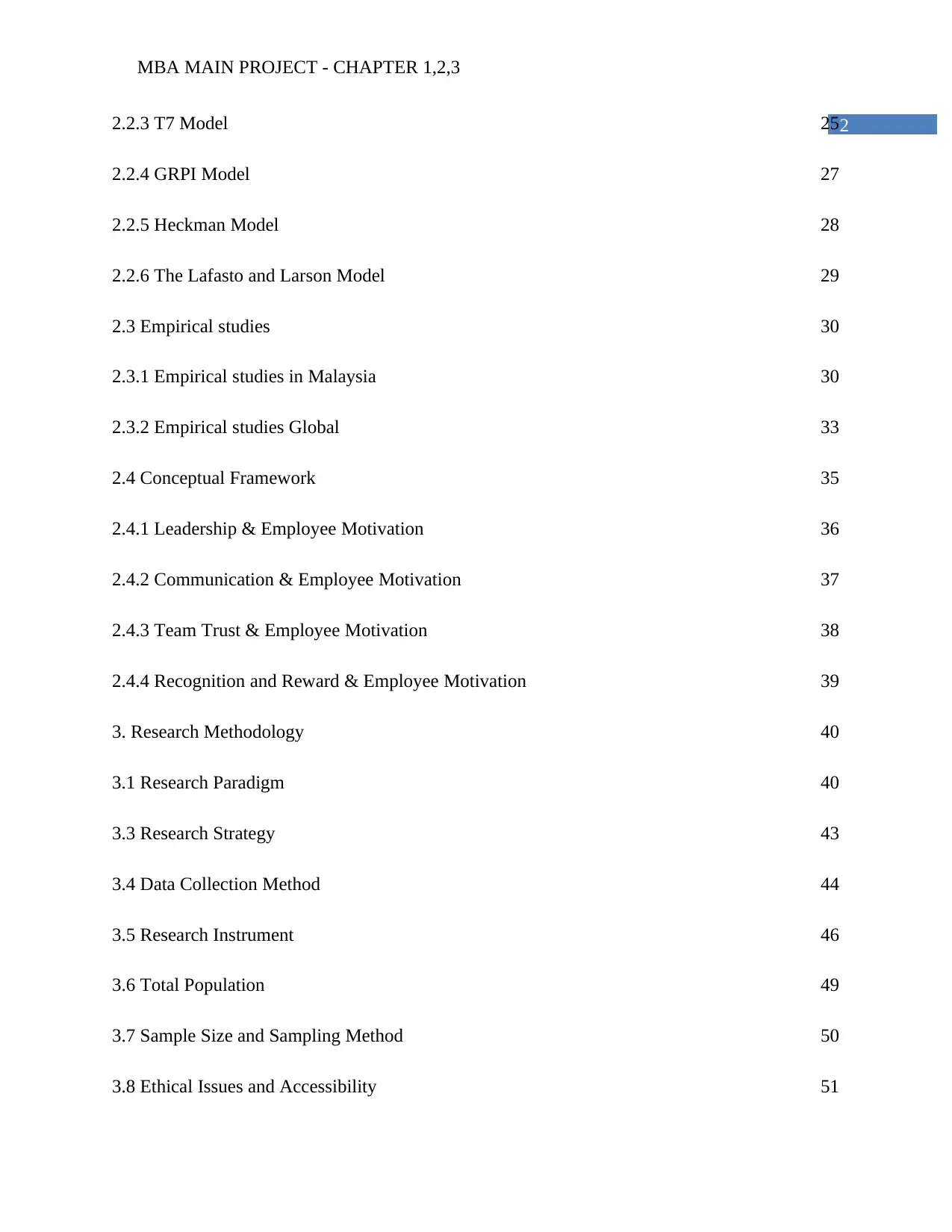
22.2.3 T7 Model 25
2.2.4 GRPI Model 27
2.2.5 Heckman Model 28
2.2.6 The Lafasto and Larson Model 29
2.3 Empirical studies 30
2.3.1 Empirical studies in Malaysia 30
2.3.2 Empirical studies Global 33
2.4 Conceptual Framework 35
2.4.1 Leadership & Employee Motivation 36
2.4.2 Communication & Employee Motivation 37
2.4.3 Team Trust & Employee Motivation 38
2.4.4 Recognition and Reward & Employee Motivation 39
3. Research Methodology 40
3.1 Research Paradigm 40
3.3 Research Strategy 43
3.4 Data Collection Method 44
3.5 Research Instrument 46
3.6 Total Population 49
3.7 Sample Size and Sampling Method 50
3.8 Ethical Issues and Accessibility 51
⊘ This is a preview!⊘
Do you want full access?
Subscribe today to unlock all pages.

Trusted by 1+ million students worldwide
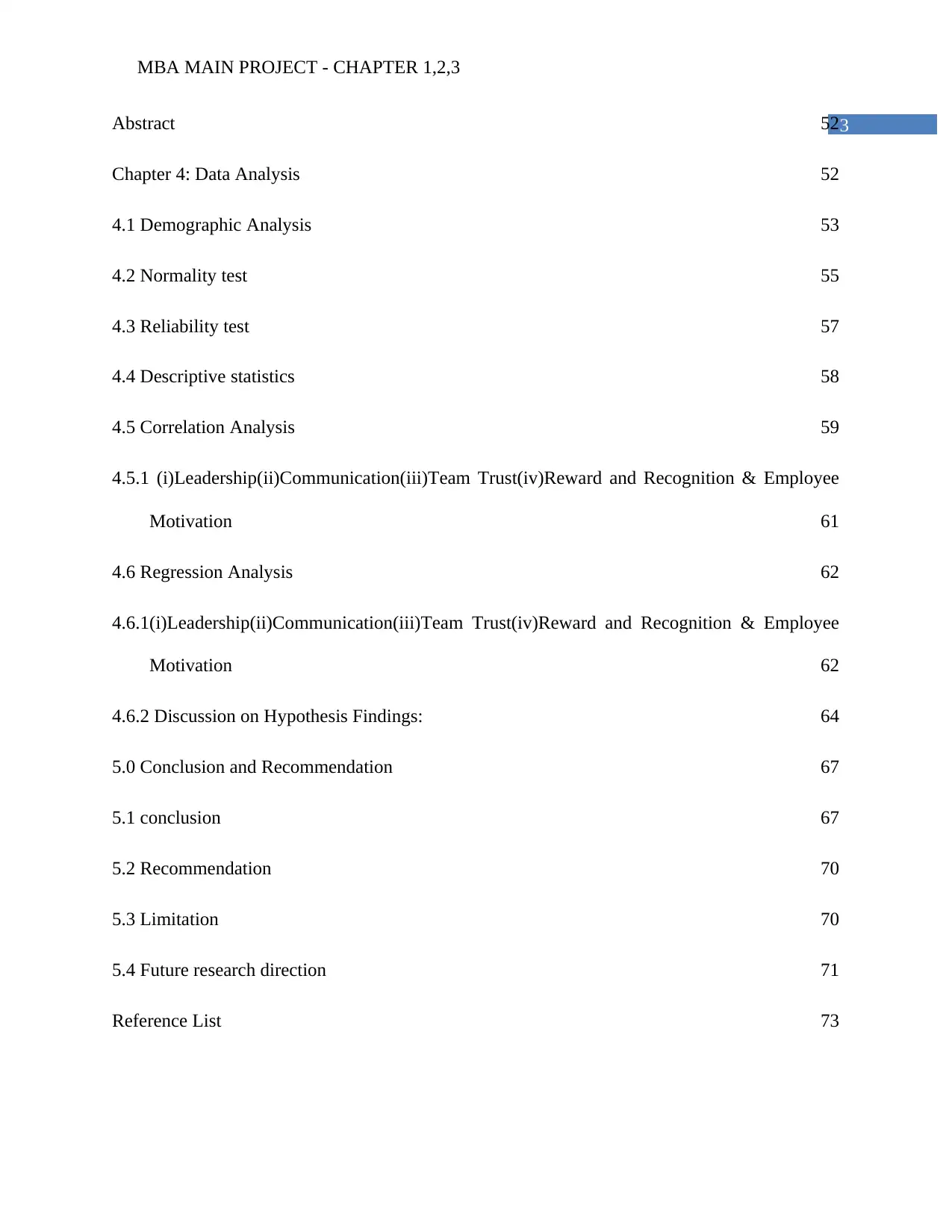
3Abstract 52
Chapter 4: Data Analysis 52
4.1 Demographic Analysis 53
4.2 Normality test 55
4.3 Reliability test 57
4.4 Descriptive statistics 58
4.5 Correlation Analysis 59
4.5.1 (i)Leadership(ii)Communication(iii)Team Trust(iv)Reward and Recognition & Employee
Motivation 61
4.6 Regression Analysis 62
4.6.1(i)Leadership(ii)Communication(iii)Team Trust(iv)Reward and Recognition & Employee
Motivation 62
4.6.2 Discussion on Hypothesis Findings: 64
5.0 Conclusion and Recommendation 67
5.1 conclusion 67
5.2 Recommendation 70
5.3 Limitation 70
5.4 Future research direction 71
Reference List 73
Paraphrase This Document
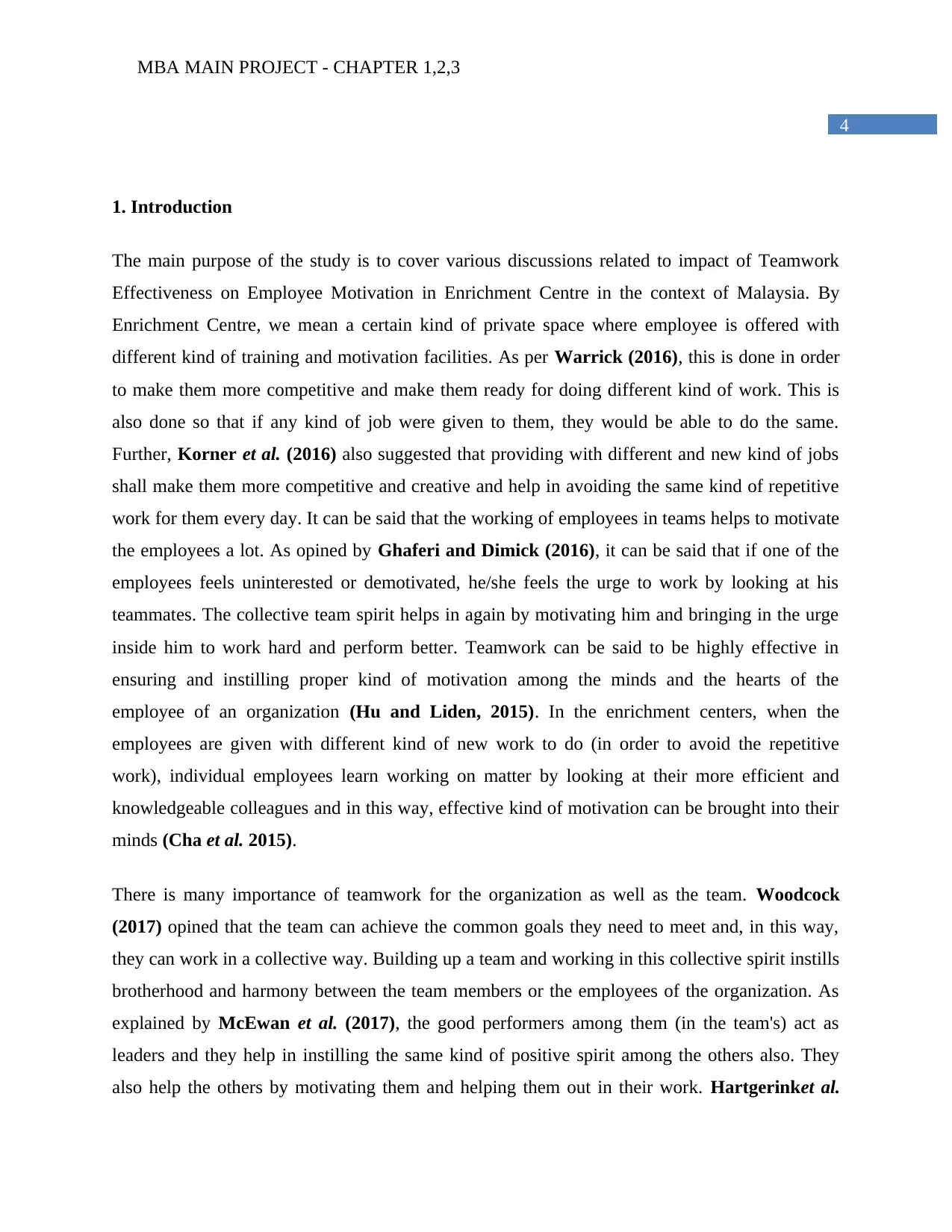
4
1. Introduction
The main purpose of the study is to cover various discussions related to impact of Teamwork
Effectiveness on Employee Motivation in Enrichment Centre in the context of Malaysia. By
Enrichment Centre, we mean a certain kind of private space where employee is offered with
different kind of training and motivation facilities. As per Warrick (2016), this is done in order
to make them more competitive and make them ready for doing different kind of work. This is
also done so that if any kind of job were given to them, they would be able to do the same.
Further, Korner et al. (2016) also suggested that providing with different and new kind of jobs
shall make them more competitive and creative and help in avoiding the same kind of repetitive
work for them every day. It can be said that the working of employees in teams helps to motivate
the employees a lot. As opined by Ghaferi and Dimick (2016), it can be said that if one of the
employees feels uninterested or demotivated, he/she feels the urge to work by looking at his
teammates. The collective team spirit helps in again by motivating him and bringing in the urge
inside him to work hard and perform better. Teamwork can be said to be highly effective in
ensuring and instilling proper kind of motivation among the minds and the hearts of the
employee of an organization (Hu and Liden, 2015). In the enrichment centers, when the
employees are given with different kind of new work to do (in order to avoid the repetitive
work), individual employees learn working on matter by looking at their more efficient and
knowledgeable colleagues and in this way, effective kind of motivation can be brought into their
minds (Cha et al. 2015).
There is many importance of teamwork for the organization as well as the team. Woodcock
(2017) opined that the team can achieve the common goals they need to meet and, in this way,
they can work in a collective way. Building up a team and working in this collective spirit instills
brotherhood and harmony between the team members or the employees of the organization. As
explained by McEwan et al. (2017), the good performers among them (in the team's) act as
leaders and they help in instilling the same kind of positive spirit among the others also. They
also help the others by motivating them and helping them out in their work. Hartgerinket al.
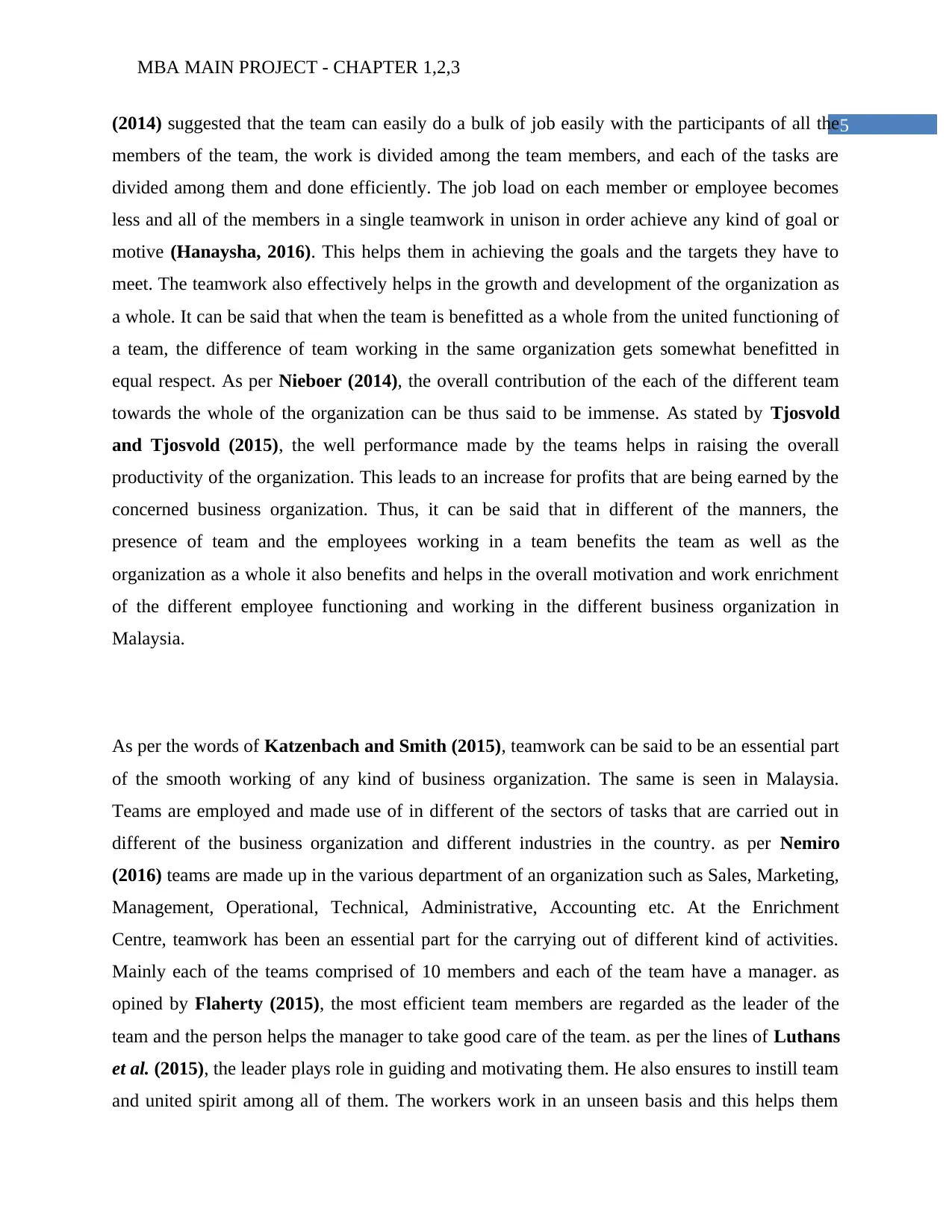
5(2014) suggested that the team can easily do a bulk of job easily with the participants of all the
members of the team, the work is divided among the team members, and each of the tasks are
divided among them and done efficiently. The job load on each member or employee becomes
less and all of the members in a single teamwork in unison in order achieve any kind of goal or
motive (Hanaysha, 2016). This helps them in achieving the goals and the targets they have to
meet. The teamwork also effectively helps in the growth and development of the organization as
a whole. It can be said that when the team is benefitted as a whole from the united functioning of
a team, the difference of team working in the same organization gets somewhat benefitted in
equal respect. As per Nieboer (2014), the overall contribution of the each of the different team
towards the whole of the organization can be thus said to be immense. As stated by Tjosvold
and Tjosvold (2015), the well performance made by the teams helps in raising the overall
productivity of the organization. This leads to an increase for profits that are being earned by the
concerned business organization. Thus, it can be said that in different of the manners, the
presence of team and the employees working in a team benefits the team as well as the
organization as a whole it also benefits and helps in the overall motivation and work enrichment
of the different employee functioning and working in the different business organization in
Malaysia.
As per the words of Katzenbach and Smith (2015), teamwork can be said to be an essential part
of the smooth working of any kind of business organization. The same is seen in Malaysia.
Teams are employed and made use of in different of the sectors of tasks that are carried out in
different of the business organization and different industries in the country. as per Nemiro
(2016) teams are made up in the various department of an organization such as Sales, Marketing,
Management, Operational, Technical, Administrative, Accounting etc. At the Enrichment
Centre, teamwork has been an essential part for the carrying out of different kind of activities.
Mainly each of the teams comprised of 10 members and each of the team have a manager. as
opined by Flaherty (2015), the most efficient team members are regarded as the leader of the
team and the person helps the manager to take good care of the team. as per the lines of Luthans
et al. (2015), the leader plays role in guiding and motivating them. He also ensures to instill team
and united spirit among all of them. The workers work in an unseen basis and this helps them
⊘ This is a preview!⊘
Do you want full access?
Subscribe today to unlock all pages.

Trusted by 1+ million students worldwide
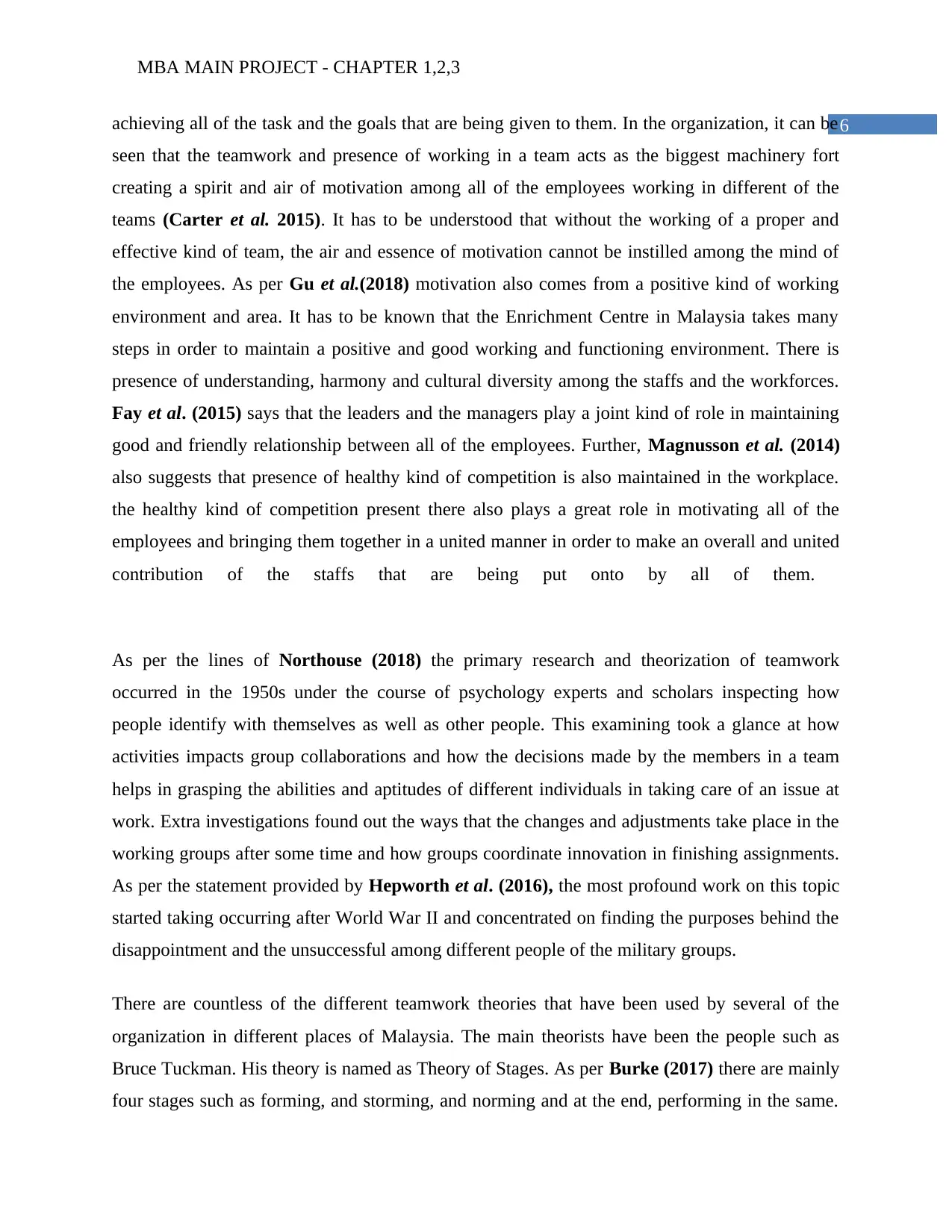
6achieving all of the task and the goals that are being given to them. In the organization, it can be
seen that the teamwork and presence of working in a team acts as the biggest machinery fort
creating a spirit and air of motivation among all of the employees working in different of the
teams (Carter et al. 2015). It has to be understood that without the working of a proper and
effective kind of team, the air and essence of motivation cannot be instilled among the mind of
the employees. As per Gu et al.(2018) motivation also comes from a positive kind of working
environment and area. It has to be known that the Enrichment Centre in Malaysia takes many
steps in order to maintain a positive and good working and functioning environment. There is
presence of understanding, harmony and cultural diversity among the staffs and the workforces.
Fay et al. (2015) says that the leaders and the managers play a joint kind of role in maintaining
good and friendly relationship between all of the employees. Further, Magnusson et al. (2014)
also suggests that presence of healthy kind of competition is also maintained in the workplace.
the healthy kind of competition present there also plays a great role in motivating all of the
employees and bringing them together in a united manner in order to make an overall and united
contribution of the staffs that are being put onto by all of them.
As per the lines of Northouse (2018) the primary research and theorization of teamwork
occurred in the 1950s under the course of psychology experts and scholars inspecting how
people identify with themselves as well as other people. This examining took a glance at how
activities impacts group collaborations and how the decisions made by the members in a team
helps in grasping the abilities and aptitudes of different individuals in taking care of an issue at
work. Extra investigations found out the ways that the changes and adjustments take place in the
working groups after some time and how groups coordinate innovation in finishing assignments.
As per the statement provided by Hepworth et al. (2016), the most profound work on this topic
started taking occurring after World War II and concentrated on finding the purposes behind the
disappointment and the unsuccessful among different people of the military groups.
There are countless of the different teamwork theories that have been used by several of the
organization in different places of Malaysia. The main theorists have been the people such as
Bruce Tuckman. His theory is named as Theory of Stages. As per Burke (2017) there are mainly
four stages such as forming, and storming, and norming and at the end, performing in the same.
Paraphrase This Document
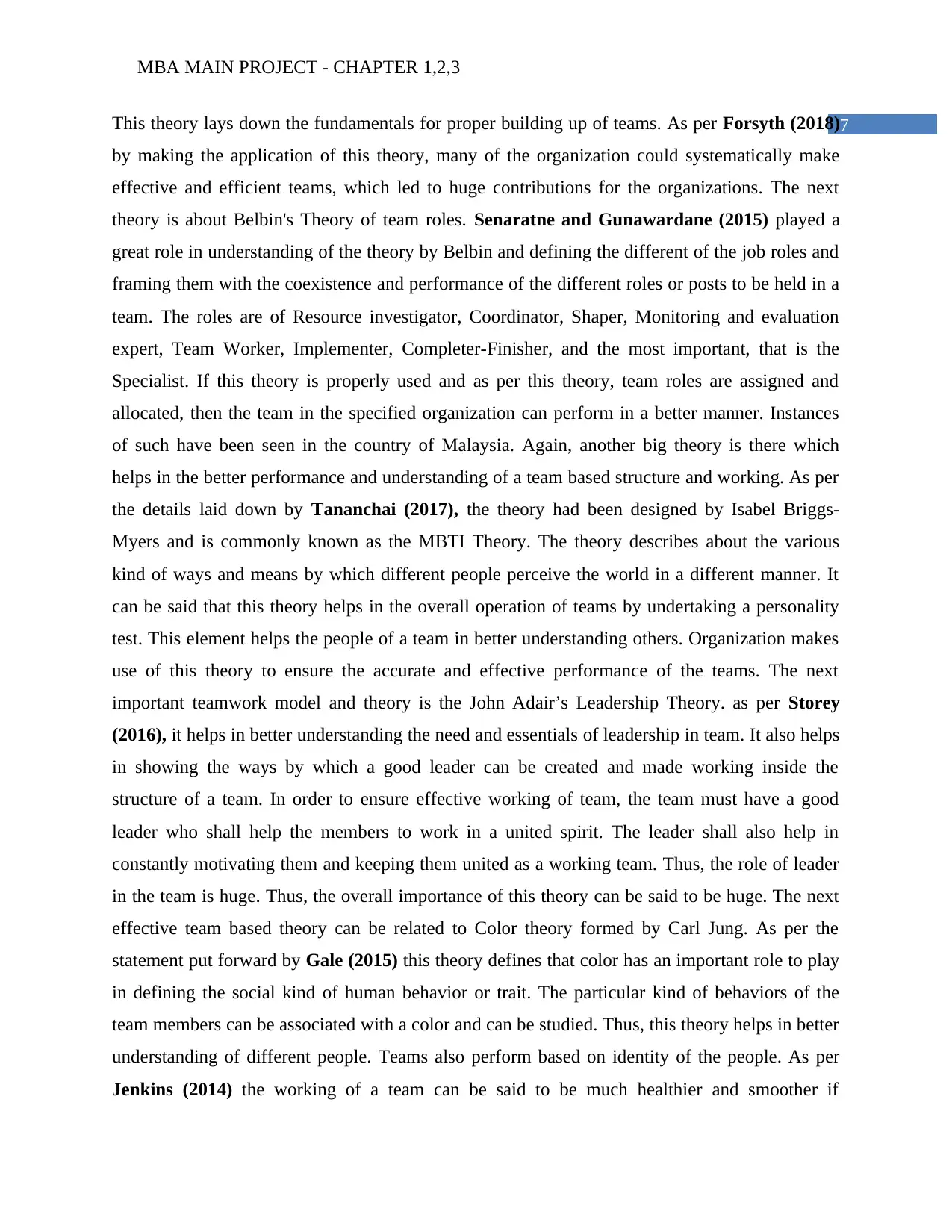
7This theory lays down the fundamentals for proper building up of teams. As per Forsyth (2018)
by making the application of this theory, many of the organization could systematically make
effective and efficient teams, which led to huge contributions for the organizations. The next
theory is about Belbin's Theory of team roles. Senaratne and Gunawardane (2015) played a
great role in understanding of the theory by Belbin and defining the different of the job roles and
framing them with the coexistence and performance of the different roles or posts to be held in a
team. The roles are of Resource investigator, Coordinator, Shaper, Monitoring and evaluation
expert, Team Worker, Implementer, Completer-Finisher, and the most important, that is the
Specialist. If this theory is properly used and as per this theory, team roles are assigned and
allocated, then the team in the specified organization can perform in a better manner. Instances
of such have been seen in the country of Malaysia. Again, another big theory is there which
helps in the better performance and understanding of a team based structure and working. As per
the details laid down by Tananchai (2017), the theory had been designed by Isabel Briggs-
Myers and is commonly known as the MBTI Theory. The theory describes about the various
kind of ways and means by which different people perceive the world in a different manner. It
can be said that this theory helps in the overall operation of teams by undertaking a personality
test. This element helps the people of a team in better understanding others. Organization makes
use of this theory to ensure the accurate and effective performance of the teams. The next
important teamwork model and theory is the John Adair’s Leadership Theory. as per Storey
(2016), it helps in better understanding the need and essentials of leadership in team. It also helps
in showing the ways by which a good leader can be created and made working inside the
structure of a team. In order to ensure effective working of team, the team must have a good
leader who shall help the members to work in a united spirit. The leader shall also help in
constantly motivating them and keeping them united as a working team. Thus, the role of leader
in the team is huge. Thus, the overall importance of this theory can be said to be huge. The next
effective team based theory can be related to Color theory formed by Carl Jung. As per the
statement put forward by Gale (2015) this theory defines that color has an important role to play
in defining the social kind of human behavior or trait. The particular kind of behaviors of the
team members can be associated with a color and can be studied. Thus, this theory helps in better
understanding of different people. Teams also perform based on identity of the people. As per
Jenkins (2014) the working of a team can be said to be much healthier and smoother if
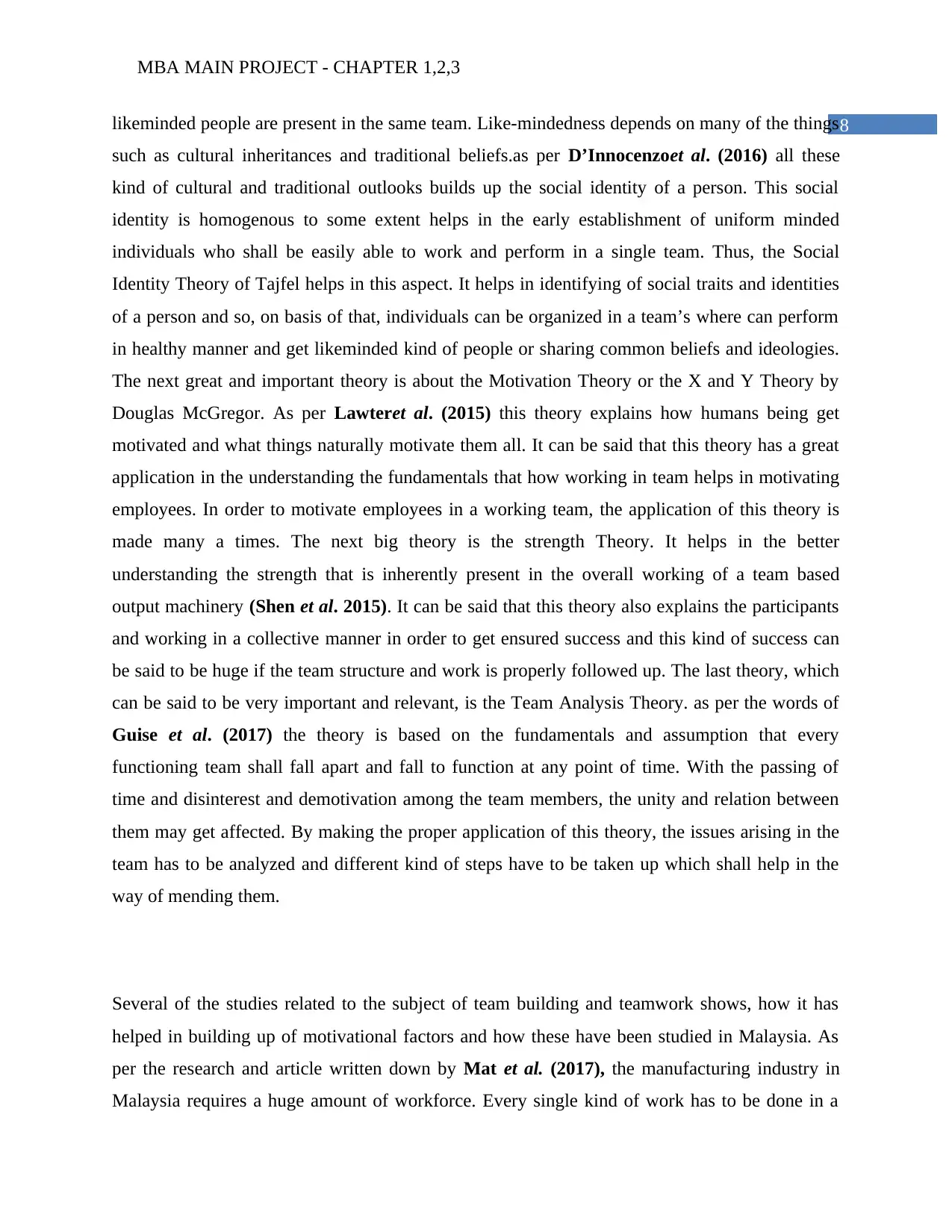
8likeminded people are present in the same team. Like-mindedness depends on many of the things
such as cultural inheritances and traditional beliefs.as per D’Innocenzoet al. (2016) all these
kind of cultural and traditional outlooks builds up the social identity of a person. This social
identity is homogenous to some extent helps in the early establishment of uniform minded
individuals who shall be easily able to work and perform in a single team. Thus, the Social
Identity Theory of Tajfel helps in this aspect. It helps in identifying of social traits and identities
of a person and so, on basis of that, individuals can be organized in a team’s where can perform
in healthy manner and get likeminded kind of people or sharing common beliefs and ideologies.
The next great and important theory is about the Motivation Theory or the X and Y Theory by
Douglas McGregor. As per Lawteret al. (2015) this theory explains how humans being get
motivated and what things naturally motivate them all. It can be said that this theory has a great
application in the understanding the fundamentals that how working in team helps in motivating
employees. In order to motivate employees in a working team, the application of this theory is
made many a times. The next big theory is the strength Theory. It helps in the better
understanding the strength that is inherently present in the overall working of a team based
output machinery (Shen et al. 2015). It can be said that this theory also explains the participants
and working in a collective manner in order to get ensured success and this kind of success can
be said to be huge if the team structure and work is properly followed up. The last theory, which
can be said to be very important and relevant, is the Team Analysis Theory. as per the words of
Guise et al. (2017) the theory is based on the fundamentals and assumption that every
functioning team shall fall apart and fall to function at any point of time. With the passing of
time and disinterest and demotivation among the team members, the unity and relation between
them may get affected. By making the proper application of this theory, the issues arising in the
team has to be analyzed and different kind of steps have to be taken up which shall help in the
way of mending them.
Several of the studies related to the subject of team building and teamwork shows, how it has
helped in building up of motivational factors and how these have been studied in Malaysia. As
per the research and article written down by Mat et al. (2017), the manufacturing industry in
Malaysia requires a huge amount of workforce. Every single kind of work has to be done in a
⊘ This is a preview!⊘
Do you want full access?
Subscribe today to unlock all pages.

Trusted by 1+ million students worldwide
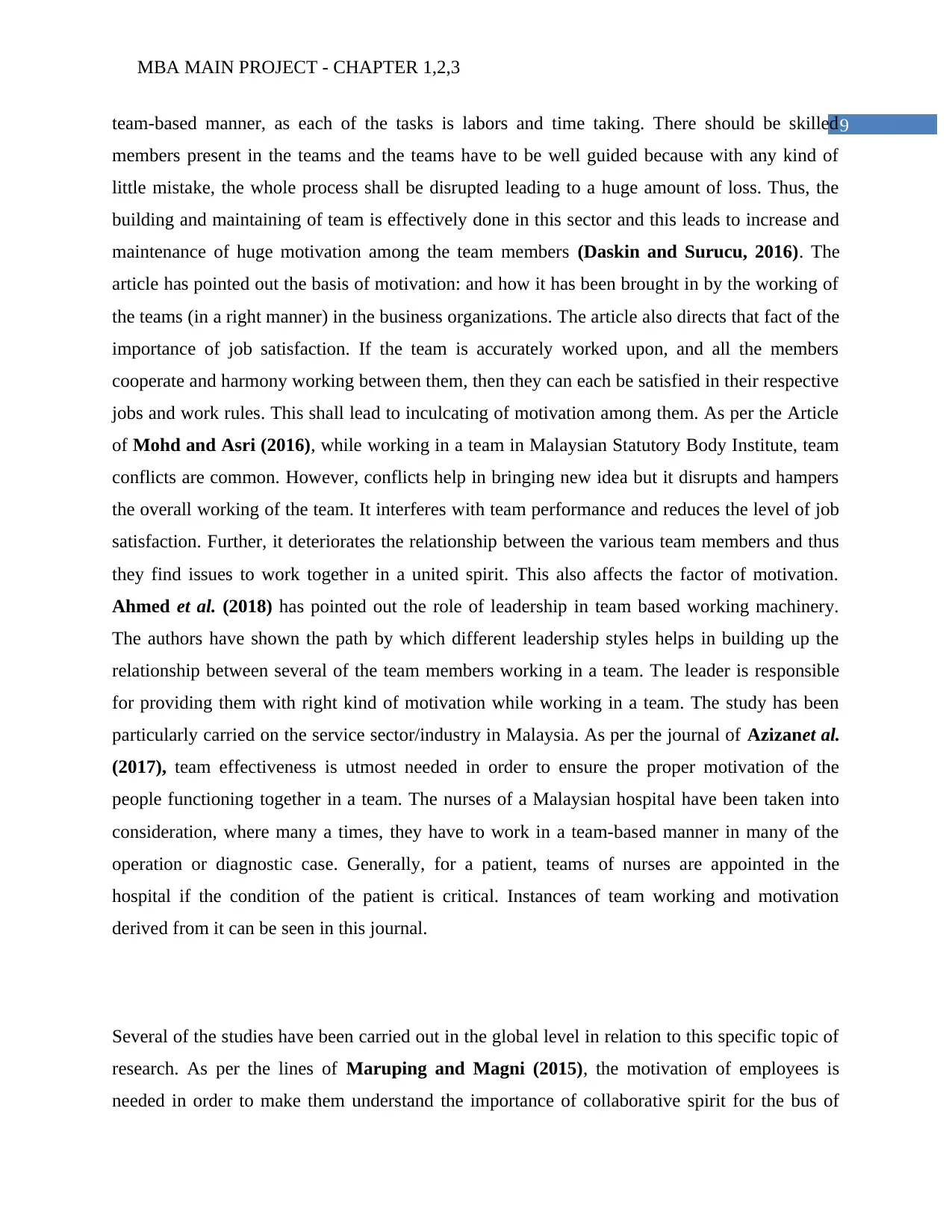
9team-based manner, as each of the tasks is labors and time taking. There should be skilled
members present in the teams and the teams have to be well guided because with any kind of
little mistake, the whole process shall be disrupted leading to a huge amount of loss. Thus, the
building and maintaining of team is effectively done in this sector and this leads to increase and
maintenance of huge motivation among the team members (Daskin and Surucu, 2016). The
article has pointed out the basis of motivation: and how it has been brought in by the working of
the teams (in a right manner) in the business organizations. The article also directs that fact of the
importance of job satisfaction. If the team is accurately worked upon, and all the members
cooperate and harmony working between them, then they can each be satisfied in their respective
jobs and work rules. This shall lead to inculcating of motivation among them. As per the Article
of Mohd and Asri (2016), while working in a team in Malaysian Statutory Body Institute, team
conflicts are common. However, conflicts help in bringing new idea but it disrupts and hampers
the overall working of the team. It interferes with team performance and reduces the level of job
satisfaction. Further, it deteriorates the relationship between the various team members and thus
they find issues to work together in a united spirit. This also affects the factor of motivation.
Ahmed et al. (2018) has pointed out the role of leadership in team based working machinery.
The authors have shown the path by which different leadership styles helps in building up the
relationship between several of the team members working in a team. The leader is responsible
for providing them with right kind of motivation while working in a team. The study has been
particularly carried on the service sector/industry in Malaysia. As per the journal of Azizanet al.
(2017), team effectiveness is utmost needed in order to ensure the proper motivation of the
people functioning together in a team. The nurses of a Malaysian hospital have been taken into
consideration, where many a times, they have to work in a team-based manner in many of the
operation or diagnostic case. Generally, for a patient, teams of nurses are appointed in the
hospital if the condition of the patient is critical. Instances of team working and motivation
derived from it can be seen in this journal.
Several of the studies have been carried out in the global level in relation to this specific topic of
research. As per the lines of Maruping and Magni (2015), the motivation of employees is
needed in order to make them understand the importance of collaborative spirit for the bus of
Paraphrase This Document
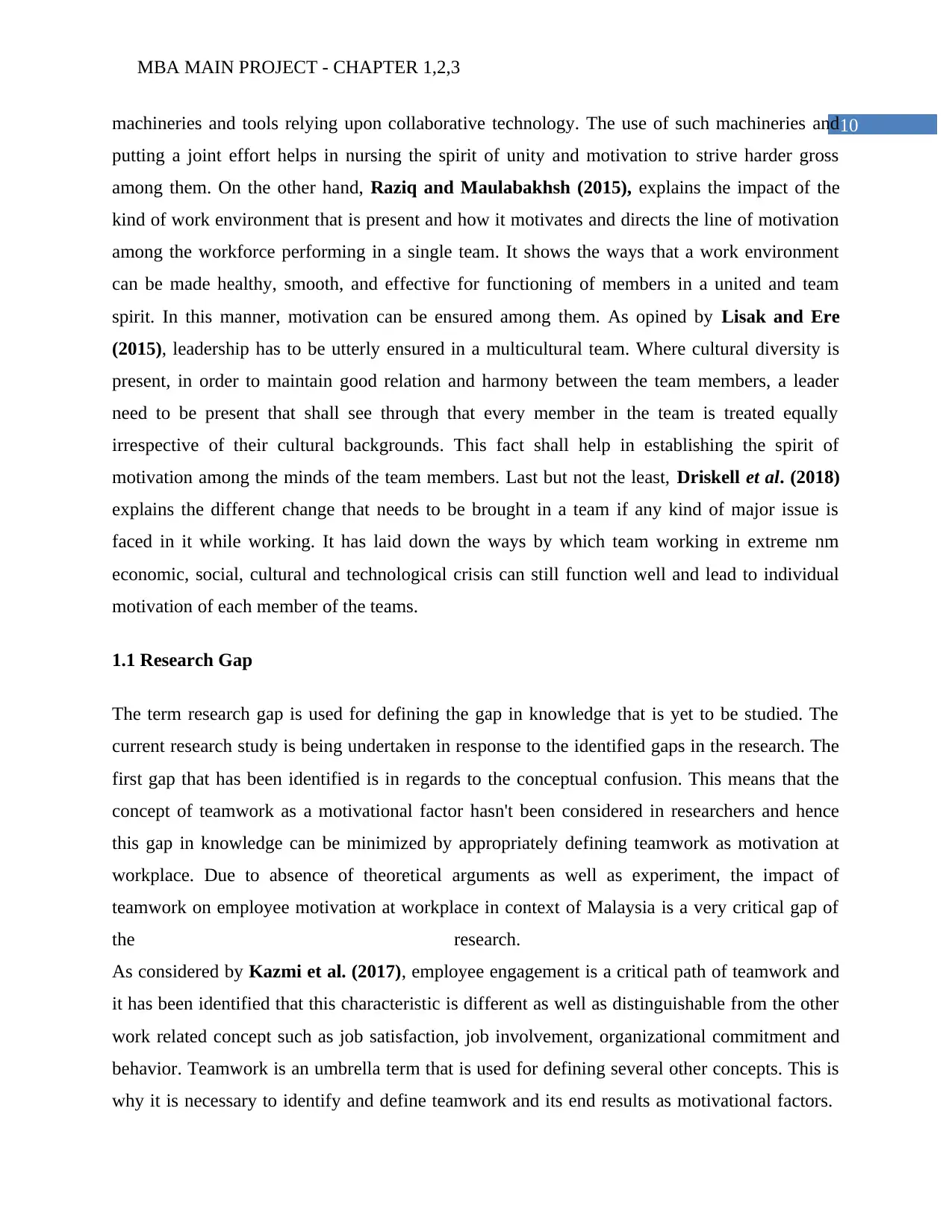
10machineries and tools relying upon collaborative technology. The use of such machineries and
putting a joint effort helps in nursing the spirit of unity and motivation to strive harder gross
among them. On the other hand, Raziq and Maulabakhsh (2015), explains the impact of the
kind of work environment that is present and how it motivates and directs the line of motivation
among the workforce performing in a single team. It shows the ways that a work environment
can be made healthy, smooth, and effective for functioning of members in a united and team
spirit. In this manner, motivation can be ensured among them. As opined by Lisak and Ere
(2015), leadership has to be utterly ensured in a multicultural team. Where cultural diversity is
present, in order to maintain good relation and harmony between the team members, a leader
need to be present that shall see through that every member in the team is treated equally
irrespective of their cultural backgrounds. This fact shall help in establishing the spirit of
motivation among the minds of the team members. Last but not the least, Driskell et al. (2018)
explains the different change that needs to be brought in a team if any kind of major issue is
faced in it while working. It has laid down the ways by which team working in extreme nm
economic, social, cultural and technological crisis can still function well and lead to individual
motivation of each member of the teams.
1.1 Research Gap
The term research gap is used for defining the gap in knowledge that is yet to be studied. The
current research study is being undertaken in response to the identified gaps in the research. The
first gap that has been identified is in regards to the conceptual confusion. This means that the
concept of teamwork as a motivational factor hasn't been considered in researchers and hence
this gap in knowledge can be minimized by appropriately defining teamwork as motivation at
workplace. Due to absence of theoretical arguments as well as experiment, the impact of
teamwork on employee motivation at workplace in context of Malaysia is a very critical gap of
the research.
As considered by Kazmi et al. (2017), employee engagement is a critical path of teamwork and
it has been identified that this characteristic is different as well as distinguishable from the other
work related concept such as job satisfaction, job involvement, organizational commitment and
behavior. Teamwork is an umbrella term that is used for defining several other concepts. This is
why it is necessary to identify and define teamwork and its end results as motivational factors.
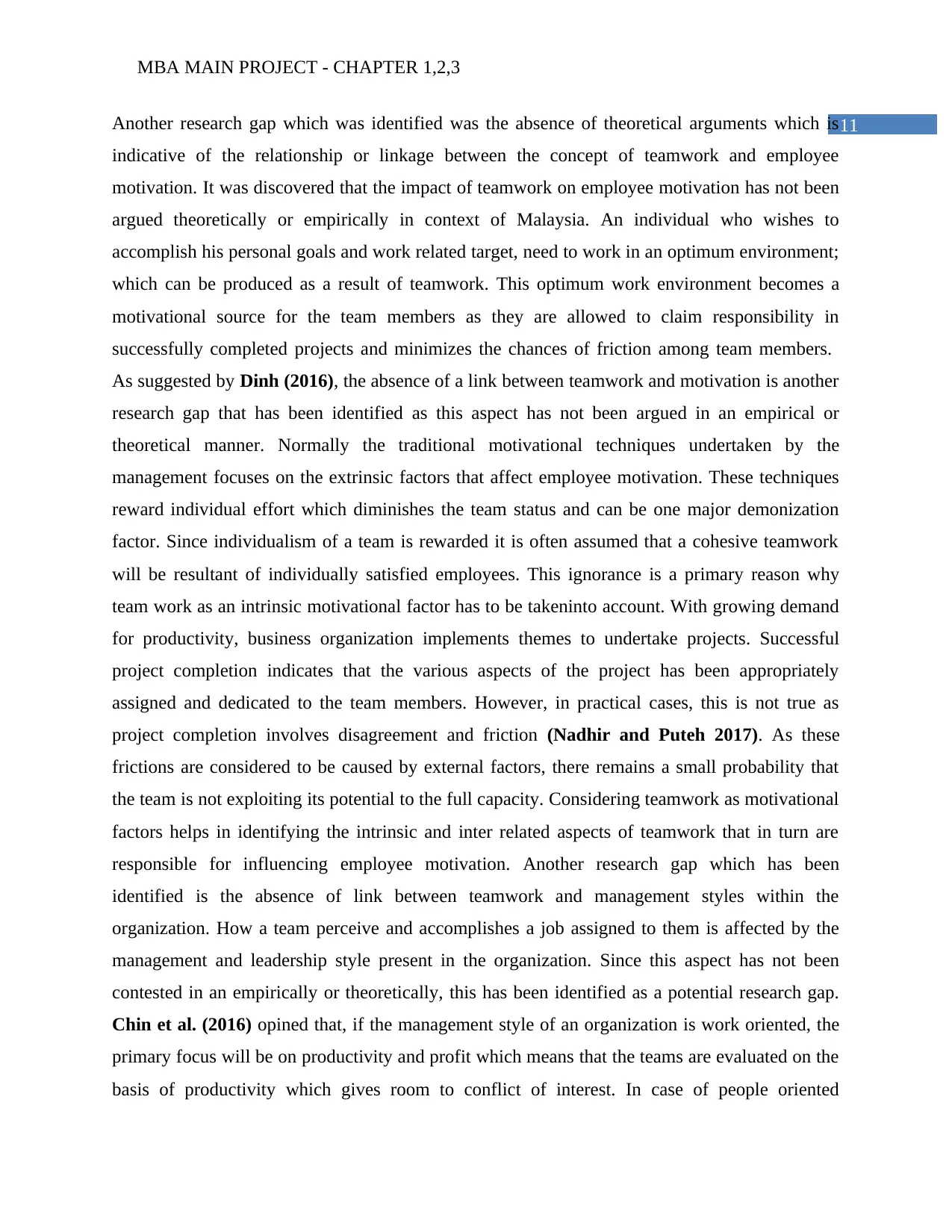
11Another research gap which was identified was the absence of theoretical arguments which is
indicative of the relationship or linkage between the concept of teamwork and employee
motivation. It was discovered that the impact of teamwork on employee motivation has not been
argued theoretically or empirically in context of Malaysia. An individual who wishes to
accomplish his personal goals and work related target, need to work in an optimum environment;
which can be produced as a result of teamwork. This optimum work environment becomes a
motivational source for the team members as they are allowed to claim responsibility in
successfully completed projects and minimizes the chances of friction among team members.
As suggested by Dinh (2016), the absence of a link between teamwork and motivation is another
research gap that has been identified as this aspect has not been argued in an empirical or
theoretical manner. Normally the traditional motivational techniques undertaken by the
management focuses on the extrinsic factors that affect employee motivation. These techniques
reward individual effort which diminishes the team status and can be one major demonization
factor. Since individualism of a team is rewarded it is often assumed that a cohesive teamwork
will be resultant of individually satisfied employees. This ignorance is a primary reason why
team work as an intrinsic motivational factor has to be takeninto account. With growing demand
for productivity, business organization implements themes to undertake projects. Successful
project completion indicates that the various aspects of the project has been appropriately
assigned and dedicated to the team members. However, in practical cases, this is not true as
project completion involves disagreement and friction (Nadhir and Puteh 2017). As these
frictions are considered to be caused by external factors, there remains a small probability that
the team is not exploiting its potential to the full capacity. Considering teamwork as motivational
factors helps in identifying the intrinsic and inter related aspects of teamwork that in turn are
responsible for influencing employee motivation. Another research gap which has been
identified is the absence of link between teamwork and management styles within the
organization. How a team perceive and accomplishes a job assigned to them is affected by the
management and leadership style present in the organization. Since this aspect has not been
contested in an empirically or theoretically, this has been identified as a potential research gap.
Chin et al. (2016) opined that, if the management style of an organization is work oriented, the
primary focus will be on productivity and profit which means that the teams are evaluated on the
basis of productivity which gives room to conflict of interest. In case of people oriented
⊘ This is a preview!⊘
Do you want full access?
Subscribe today to unlock all pages.

Trusted by 1+ million students worldwide

12management style,the primary focus will be on team development and team building with
secondary importance to productivity. The research gaps that have been identified will help in
setting up the research objectives and questions in context of the aim of the research. As
supported by Garg and Punia (2017), gap identification is necessary as it will provide the
researcher with a idea of the various concepts and theories that are needed to be studied in depth.
These research gaps will be filled in a systematic and scientific manner in which will help in
contributing to the existing knowledge of teamwork and employee motivation at workplace.
1.2 Research Rationale
The current research study focuses on understanding the implication of teamwork on the
motivation of employees in Malaysia. Pangil and Moi Chan (2014) in their article presented
that, employee motivation generally refers to the commitment, creativity, energy as well as
loyalty that employees bring to workplace. Irrespective of the market and economic conditions,
the administrative units of business organizations need to identify ways in which the employee
can be motivated. A highly motivated group of individuals can work together efficiently as a
team. The current research looks to justify that the reverse is also true that is teamwork can be
responsible for affecting the motivational levels in the employees. It has been observed that
companies and businesses employing individuals having low motivation tend to become
susceptible to a number of problems and challenges (Argote and Guo 2016).
Apart from the traditional motivators used by industries, it would be a good idea to examine
whether teamwork can induce similar levels of motivation among the workforce. The
individualism of employees is often rewarded by incentives, perks and benefits. However, as
argued by Raziq and Maulabakhsh (2015), this appreciation of individuality makes the
company or business susceptible to pitfalls. The company needs to work together as a team and
hence it is necessary to test the hypothesis whether good teamwork functions in similar manner
as that of the traditional motivators. The main issue is that employee satisfaction in Malaysia is
dipping and rising cost of operations has made it difficult to provide each individual with
incentive.
Paraphrase This Document
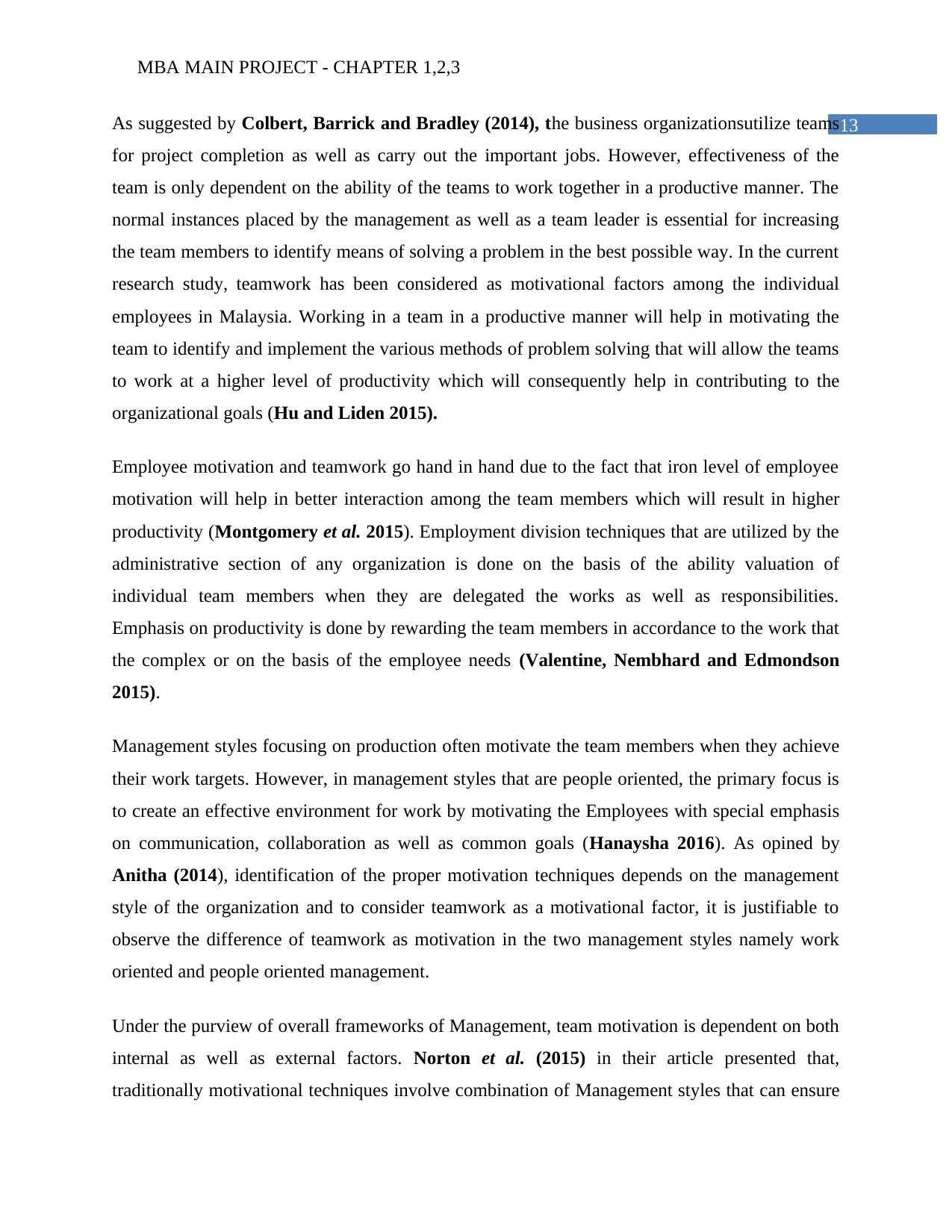
13As suggested by Colbert, Barrick and Bradley (2014), the business organizationsutilize teams
for project completion as well as carry out the important jobs. However, effectiveness of the
team is only dependent on the ability of the teams to work together in a productive manner. The
normal instances placed by the management as well as a team leader is essential for increasing
the team members to identify means of solving a problem in the best possible way. In the current
research study, teamwork has been considered as motivational factors among the individual
employees in Malaysia. Working in a team in a productive manner will help in motivating the
team to identify and implement the various methods of problem solving that will allow the teams
to work at a higher level of productivity which will consequently help in contributing to the
organizational goals (Hu and Liden 2015).
Employee motivation and teamwork go hand in hand due to the fact that iron level of employee
motivation will help in better interaction among the team members which will result in higher
productivity (Montgomery et al. 2015). Employment division techniques that are utilized by the
administrative section of any organization is done on the basis of the ability valuation of
individual team members when they are delegated the works as well as responsibilities.
Emphasis on productivity is done by rewarding the team members in accordance to the work that
the complex or on the basis of the employee needs (Valentine, Nembhard and Edmondson
2015).
Management styles focusing on production often motivate the team members when they achieve
their work targets. However, in management styles that are people oriented, the primary focus is
to create an effective environment for work by motivating the Employees with special emphasis
on communication, collaboration as well as common goals (Hanaysha 2016). As opined by
Anitha (2014), identification of the proper motivation techniques depends on the management
style of the organization and to consider teamwork as a motivational factor, it is justifiable to
observe the difference of teamwork as motivation in the two management styles namely work
oriented and people oriented management.
Under the purview of overall frameworks of Management, team motivation is dependent on both
internal as well as external factors. Norton et al. (2015) in their article presented that,
traditionally motivational techniques involve combination of Management styles that can ensure
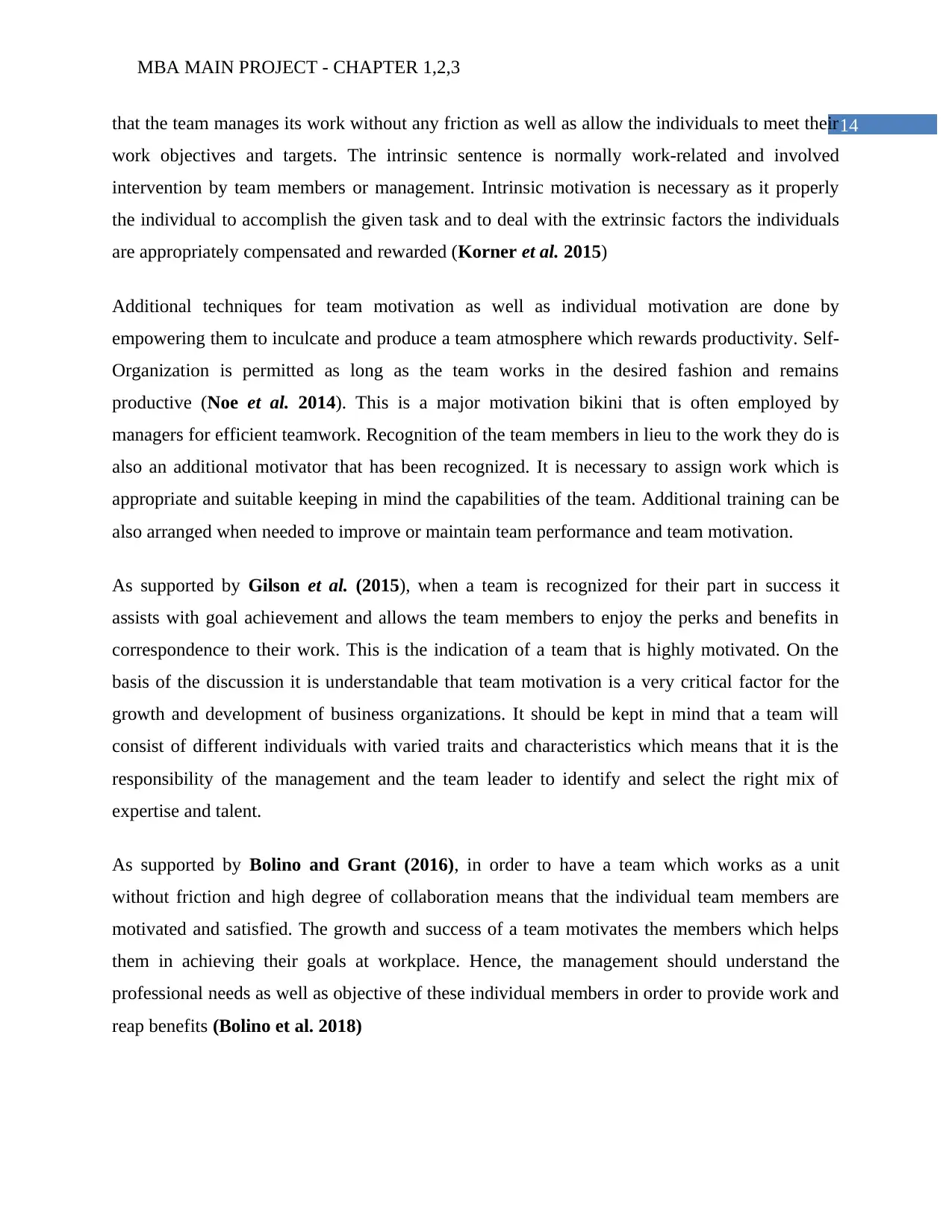
14that the team manages its work without any friction as well as allow the individuals to meet their
work objectives and targets. The intrinsic sentence is normally work-related and involved
intervention by team members or management. Intrinsic motivation is necessary as it properly
the individual to accomplish the given task and to deal with the extrinsic factors the individuals
are appropriately compensated and rewarded (Korner et al. 2015)
Additional techniques for team motivation as well as individual motivation are done by
empowering them to inculcate and produce a team atmosphere which rewards productivity. Self-
Organization is permitted as long as the team works in the desired fashion and remains
productive (Noe et al. 2014). This is a major motivation bikini that is often employed by
managers for efficient teamwork. Recognition of the team members in lieu to the work they do is
also an additional motivator that has been recognized. It is necessary to assign work which is
appropriate and suitable keeping in mind the capabilities of the team. Additional training can be
also arranged when needed to improve or maintain team performance and team motivation.
As supported by Gilson et al. (2015), when a team is recognized for their part in success it
assists with goal achievement and allows the team members to enjoy the perks and benefits in
correspondence to their work. This is the indication of a team that is highly motivated. On the
basis of the discussion it is understandable that team motivation is a very critical factor for the
growth and development of business organizations. It should be kept in mind that a team will
consist of different individuals with varied traits and characteristics which means that it is the
responsibility of the management and the team leader to identify and select the right mix of
expertise and talent.
As supported by Bolino and Grant (2016), in order to have a team which works as a unit
without friction and high degree of collaboration means that the individual team members are
motivated and satisfied. The growth and success of a team motivates the members which helps
them in achieving their goals at workplace. Hence, the management should understand the
professional needs as well as objective of these individual members in order to provide work and
reap benefits (Bolino et al. 2018)
⊘ This is a preview!⊘
Do you want full access?
Subscribe today to unlock all pages.

Trusted by 1+ million students worldwide
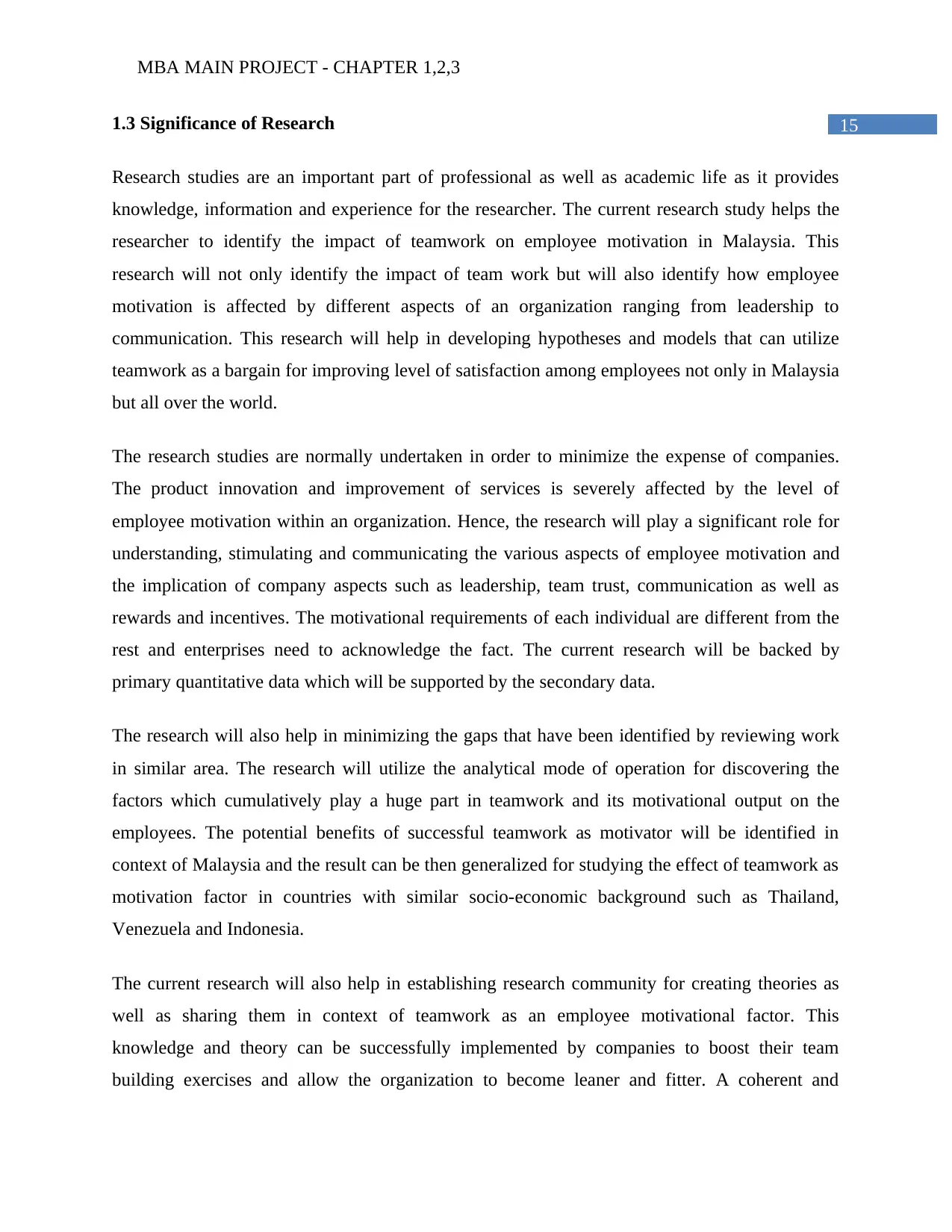
151.3 Significance of Research
Research studies are an important part of professional as well as academic life as it provides
knowledge, information and experience for the researcher. The current research study helps the
researcher to identify the impact of teamwork on employee motivation in Malaysia. This
research will not only identify the impact of team work but will also identify how employee
motivation is affected by different aspects of an organization ranging from leadership to
communication. This research will help in developing hypotheses and models that can utilize
teamwork as a bargain for improving level of satisfaction among employees not only in Malaysia
but all over the world.
The research studies are normally undertaken in order to minimize the expense of companies.
The product innovation and improvement of services is severely affected by the level of
employee motivation within an organization. Hence, the research will play a significant role for
understanding, stimulating and communicating the various aspects of employee motivation and
the implication of company aspects such as leadership, team trust, communication as well as
rewards and incentives. The motivational requirements of each individual are different from the
rest and enterprises need to acknowledge the fact. The current research will be backed by
primary quantitative data which will be supported by the secondary data.
The research will also help in minimizing the gaps that have been identified by reviewing work
in similar area. The research will utilize the analytical mode of operation for discovering the
factors which cumulatively play a huge part in teamwork and its motivational output on the
employees. The potential benefits of successful teamwork as motivator will be identified in
context of Malaysia and the result can be then generalized for studying the effect of teamwork as
motivation factor in countries with similar socio-economic background such as Thailand,
Venezuela and Indonesia.
The current research will also help in establishing research community for creating theories as
well as sharing them in context of teamwork as an employee motivational factor. This
knowledge and theory can be successfully implemented by companies to boost their team
building exercises and allow the organization to become leaner and fitter. A coherent and
Paraphrase This Document
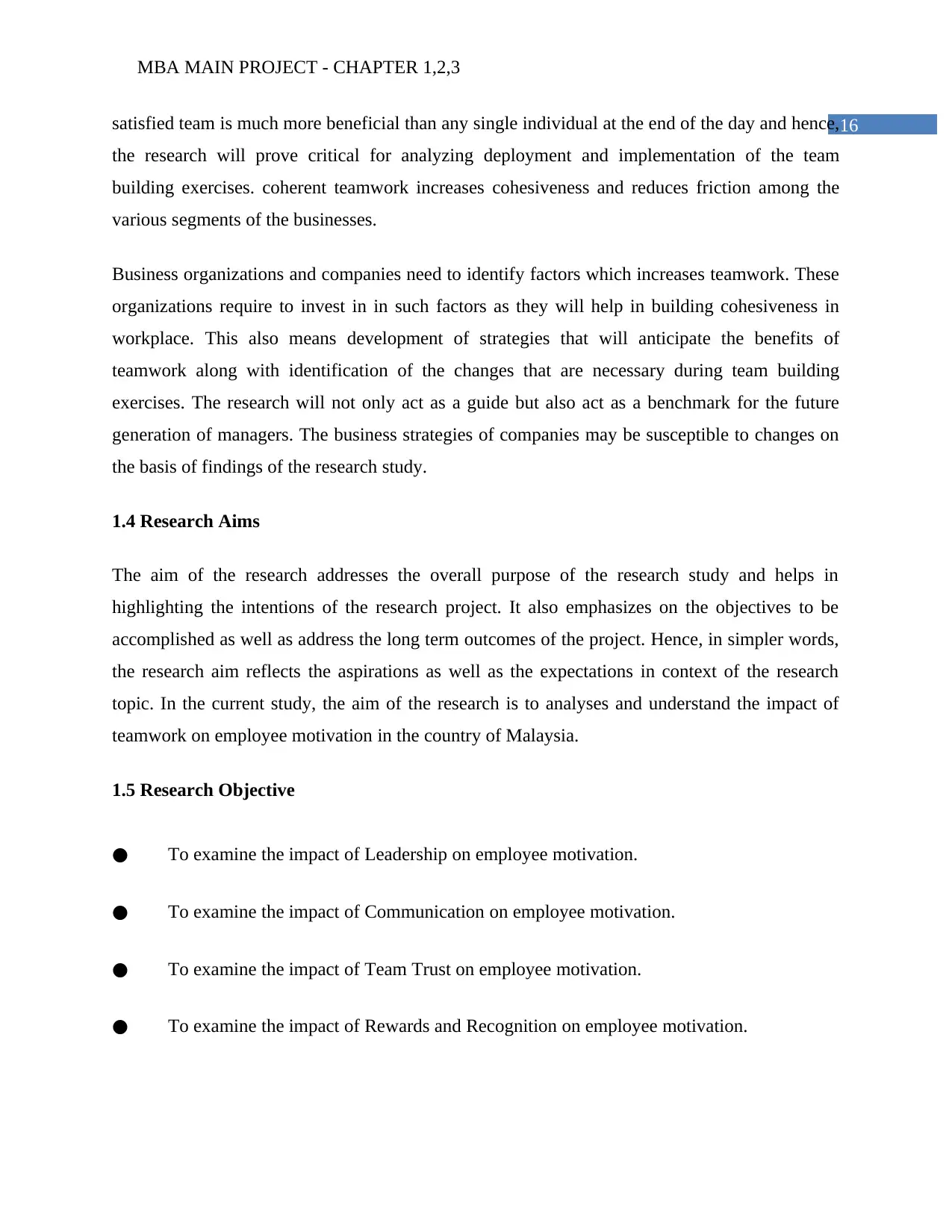
16satisfied team is much more beneficial than any single individual at the end of the day and hence,
the research will prove critical for analyzing deployment and implementation of the team
building exercises. coherent teamwork increases cohesiveness and reduces friction among the
various segments of the businesses.
Business organizations and companies need to identify factors which increases teamwork. These
organizations require to invest in in such factors as they will help in building cohesiveness in
workplace. This also means development of strategies that will anticipate the benefits of
teamwork along with identification of the changes that are necessary during team building
exercises. The research will not only act as a guide but also act as a benchmark for the future
generation of managers. The business strategies of companies may be susceptible to changes on
the basis of findings of the research study.
1.4 Research Aims
The aim of the research addresses the overall purpose of the research study and helps in
highlighting the intentions of the research project. It also emphasizes on the objectives to be
accomplished as well as address the long term outcomes of the project. Hence, in simpler words,
the research aim reflects the aspirations as well as the expectations in context of the research
topic. In the current study, the aim of the research is to analyses and understand the impact of
teamwork on employee motivation in the country of Malaysia.
1.5 Research Objective
● To examine the impact of Leadership on employee motivation.
● To examine the impact of Communication on employee motivation.
● To examine the impact of Team Trust on employee motivation.
● To examine the impact of Rewards and Recognition on employee motivation.
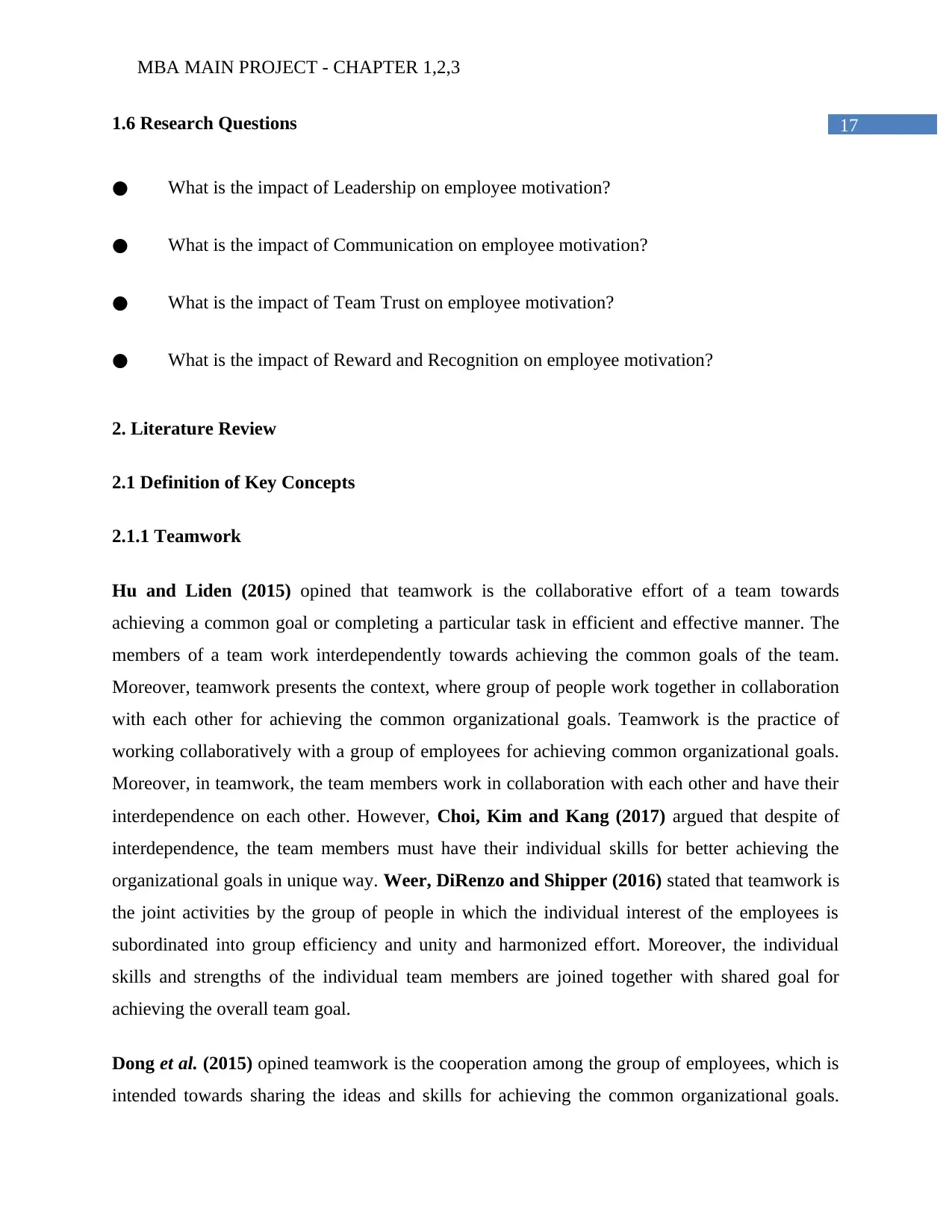
171.6 Research Questions
● What is the impact of Leadership on employee motivation?
● What is the impact of Communication on employee motivation?
● What is the impact of Team Trust on employee motivation?
● What is the impact of Reward and Recognition on employee motivation?
2. Literature Review
2.1 Definition of Key Concepts
2.1.1 Teamwork
Hu and Liden (2015) opined that teamwork is the collaborative effort of a team towards
achieving a common goal or completing a particular task in efficient and effective manner. The
members of a team work interdependently towards achieving the common goals of the team.
Moreover, teamwork presents the context, where group of people work together in collaboration
with each other for achieving the common organizational goals. Teamwork is the practice of
working collaboratively with a group of employees for achieving common organizational goals.
Moreover, in teamwork, the team members work in collaboration with each other and have their
interdependence on each other. However, Choi, Kim and Kang (2017) argued that despite of
interdependence, the team members must have their individual skills for better achieving the
organizational goals in unique way. Weer, DiRenzo and Shipper (2016) stated that teamwork is
the joint activities by the group of people in which the individual interest of the employees is
subordinated into group efficiency and unity and harmonized effort. Moreover, the individual
skills and strengths of the individual team members are joined together with shared goal for
achieving the overall team goal.
Dong et al. (2015) opined teamwork is the cooperation among the group of employees, which is
intended towards sharing the ideas and skills for achieving the common organizational goals.
⊘ This is a preview!⊘
Do you want full access?
Subscribe today to unlock all pages.

Trusted by 1+ million students worldwide
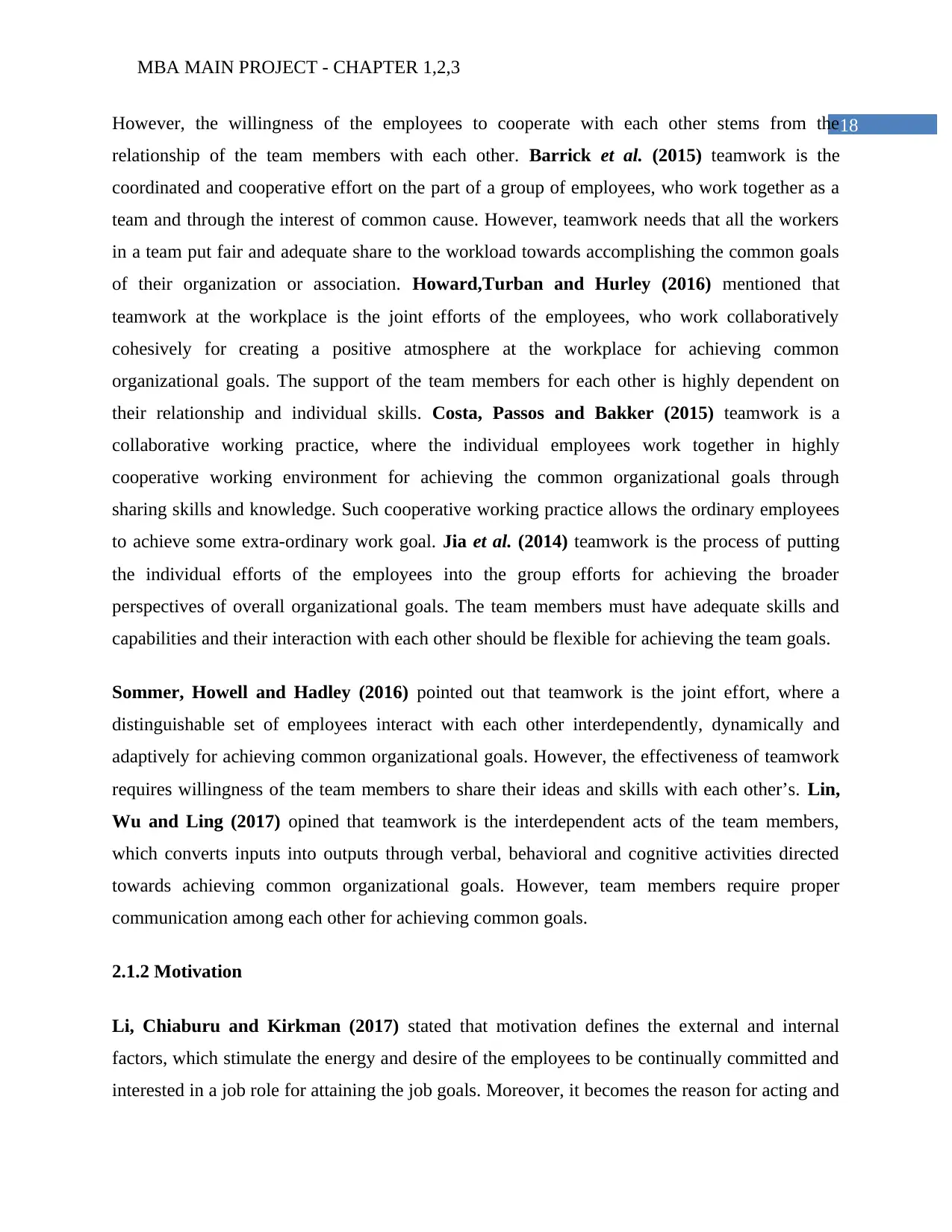
18However, the willingness of the employees to cooperate with each other stems from the
relationship of the team members with each other. Barrick et al. (2015) teamwork is the
coordinated and cooperative effort on the part of a group of employees, who work together as a
team and through the interest of common cause. However, teamwork needs that all the workers
in a team put fair and adequate share to the workload towards accomplishing the common goals
of their organization or association. Howard,Turban and Hurley (2016) mentioned that
teamwork at the workplace is the joint efforts of the employees, who work collaboratively
cohesively for creating a positive atmosphere at the workplace for achieving common
organizational goals. The support of the team members for each other is highly dependent on
their relationship and individual skills. Costa, Passos and Bakker (2015) teamwork is a
collaborative working practice, where the individual employees work together in highly
cooperative working environment for achieving the common organizational goals through
sharing skills and knowledge. Such cooperative working practice allows the ordinary employees
to achieve some extra-ordinary work goal. Jia et al. (2014) teamwork is the process of putting
the individual efforts of the employees into the group efforts for achieving the broader
perspectives of overall organizational goals. The team members must have adequate skills and
capabilities and their interaction with each other should be flexible for achieving the team goals.
Sommer, Howell and Hadley (2016) pointed out that teamwork is the joint effort, where a
distinguishable set of employees interact with each other interdependently, dynamically and
adaptively for achieving common organizational goals. However, the effectiveness of teamwork
requires willingness of the team members to share their ideas and skills with each other’s. Lin,
Wu and Ling (2017) opined that teamwork is the interdependent acts of the team members,
which converts inputs into outputs through verbal, behavioral and cognitive activities directed
towards achieving common organizational goals. However, team members require proper
communication among each other for achieving common goals.
2.1.2 Motivation
Li, Chiaburu and Kirkman (2017) stated that motivation defines the external and internal
factors, which stimulate the energy and desire of the employees to be continually committed and
interested in a job role for attaining the job goals. Moreover, it becomes the reason for acting and
Paraphrase This Document
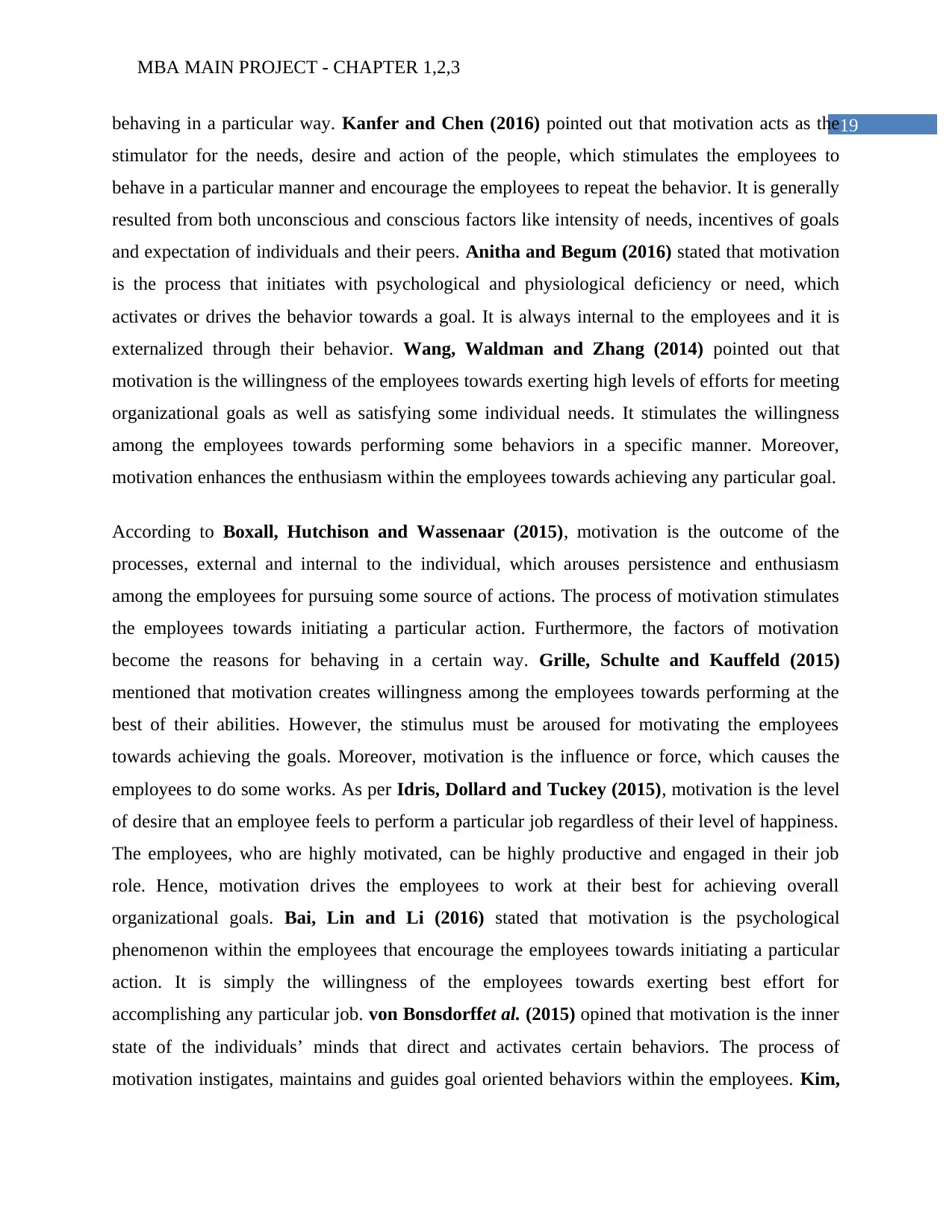
19behaving in a particular way. Kanfer and Chen (2016) pointed out that motivation acts as the
stimulator for the needs, desire and action of the people, which stimulates the employees to
behave in a particular manner and encourage the employees to repeat the behavior. It is generally
resulted from both unconscious and conscious factors like intensity of needs, incentives of goals
and expectation of individuals and their peers. Anitha and Begum (2016) stated that motivation
is the process that initiates with psychological and physiological deficiency or need, which
activates or drives the behavior towards a goal. It is always internal to the employees and it is
externalized through their behavior. Wang, Waldman and Zhang (2014) pointed out that
motivation is the willingness of the employees towards exerting high levels of efforts for meeting
organizational goals as well as satisfying some individual needs. It stimulates the willingness
among the employees towards performing some behaviors in a specific manner. Moreover,
motivation enhances the enthusiasm within the employees towards achieving any particular goal.
According to Boxall, Hutchison and Wassenaar (2015), motivation is the outcome of the
processes, external and internal to the individual, which arouses persistence and enthusiasm
among the employees for pursuing some source of actions. The process of motivation stimulates
the employees towards initiating a particular action. Furthermore, the factors of motivation
become the reasons for behaving in a certain way. Grille, Schulte and Kauffeld (2015)
mentioned that motivation creates willingness among the employees towards performing at the
best of their abilities. However, the stimulus must be aroused for motivating the employees
towards achieving the goals. Moreover, motivation is the influence or force, which causes the
employees to do some works. As per Idris, Dollard and Tuckey (2015), motivation is the level
of desire that an employee feels to perform a particular job regardless of their level of happiness.
The employees, who are highly motivated, can be highly productive and engaged in their job
role. Hence, motivation drives the employees to work at their best for achieving overall
organizational goals. Bai, Lin and Li (2016) stated that motivation is the psychological
phenomenon within the employees that encourage the employees towards initiating a particular
action. It is simply the willingness of the employees towards exerting best effort for
accomplishing any particular job. von Bonsdorffet al. (2015) opined that motivation is the inner
state of the individuals’ minds that direct and activates certain behaviors. The process of
motivation instigates, maintains and guides goal oriented behaviors within the employees. Kim,
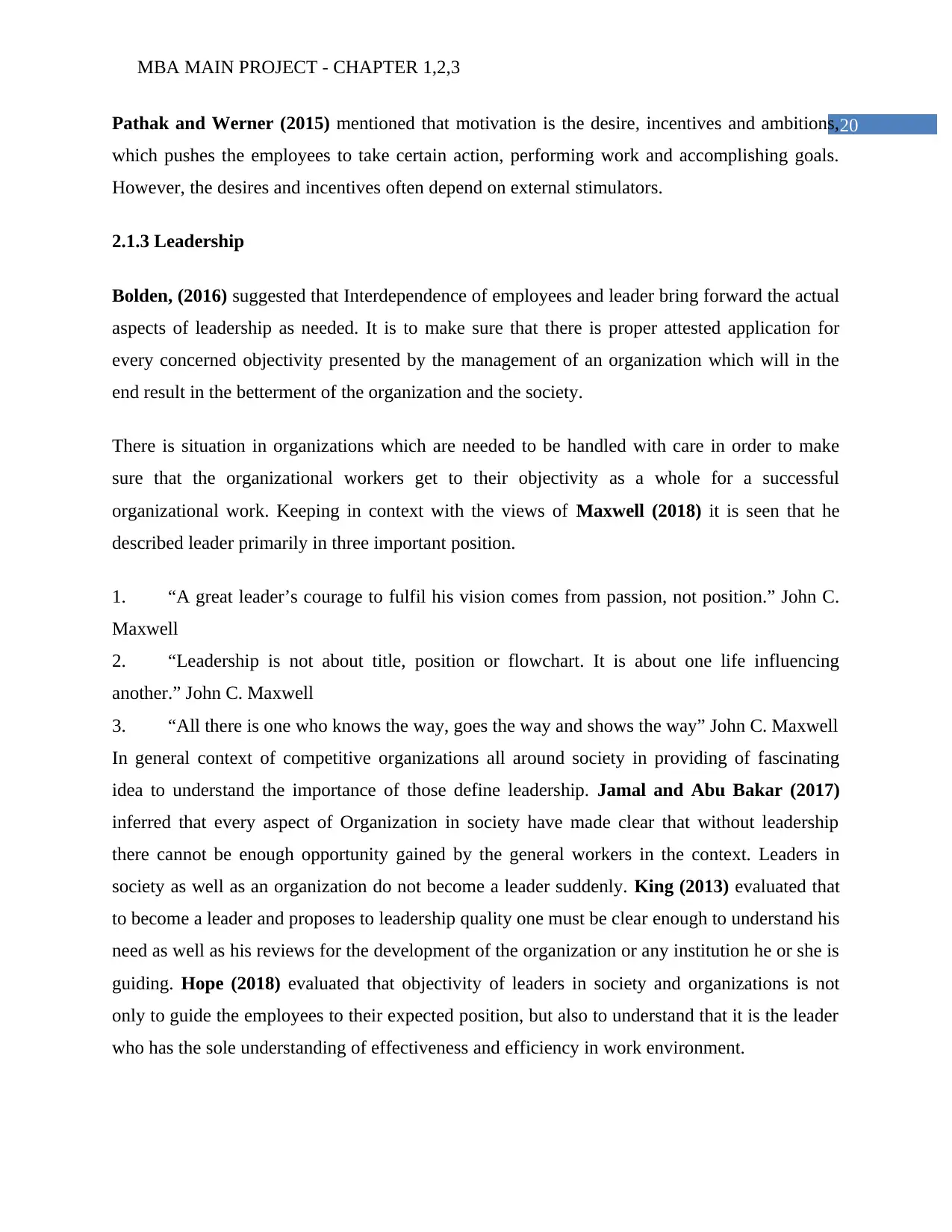
20Pathak and Werner (2015) mentioned that motivation is the desire, incentives and ambitions,
which pushes the employees to take certain action, performing work and accomplishing goals.
However, the desires and incentives often depend on external stimulators.
2.1.3 Leadership
Bolden, (2016) suggested that Interdependence of employees and leader bring forward the actual
aspects of leadership as needed. It is to make sure that there is proper attested application for
every concerned objectivity presented by the management of an organization which will in the
end result in the betterment of the organization and the society.
There is situation in organizations which are needed to be handled with care in order to make
sure that the organizational workers get to their objectivity as a whole for a successful
organizational work. Keeping in context with the views of Maxwell (2018) it is seen that he
described leader primarily in three important position.
1. “A great leader’s courage to fulfil his vision comes from passion, not position.” John C.
Maxwell
2. “Leadership is not about title, position or flowchart. It is about one life influencing
another.” John C. Maxwell
3. “All there is one who knows the way, goes the way and shows the way” John C. Maxwell
In general context of competitive organizations all around society in providing of fascinating
idea to understand the importance of those define leadership. Jamal and Abu Bakar (2017)
inferred that every aspect of Organization in society have made clear that without leadership
there cannot be enough opportunity gained by the general workers in the context. Leaders in
society as well as an organization do not become a leader suddenly. King (2013) evaluated that
to become a leader and proposes to leadership quality one must be clear enough to understand his
need as well as his reviews for the development of the organization or any institution he or she is
guiding. Hope (2018) evaluated that objectivity of leaders in society and organizations is not
only to guide the employees to their expected position, but also to understand that it is the leader
who has the sole understanding of effectiveness and efficiency in work environment.
⊘ This is a preview!⊘
Do you want full access?
Subscribe today to unlock all pages.

Trusted by 1+ million students worldwide
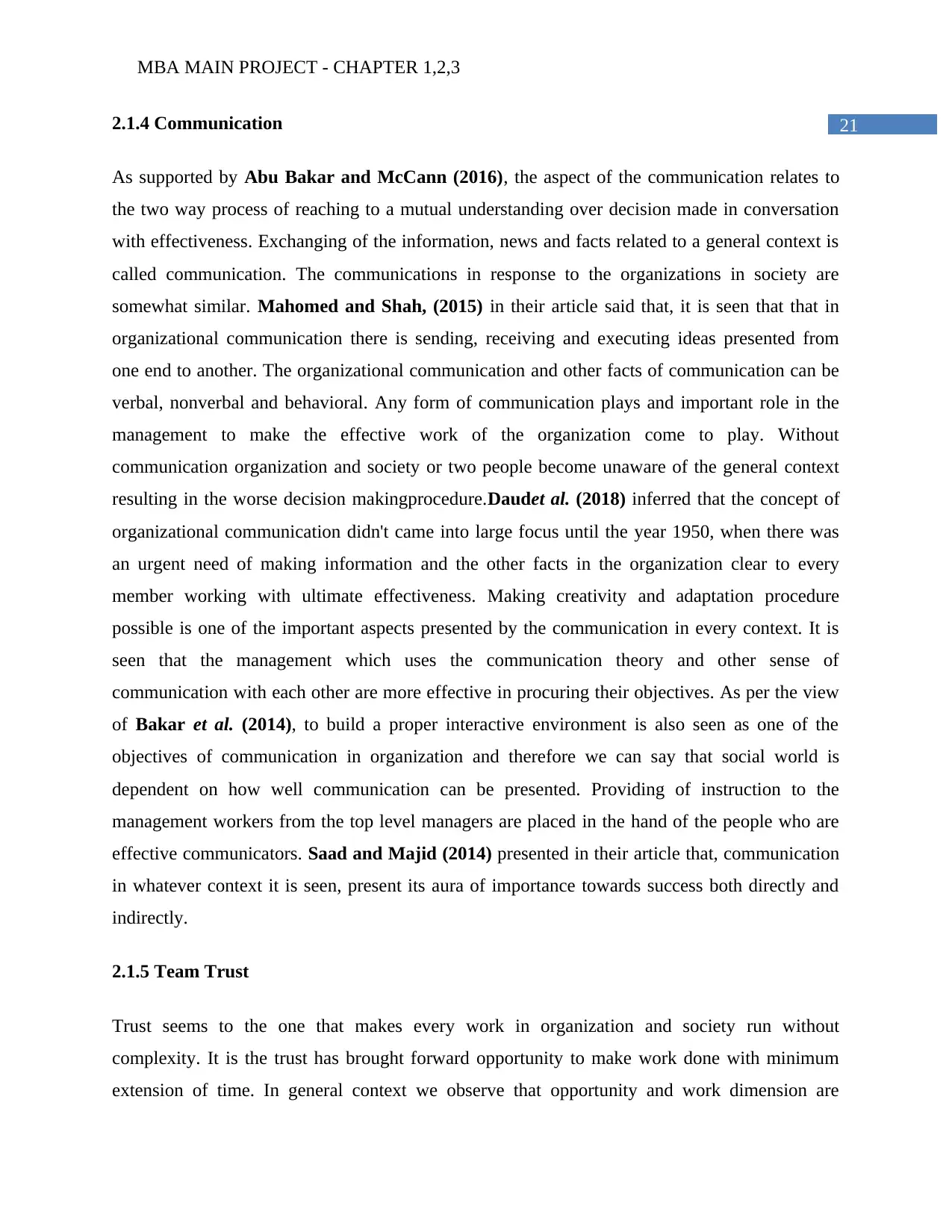
212.1.4 Communication
As supported by Abu Bakar and McCann (2016), the aspect of the communication relates to
the two way process of reaching to a mutual understanding over decision made in conversation
with effectiveness. Exchanging of the information, news and facts related to a general context is
called communication. The communications in response to the organizations in society are
somewhat similar. Mahomed and Shah, (2015) in their article said that, it is seen that that in
organizational communication there is sending, receiving and executing ideas presented from
one end to another. The organizational communication and other facts of communication can be
verbal, nonverbal and behavioral. Any form of communication plays and important role in the
management to make the effective work of the organization come to play. Without
communication organization and society or two people become unaware of the general context
resulting in the worse decision makingprocedure.Daudet al. (2018) inferred that the concept of
organizational communication didn't came into large focus until the year 1950, when there was
an urgent need of making information and the other facts in the organization clear to every
member working with ultimate effectiveness. Making creativity and adaptation procedure
possible is one of the important aspects presented by the communication in every context. It is
seen that the management which uses the communication theory and other sense of
communication with each other are more effective in procuring their objectives. As per the view
of Bakar et al. (2014), to build a proper interactive environment is also seen as one of the
objectives of communication in organization and therefore we can say that social world is
dependent on how well communication can be presented. Providing of instruction to the
management workers from the top level managers are placed in the hand of the people who are
effective communicators. Saad and Majid (2014) presented in their article that, communication
in whatever context it is seen, present its aura of importance towards success both directly and
indirectly.
2.1.5 Team Trust
Trust seems to the one that makes every work in organization and society run without
complexity. It is the trust has brought forward opportunity to make work done with minimum
extension of time. In general context we observe that opportunity and work dimension are
Paraphrase This Document
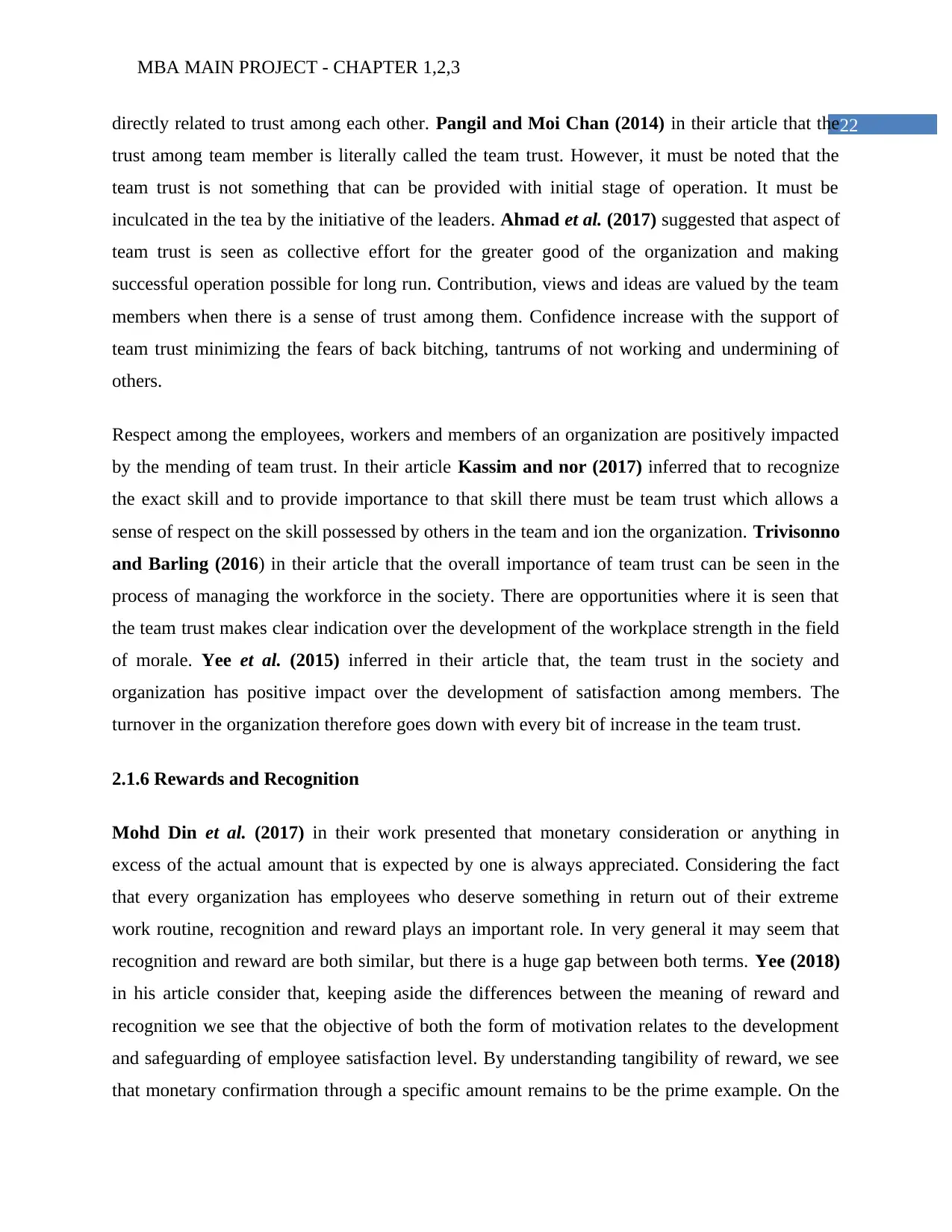
22directly related to trust among each other. Pangil and Moi Chan (2014) in their article that the
trust among team member is literally called the team trust. However, it must be noted that the
team trust is not something that can be provided with initial stage of operation. It must be
inculcated in the tea by the initiative of the leaders. Ahmad et al. (2017) suggested that aspect of
team trust is seen as collective effort for the greater good of the organization and making
successful operation possible for long run. Contribution, views and ideas are valued by the team
members when there is a sense of trust among them. Confidence increase with the support of
team trust minimizing the fears of back bitching, tantrums of not working and undermining of
others.
Respect among the employees, workers and members of an organization are positively impacted
by the mending of team trust. In their article Kassim and nor (2017) inferred that to recognize
the exact skill and to provide importance to that skill there must be team trust which allows a
sense of respect on the skill possessed by others in the team and ion the organization. Trivisonno
and Barling (2016) in their article that the overall importance of team trust can be seen in the
process of managing the workforce in the society. There are opportunities where it is seen that
the team trust makes clear indication over the development of the workplace strength in the field
of morale. Yee et al. (2015) inferred in their article that, the team trust in the society and
organization has positive impact over the development of satisfaction among members. The
turnover in the organization therefore goes down with every bit of increase in the team trust.
2.1.6 Rewards and Recognition
Mohd Din et al. (2017) in their work presented that monetary consideration or anything in
excess of the actual amount that is expected by one is always appreciated. Considering the fact
that every organization has employees who deserve something in return out of their extreme
work routine, recognition and reward plays an important role. In very general it may seem that
recognition and reward are both similar, but there is a huge gap between both terms. Yee (2018)
in his article consider that, keeping aside the differences between the meaning of reward and
recognition we see that the objective of both the form of motivation relates to the development
and safeguarding of employee satisfaction level. By understanding tangibility of reward, we see
that monetary confirmation through a specific amount remains to be the prime example. On the
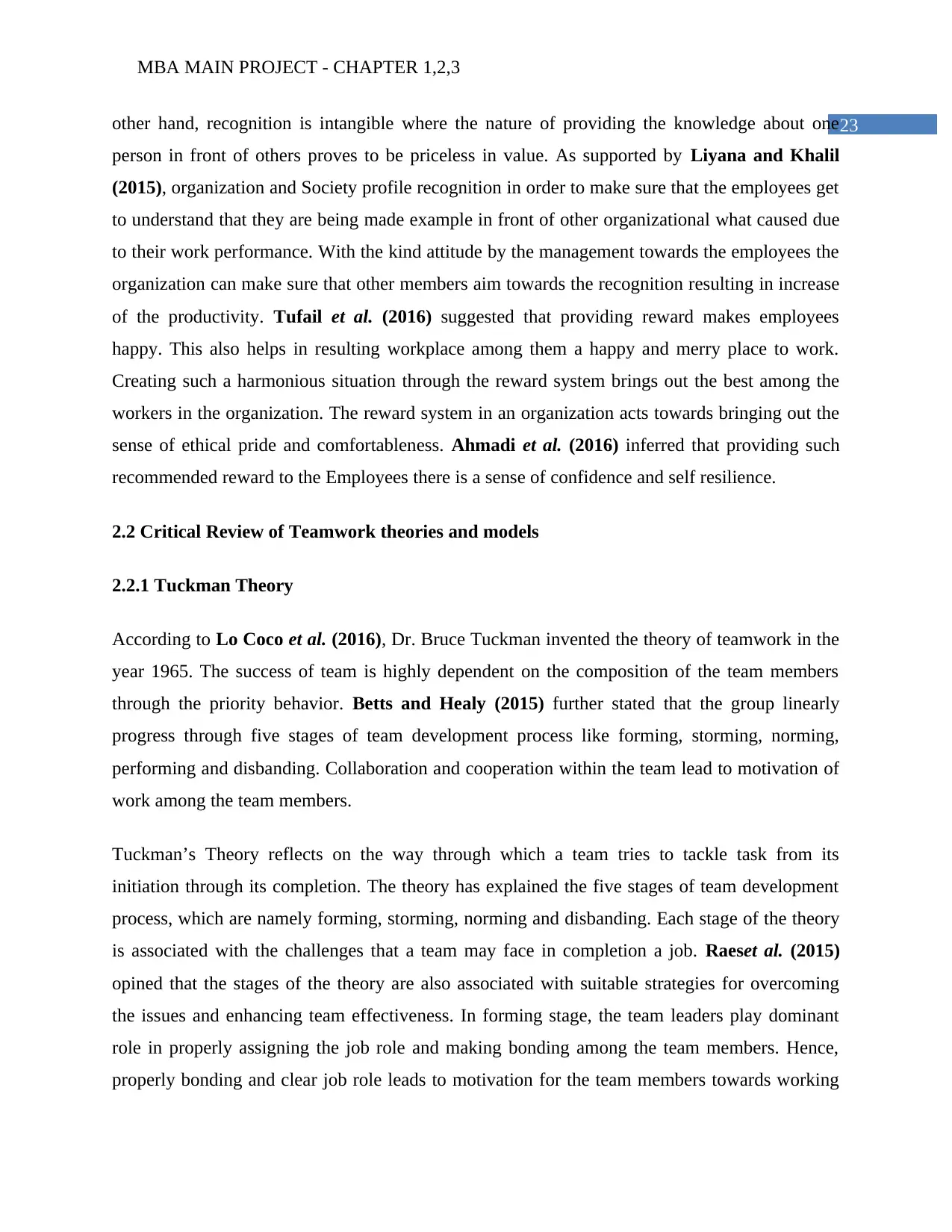
23other hand, recognition is intangible where the nature of providing the knowledge about one
person in front of others proves to be priceless in value. As supported by Liyana and Khalil
(2015), organization and Society profile recognition in order to make sure that the employees get
to understand that they are being made example in front of other organizational what caused due
to their work performance. With the kind attitude by the management towards the employees the
organization can make sure that other members aim towards the recognition resulting in increase
of the productivity. Tufail et al. (2016) suggested that providing reward makes employees
happy. This also helps in resulting workplace among them a happy and merry place to work.
Creating such a harmonious situation through the reward system brings out the best among the
workers in the organization. The reward system in an organization acts towards bringing out the
sense of ethical pride and comfortableness. Ahmadi et al. (2016) inferred that providing such
recommended reward to the Employees there is a sense of confidence and self resilience.
2.2 Critical Review of Teamwork theories and models
2.2.1 Tuckman Theory
According to Lo Coco et al. (2016), Dr. Bruce Tuckman invented the theory of teamwork in the
year 1965. The success of team is highly dependent on the composition of the team members
through the priority behavior. Betts and Healy (2015) further stated that the group linearly
progress through five stages of team development process like forming, storming, norming,
performing and disbanding. Collaboration and cooperation within the team lead to motivation of
work among the team members.
Tuckman’s Theory reflects on the way through which a team tries to tackle task from its
initiation through its completion. The theory has explained the five stages of team development
process, which are namely forming, storming, norming and disbanding. Each stage of the theory
is associated with the challenges that a team may face in completion a job. Raeset al. (2015)
opined that the stages of the theory are also associated with suitable strategies for overcoming
the issues and enhancing team effectiveness. In forming stage, the team leaders play dominant
role in properly assigning the job role and making bonding among the team members. Hence,
properly bonding and clear job role leads to motivation for the team members towards working
⊘ This is a preview!⊘
Do you want full access?
Subscribe today to unlock all pages.

Trusted by 1+ million students worldwide
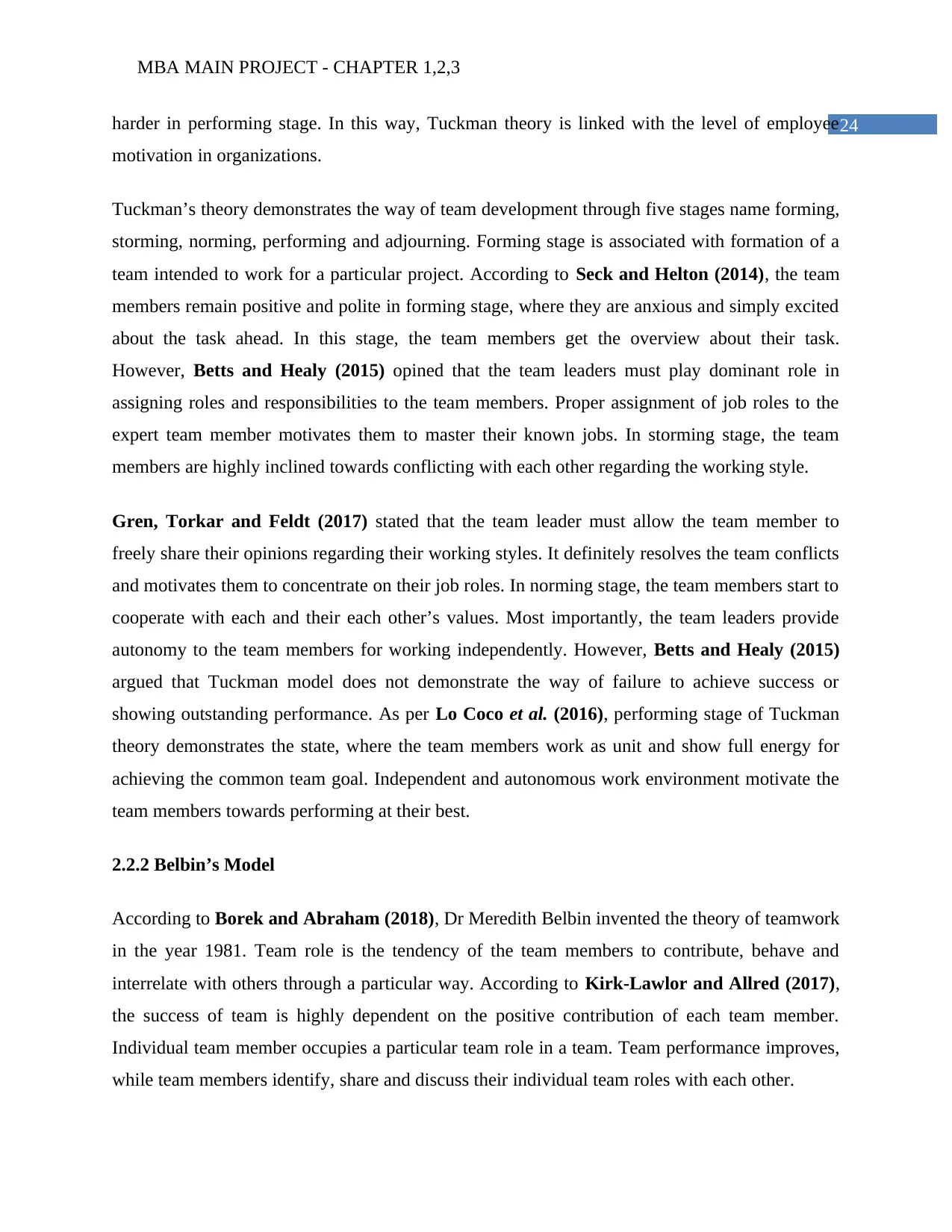
24harder in performing stage. In this way, Tuckman theory is linked with the level of employee
motivation in organizations.
Tuckman’s theory demonstrates the way of team development through five stages name forming,
storming, norming, performing and adjourning. Forming stage is associated with formation of a
team intended to work for a particular project. According to Seck and Helton (2014), the team
members remain positive and polite in forming stage, where they are anxious and simply excited
about the task ahead. In this stage, the team members get the overview about their task.
However, Betts and Healy (2015) opined that the team leaders must play dominant role in
assigning roles and responsibilities to the team members. Proper assignment of job roles to the
expert team member motivates them to master their known jobs. In storming stage, the team
members are highly inclined towards conflicting with each other regarding the working style.
Gren, Torkar and Feldt (2017) stated that the team leader must allow the team member to
freely share their opinions regarding their working styles. It definitely resolves the team conflicts
and motivates them to concentrate on their job roles. In norming stage, the team members start to
cooperate with each and their each other’s values. Most importantly, the team leaders provide
autonomy to the team members for working independently. However, Betts and Healy (2015)
argued that Tuckman model does not demonstrate the way of failure to achieve success or
showing outstanding performance. As per Lo Coco et al. (2016), performing stage of Tuckman
theory demonstrates the state, where the team members work as unit and show full energy for
achieving the common team goal. Independent and autonomous work environment motivate the
team members towards performing at their best.
2.2.2 Belbin’s Model
According to Borek and Abraham (2018), Dr Meredith Belbin invented the theory of teamwork
in the year 1981. Team role is the tendency of the team members to contribute, behave and
interrelate with others through a particular way. According to Kirk-Lawlor and Allred (2017),
the success of team is highly dependent on the positive contribution of each team member.
Individual team member occupies a particular team role in a team. Team performance improves,
while team members identify, share and discuss their individual team roles with each other.
Paraphrase This Document
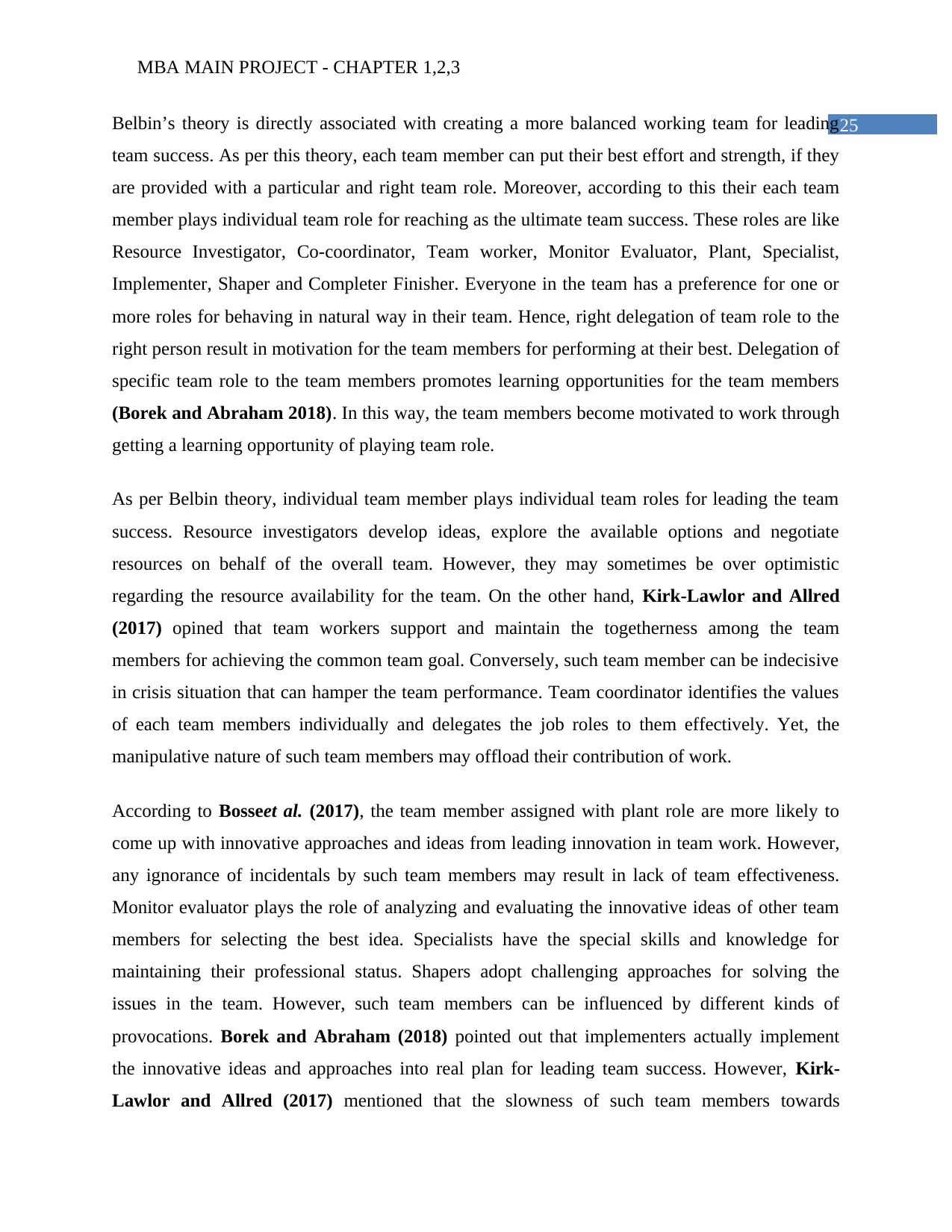
25Belbin’s theory is directly associated with creating a more balanced working team for leading
team success. As per this theory, each team member can put their best effort and strength, if they
are provided with a particular and right team role. Moreover, according to this their each team
member plays individual team role for reaching as the ultimate team success. These roles are like
Resource Investigator, Co-coordinator, Team worker, Monitor Evaluator, Plant, Specialist,
Implementer, Shaper and Completer Finisher. Everyone in the team has a preference for one or
more roles for behaving in natural way in their team. Hence, right delegation of team role to the
right person result in motivation for the team members for performing at their best. Delegation of
specific team role to the team members promotes learning opportunities for the team members
(Borek and Abraham 2018). In this way, the team members become motivated to work through
getting a learning opportunity of playing team role.
As per Belbin theory, individual team member plays individual team roles for leading the team
success. Resource investigators develop ideas, explore the available options and negotiate
resources on behalf of the overall team. However, they may sometimes be over optimistic
regarding the resource availability for the team. On the other hand, Kirk-Lawlor and Allred
(2017) opined that team workers support and maintain the togetherness among the team
members for achieving the common team goal. Conversely, such team member can be indecisive
in crisis situation that can hamper the team performance. Team coordinator identifies the values
of each team members individually and delegates the job roles to them effectively. Yet, the
manipulative nature of such team members may offload their contribution of work.
According to Bosseet al. (2017), the team member assigned with plant role are more likely to
come up with innovative approaches and ideas from leading innovation in team work. However,
any ignorance of incidentals by such team members may result in lack of team effectiveness.
Monitor evaluator plays the role of analyzing and evaluating the innovative ideas of other team
members for selecting the best idea. Specialists have the special skills and knowledge for
maintaining their professional status. Shapers adopt challenging approaches for solving the
issues in the team. However, such team members can be influenced by different kinds of
provocations. Borek and Abraham (2018) pointed out that implementers actually implement
the innovative ideas and approaches into real plan for leading team success. However, Kirk-
Lawlor and Allred (2017) mentioned that the slowness of such team members towards
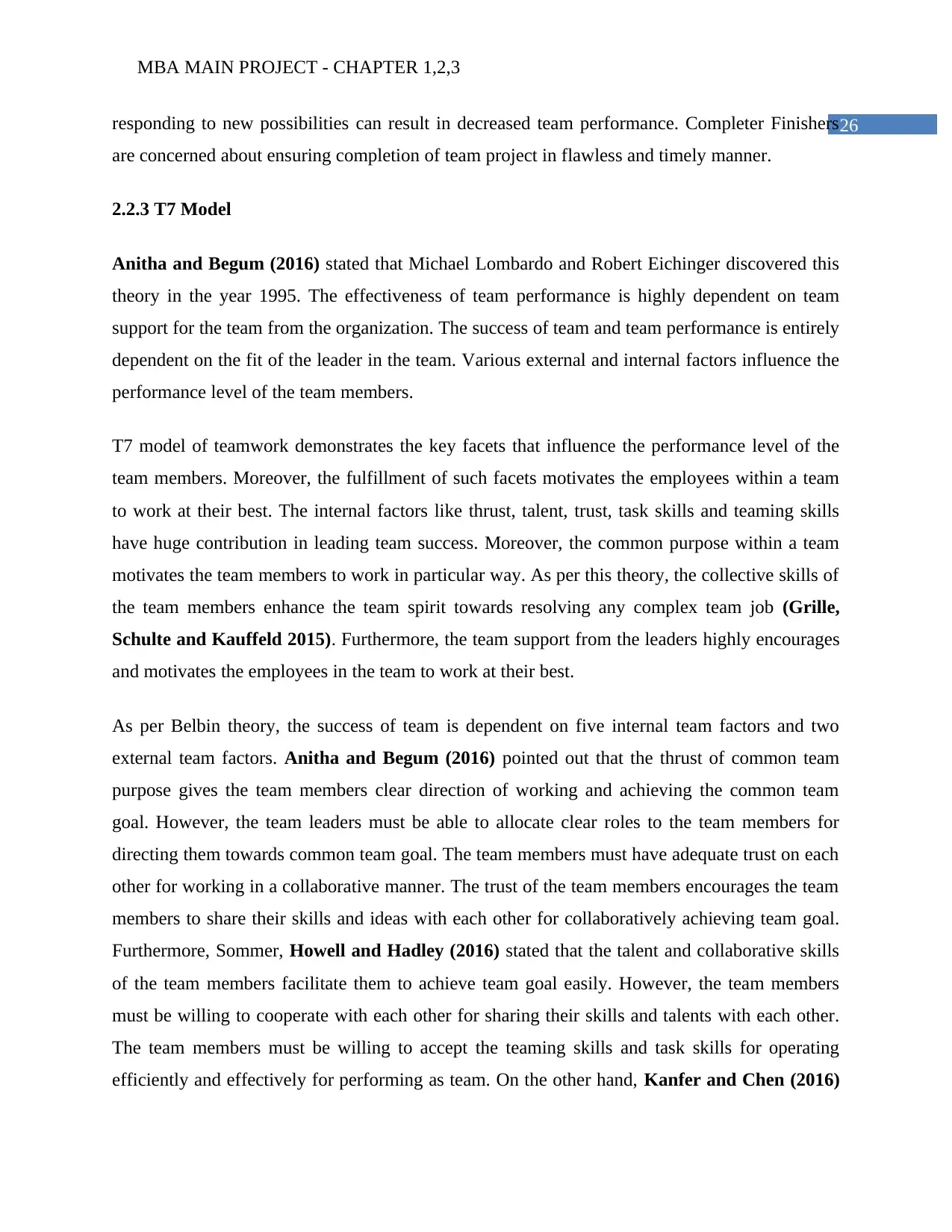
26responding to new possibilities can result in decreased team performance. Completer Finishers
are concerned about ensuring completion of team project in flawless and timely manner.
2.2.3 T7 Model
Anitha and Begum (2016) stated that Michael Lombardo and Robert Eichinger discovered this
theory in the year 1995. The effectiveness of team performance is highly dependent on team
support for the team from the organization. The success of team and team performance is entirely
dependent on the fit of the leader in the team. Various external and internal factors influence the
performance level of the team members.
T7 model of teamwork demonstrates the key facets that influence the performance level of the
team members. Moreover, the fulfillment of such facets motivates the employees within a team
to work at their best. The internal factors like thrust, talent, trust, task skills and teaming skills
have huge contribution in leading team success. Moreover, the common purpose within a team
motivates the team members to work in particular way. As per this theory, the collective skills of
the team members enhance the team spirit towards resolving any complex team job (Grille,
Schulte and Kauffeld 2015). Furthermore, the team support from the leaders highly encourages
and motivates the employees in the team to work at their best.
As per Belbin theory, the success of team is dependent on five internal team factors and two
external team factors. Anitha and Begum (2016) pointed out that the thrust of common team
purpose gives the team members clear direction of working and achieving the common team
goal. However, the team leaders must be able to allocate clear roles to the team members for
directing them towards common team goal. The team members must have adequate trust on each
other for working in a collaborative manner. The trust of the team members encourages the team
members to share their skills and ideas with each other for collaboratively achieving team goal.
Furthermore, Sommer, Howell and Hadley (2016) stated that the talent and collaborative skills
of the team members facilitate them to achieve team goal easily. However, the team members
must be willing to cooperate with each other for sharing their skills and talents with each other.
The team members must be willing to accept the teaming skills and task skills for operating
efficiently and effectively for performing as team. On the other hand, Kanfer and Chen (2016)
⊘ This is a preview!⊘
Do you want full access?
Subscribe today to unlock all pages.

Trusted by 1+ million students worldwide

27opined that the external factor like team support from the organization enables the team members
to perform at effective manner. However, the leadership fitness is also important to encourage a
direct the team members in right direction to achieve team goal.
2.2.4 GRPI Model
Richard Beckhard discovered this theory in the year 1972. The success of team is dependent on
the structured way developing team. The performance of team members is entirely dependent on
the interrelationship among them. Specific goals form the foundation of the team development
process and their performance. The team members can perform at their best, while their role and
responsibilities are clear to them (Sommer, Howell and Hadley 2016).
GRPI model represents the critical aspects and interrelated aspects of teamwork leading to level
of the team. In this way, such factors are directly related to the employees involved within a
team. As per this model, clear and transparent goals build the foundation of teamwork.
Moreover, clear and transparent goals give the team members proper direction to perform their
specific roles. On the other hand, specific role and responsibilities assigned to the team members
provide them clear picture about their actual activities. In this way, such clear picture motivates
the employees in the team to work in proper direction. Furthermore, this theory has also revealed
that proper processes govern the issues in control, communication and decision making process
of the teamwork (Boxall, Hutchison and Wassenaar 2015). In this structured and constructive
process motivates the team members to work at their best without any issues. Most importantly,
the theory has highlighted the importance of interpersonal relationship in team effectiveness,
which also motivates the team members towards performing at high level.
GRPI model has focused on the critical and interrelated factors that enhances the effectiveness of
team performance and diagnose the issues in the team. According to Sommer, Howell and
Hadley (2016), proper goals and mission build the actual purpose of the team. Common, shared
and agreed goals give the team members proper direction to work towards meeting the overall
team goal. However, the goals and missions of the teamwork should be clear and transparent
enough to the team members for giving them exact direction to work. Proper role statement
defines the responsibility, task and authority of the team members. In order to work at the best,
Paraphrase This Document

28the members of the team must be able to agree, understand and satisfied with their assigned job
roles. Such clear roles encourage the team members to work their best either individually or
collectively through getting a clear picture of the team goals.
Furthermore, Kanfer and Chen (2016) opined that structured process act as the governing tool
for the teams for overcoming the inefficiencies in the areas of control, decision making,
communication and coordination. However, the processes must be structured enough for
supporting the team goals through determining the interaction within team. This model looks at
team as structure and rationale, rather than having shared emotional value. This theory has most
importantly focussed on the interpersonal relationship, where open communication, trust and
feedback from the team members create a supporting work. It also encourages innovative and
creative contribution from the team members for high level of team performance.
2.2.5 Heckman Model
Richard Hackman invented this theory in the year 1987. The level of team effort collective
expends the carrying out the team task. The amounts of skills and knowledge have high level of
bearing on group task. The design and composition of the team members regulates the team
behavior. The interaction of the team members results in high level of team synergy (Kim,
Pathak and Werner 2015).
Heckman model of teamwork decides upon the condition and organizational context for
supporting the work team. According to Idris, Dollard and Tuckey (2015), specific tasks of the
team members provide substantial autonomy to the team members regarding the way of their
work. Such adequate autonomy motivates the team members to perform at their peak level.
Proper designing of the team members fosters collective effort among the team members towards
achieving the actual goal of the team. Kim, Pathak and Werner (2015) pointed out that
Heckman teamwork model has highlighted that supporting work environment fosters motivation
among the team members. Moreover, rewarding and positive consequence for the excellent team
performance motivates the employees in a team to work harder. Apart from that, diverse
membership within the team results in group synergy, which generates diverse group ideas and
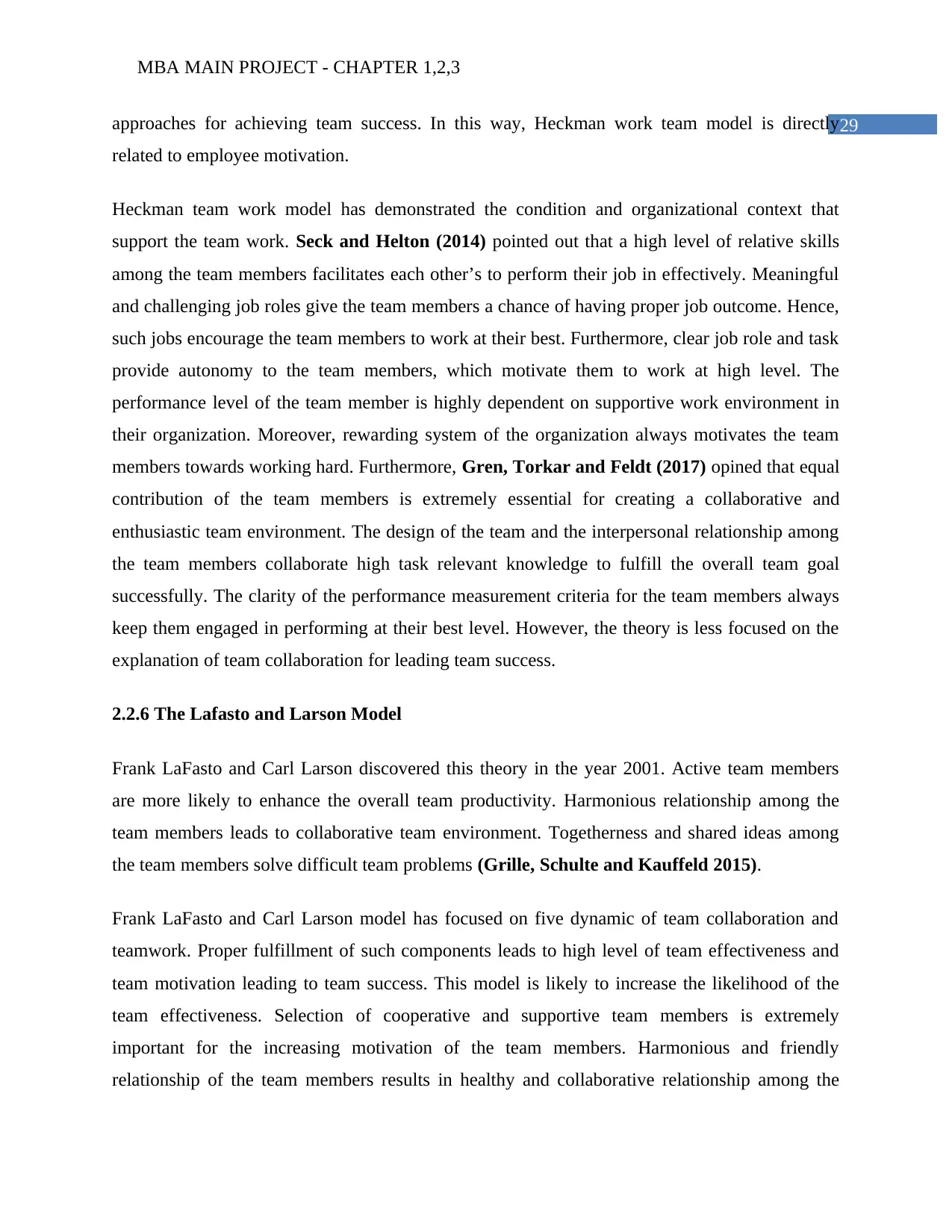
29approaches for achieving team success. In this way, Heckman work team model is directly
related to employee motivation.
Heckman team work model has demonstrated the condition and organizational context that
support the team work. Seck and Helton (2014) pointed out that a high level of relative skills
among the team members facilitates each other’s to perform their job in effectively. Meaningful
and challenging job roles give the team members a chance of having proper job outcome. Hence,
such jobs encourage the team members to work at their best. Furthermore, clear job role and task
provide autonomy to the team members, which motivate them to work at high level. The
performance level of the team member is highly dependent on supportive work environment in
their organization. Moreover, rewarding system of the organization always motivates the team
members towards working hard. Furthermore, Gren, Torkar and Feldt (2017) opined that equal
contribution of the team members is extremely essential for creating a collaborative and
enthusiastic team environment. The design of the team and the interpersonal relationship among
the team members collaborate high task relevant knowledge to fulfill the overall team goal
successfully. The clarity of the performance measurement criteria for the team members always
keep them engaged in performing at their best level. However, the theory is less focused on the
explanation of team collaboration for leading team success.
2.2.6 The Lafasto and Larson Model
Frank LaFasto and Carl Larson discovered this theory in the year 2001. Active team members
are more likely to enhance the overall team productivity. Harmonious relationship among the
team members leads to collaborative team environment. Togetherness and shared ideas among
the team members solve difficult team problems (Grille, Schulte and Kauffeld 2015).
Frank LaFasto and Carl Larson model has focused on five dynamic of team collaboration and
teamwork. Proper fulfillment of such components leads to high level of team effectiveness and
team motivation leading to team success. This model is likely to increase the likelihood of the
team effectiveness. Selection of cooperative and supportive team members is extremely
important for the increasing motivation of the team members. Harmonious and friendly
relationship of the team members results in healthy and collaborative relationship among the
⊘ This is a preview!⊘
Do you want full access?
Subscribe today to unlock all pages.

Trusted by 1+ million students worldwide
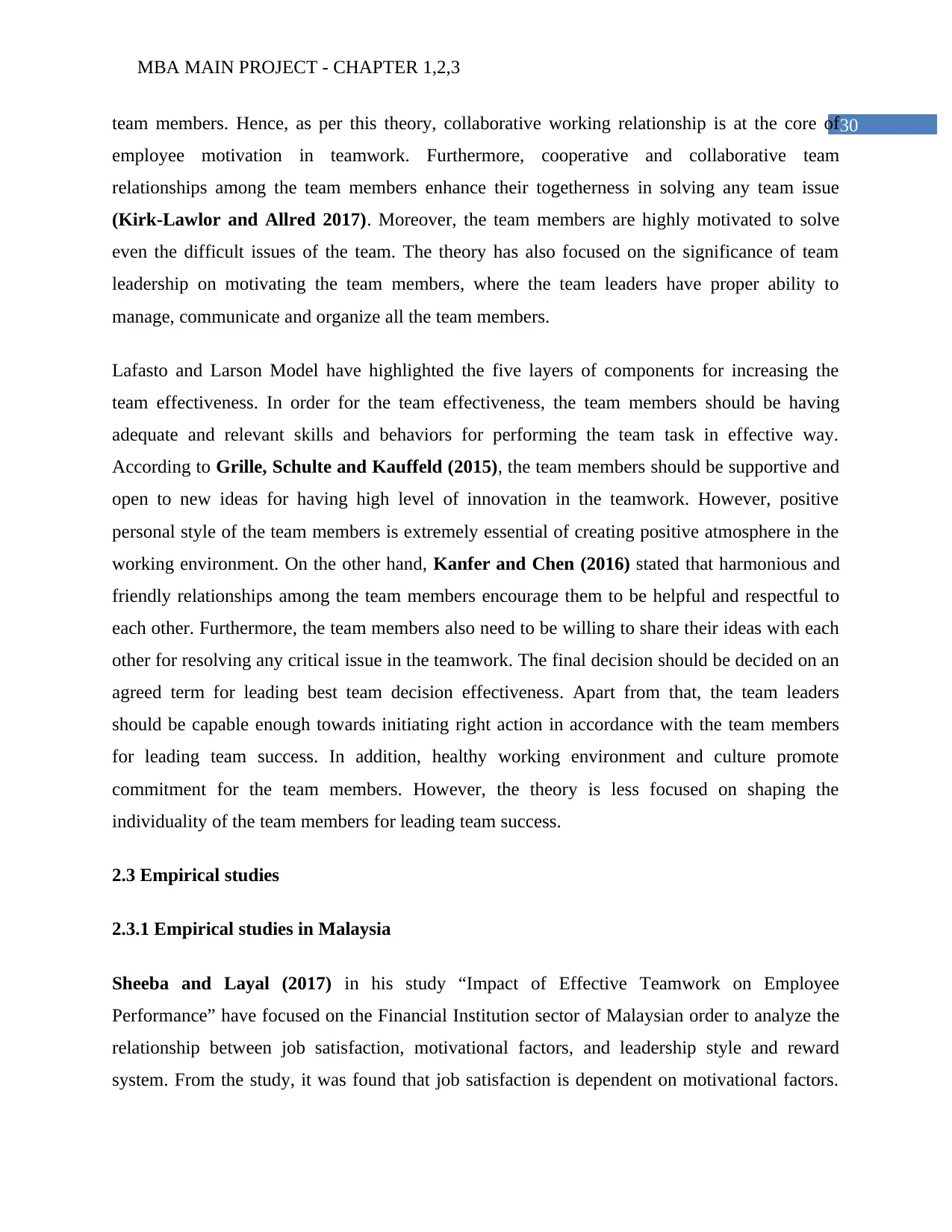
30team members. Hence, as per this theory, collaborative working relationship is at the core of
employee motivation in teamwork. Furthermore, cooperative and collaborative team
relationships among the team members enhance their togetherness in solving any team issue
(Kirk-Lawlor and Allred 2017). Moreover, the team members are highly motivated to solve
even the difficult issues of the team. The theory has also focused on the significance of team
leadership on motivating the team members, where the team leaders have proper ability to
manage, communicate and organize all the team members.
Lafasto and Larson Model have highlighted the five layers of components for increasing the
team effectiveness. In order for the team effectiveness, the team members should be having
adequate and relevant skills and behaviors for performing the team task in effective way.
According to Grille, Schulte and Kauffeld (2015), the team members should be supportive and
open to new ideas for having high level of innovation in the teamwork. However, positive
personal style of the team members is extremely essential of creating positive atmosphere in the
working environment. On the other hand, Kanfer and Chen (2016) stated that harmonious and
friendly relationships among the team members encourage them to be helpful and respectful to
each other. Furthermore, the team members also need to be willing to share their ideas with each
other for resolving any critical issue in the teamwork. The final decision should be decided on an
agreed term for leading best team decision effectiveness. Apart from that, the team leaders
should be capable enough towards initiating right action in accordance with the team members
for leading team success. In addition, healthy working environment and culture promote
commitment for the team members. However, the theory is less focused on shaping the
individuality of the team members for leading team success.
2.3 Empirical studies
2.3.1 Empirical studies in Malaysia
Sheeba and Layal (2017) in his study “Impact of Effective Teamwork on Employee
Performance” have focused on the Financial Institution sector of Malaysian order to analyze the
relationship between job satisfaction, motivational factors, and leadership style and reward
system. From the study, it was found that job satisfaction is dependent on motivational factors.
Paraphrase This Document

31The key variables of this article are (1) teamwork (2) promotion and reward (3) motivation. Even
though this article focuses more on the impact of employee motivation on teamwork
effectiveness, still it has been selected because it has been evident that employee motivation
gives rise to effective teamwork, which further enhances job satisfaction. Tabassiet al. (2011) in
their article Training, motivation and teamwork improvement: The case of construction firms
written in Malaysia have demonstrated the ways in which teamwork, Motivation and training
helps employee at workplace to do well in their performance. The authors have stated that
training and motivation are key elements which help an employee to perform well at workplace.
The article states that training is a tool of better performance and motivation is a tool of deriving
the best out of every worker. The key variable of the article are1. Teamwork 2. Training and 3.
Motivation. The article is mainly focused of showing relationship among these three variables
and on how this affect the employees of worker performance at workplace. In the article by
Sheeba and Layal (2017) it has been seen that authors have emphasized on the motivation as an
independent variable in which job satisfaction is dependent on motivation if an employee. Where
as in article of Tabassiet al. (2011) Motivation is used as a tool of deriving the best performance
of a worker. In the above article motivation is the only focus of the author to grow employee
performance whereas in the second article teamwork, motivation as well as training are
important for employee performance.
Hanaysha and Tahir (2016) in their article Examining the effects of employee empowerment,
teamwork, and employee training on job satisfaction have stated that role of motivation,
teamwork and employee training for job satisfaction of the employee. The author hears have
research on the Education sector of Malaysia. It has noticed in the article that the authors
emphasize on how training, empowerment or motivation help an employee to be satisfied from
his job role and perform properly through effective training procedure. The variable under this
case study are 1. Teamwork 2. Motivation and 3. Training of employee. It can be said that the
article has shed light on how a company can improve employee performance through motivation
and teamwork training. The second article which has seen chosen is of Herman (2016) have
demonstrated the importance of motivation and teamwork in their article the motivation of
quantity surveyors in the Malaysian construction industry for improved job performance. It can
be said that through effective teamwork and high motivation levels there can high job
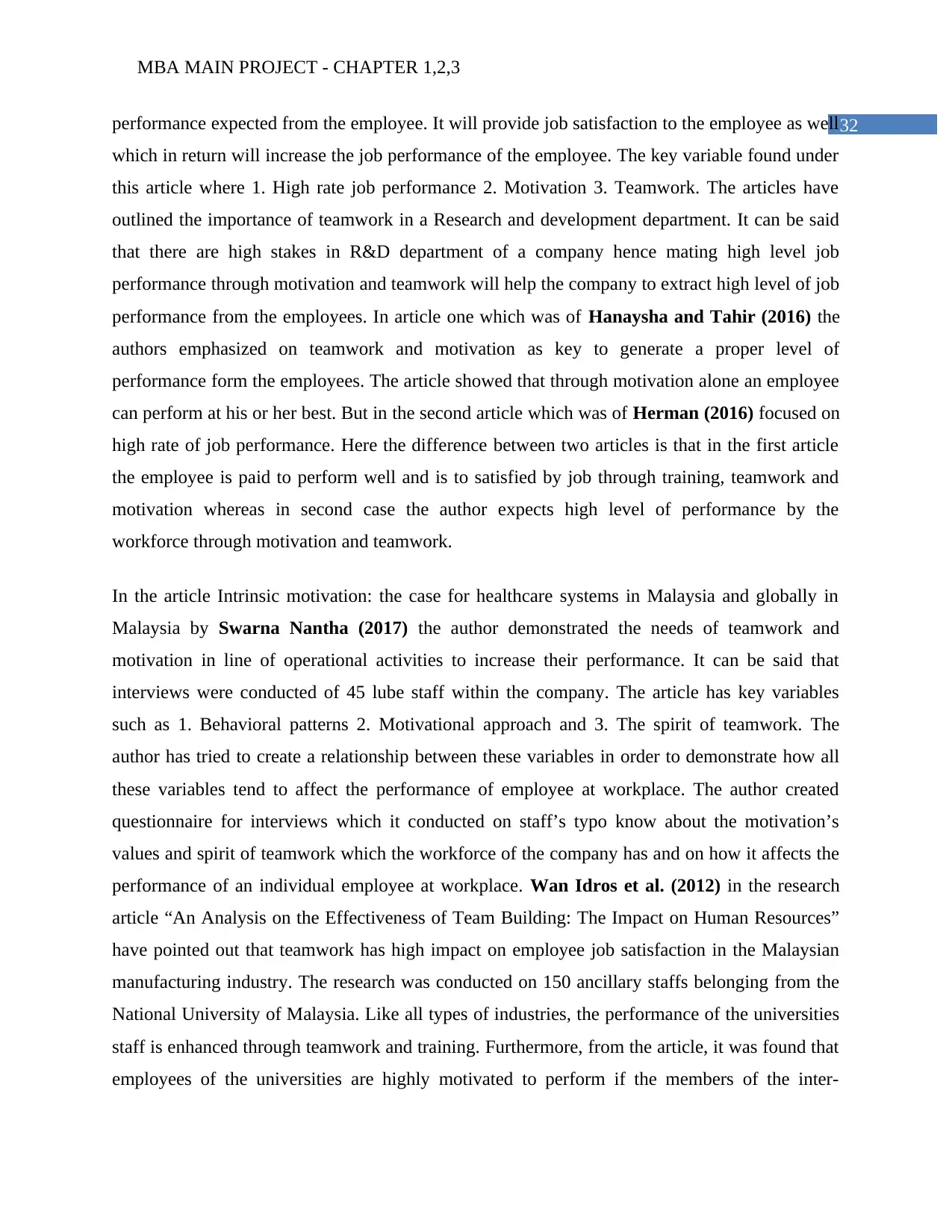
32performance expected from the employee. It will provide job satisfaction to the employee as well
which in return will increase the job performance of the employee. The key variable found under
this article where 1. High rate job performance 2. Motivation 3. Teamwork. The articles have
outlined the importance of teamwork in a Research and development department. It can be said
that there are high stakes in R&D department of a company hence mating high level job
performance through motivation and teamwork will help the company to extract high level of job
performance from the employees. In article one which was of Hanaysha and Tahir (2016) the
authors emphasized on teamwork and motivation as key to generate a proper level of
performance form the employees. The article showed that through motivation alone an employee
can perform at his or her best. But in the second article which was of Herman (2016) focused on
high rate of job performance. Here the difference between two articles is that in the first article
the employee is paid to perform well and is to satisfied by job through training, teamwork and
motivation whereas in second case the author expects high level of performance by the
workforce through motivation and teamwork.
In the article Intrinsic motivation: the case for healthcare systems in Malaysia and globally in
Malaysia by Swarna Nantha (2017) the author demonstrated the needs of teamwork and
motivation in line of operational activities to increase their performance. It can be said that
interviews were conducted of 45 lube staff within the company. The article has key variables
such as 1. Behavioral patterns 2. Motivational approach and 3. The spirit of teamwork. The
author has tried to create a relationship between these variables in order to demonstrate how all
these variables tend to affect the performance of employee at workplace. The author created
questionnaire for interviews which it conducted on staff’s typo know about the motivation’s
values and spirit of teamwork which the workforce of the company has and on how it affects the
performance of an individual employee at workplace. Wan Idros et al. (2012) in the research
article “An Analysis on the Effectiveness of Team Building: The Impact on Human Resources”
have pointed out that teamwork has high impact on employee job satisfaction in the Malaysian
manufacturing industry. The research was conducted on 150 ancillary staffs belonging from the
National University of Malaysia. Like all types of industries, the performance of the universities
staff is enhanced through teamwork and training. Furthermore, from the article, it was found that
employees of the universities are highly motivated to perform if the members of the inter-
⊘ This is a preview!⊘
Do you want full access?
Subscribe today to unlock all pages.

Trusted by 1+ million students worldwide

33departments are highly trained as this helps in streamlining the teaching procedure with
structural dependencies. The main objectives of the study are (1) team work (2) employee
training (3) responsibility sharing (4) workplace culture and, (5) teaching procedure. In this way
through better teamwork, staffs are able to share knowledge among each other, share
responsibility, enhance the teaching procedure and build positive workplace culture. Both the
researchers have carried on different variables related to employee motivation in Malaysian
context. However, the strength of Wan Idros et al. (2012) research is that it has larger sample
size compared to Swarna Nantha, (2017) and this determines more accurate and better result. It
can be said that as the sample size of the second research is high the analysis of the research will
also be in detail making it more convincing to draw an effective conclusion.
2.3.2 Empirical studies Global
Irfan and Lodhi (2015) In their research work known as ‘Impact of Teamwork on Employee
Motivation: A Case of Banking Sector of Pakistan’ have demonstrated the impact of teamwork
and motivation at workplace which is banking sector based research in Pakistan. The journal has
created a relationship between employee work performance with teamwork and motivation. It
can be said that the two major variables which are present in this research work is 1. Motivation
and 2. Teamwork. The researchers have tried to depict the thought of how motivation and
teamwork effect on the employee performance of company. They have conducted secondary
research and have showed that through the use of motivation the management can derive self
objective of the employee to perform well and to reach a common goal with the spirit of
teamwork. The researcher has showed that the impact of teamwork and motivation is immense
when it comes to employee performance and that it helps a firm to increase their employee
performance. On the other hand, Hu and Liden (2015) in the research paper named Making a
difference in the teamwork: Linking team prosocial motivation to team processes and
effectiveness have showed the different aspect of teamwork as well as the implementation of
motivation into different process of workforce within a company. The two main variables
entered into this research were teamwork and motivation. It can be said that teamwork and
motivation are being linked to the operations of the company. The research collected data from
310 members of laboratory analyzing on how motivation and teamwork help them in their
operational activities. It can be said that through efficient use of this data the researcher
Paraphrase This Document
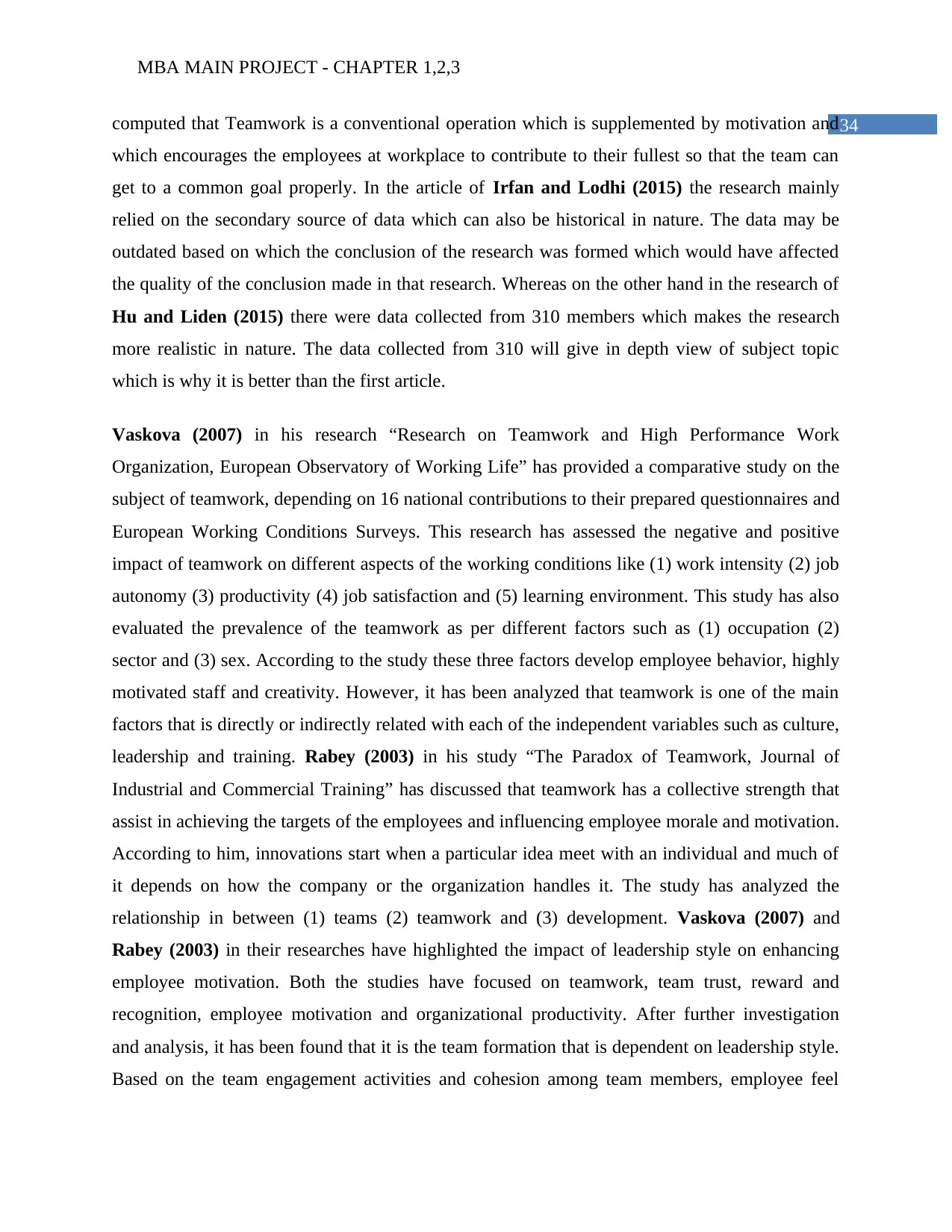
34computed that Teamwork is a conventional operation which is supplemented by motivation and
which encourages the employees at workplace to contribute to their fullest so that the team can
get to a common goal properly. In the article of Irfan and Lodhi (2015) the research mainly
relied on the secondary source of data which can also be historical in nature. The data may be
outdated based on which the conclusion of the research was formed which would have affected
the quality of the conclusion made in that research. Whereas on the other hand in the research of
Hu and Liden (2015) there were data collected from 310 members which makes the research
more realistic in nature. The data collected from 310 will give in depth view of subject topic
which is why it is better than the first article.
Vaskova (2007) in his research “Research on Teamwork and High Performance Work
Organization, European Observatory of Working Life” has provided a comparative study on the
subject of teamwork, depending on 16 national contributions to their prepared questionnaires and
European Working Conditions Surveys. This research has assessed the negative and positive
impact of teamwork on different aspects of the working conditions like (1) work intensity (2) job
autonomy (3) productivity (4) job satisfaction and (5) learning environment. This study has also
evaluated the prevalence of the teamwork as per different factors such as (1) occupation (2)
sector and (3) sex. According to the study these three factors develop employee behavior, highly
motivated staff and creativity. However, it has been analyzed that teamwork is one of the main
factors that is directly or indirectly related with each of the independent variables such as culture,
leadership and training. Rabey (2003) in his study “The Paradox of Teamwork, Journal of
Industrial and Commercial Training” has discussed that teamwork has a collective strength that
assist in achieving the targets of the employees and influencing employee morale and motivation.
According to him, innovations start when a particular idea meet with an individual and much of
it depends on how the company or the organization handles it. The study has analyzed the
relationship in between (1) teams (2) teamwork and (3) development. Vaskova (2007) and
Rabey (2003) in their researches have highlighted the impact of leadership style on enhancing
employee motivation. Both the studies have focused on teamwork, team trust, reward and
recognition, employee motivation and organizational productivity. After further investigation
and analysis, it has been found that it is the team formation that is dependent on leadership style.
Based on the team engagement activities and cohesion among team members, employee feel

35motivated and associated with an organization. Therefore, from the research it has been evident
that public service employees are more satisfied and engaged when democratic leadership style
is followed because it directly enhances team engagement. Rabey (2003) has judged the matter
of team work from the collective perspective rather than having intense effect on the employee
education that can be found in Vaskova (2007). To him,Teamwork and High Performance are
interrelated where the performance of the workers is affected by the working condition of the
farms. Rabey (2003) on the contrary has pointed out the collective strength for influencing
employee morale and motivation.
Rose et al. (2015) in this context have described in this study “Effectiveness of team building in
organizations: Journal of Management.” that the concept of teamwork has a strong impact on the
performance of an organization as well as the employees who works there. Based on the initial
findings, the study has presented deeper interrelationship between Employee Performance and
Teamwork. The data analysis was conducted through quantitative technique and finally it was
understood that (1) teamwork and (2) team trust are more influential in triggering employee
productivity. As per Staniforth (2000) in his study “Team working, or individual working in a
team. Journal of Team Performance Management” teamwork has often been portrayed as one of
the panaceas for any host of the organizational issues. This study focuses on the key variables of
(1) human resource management (2) organizational structure and (3) teamwork. Staniforth
(2000) has pointed out that it is the management of an organization that helps in building the
employee motivation. The study focused on (1) Organizational culture, (2) leadership style and
(3) employee training. According to the study these three factors develop employee behavior,
highly motivated staff and creativity. Rose et al. (2015) captured the effect of interrelationship
between Employee Performance and Teamworkwhere trust within the team acts as the chief
element to increase productivity. One the contrary,Staniforth (2000) is more concerned with
organizational structure. The latter focuses teamwork to be an element of human resource
management to maintain organizational structure.
2.4 Conceptual Framework
Leadership
⊘ This is a preview!⊘
Do you want full access?
Subscribe today to unlock all pages.

Trusted by 1+ million students worldwide
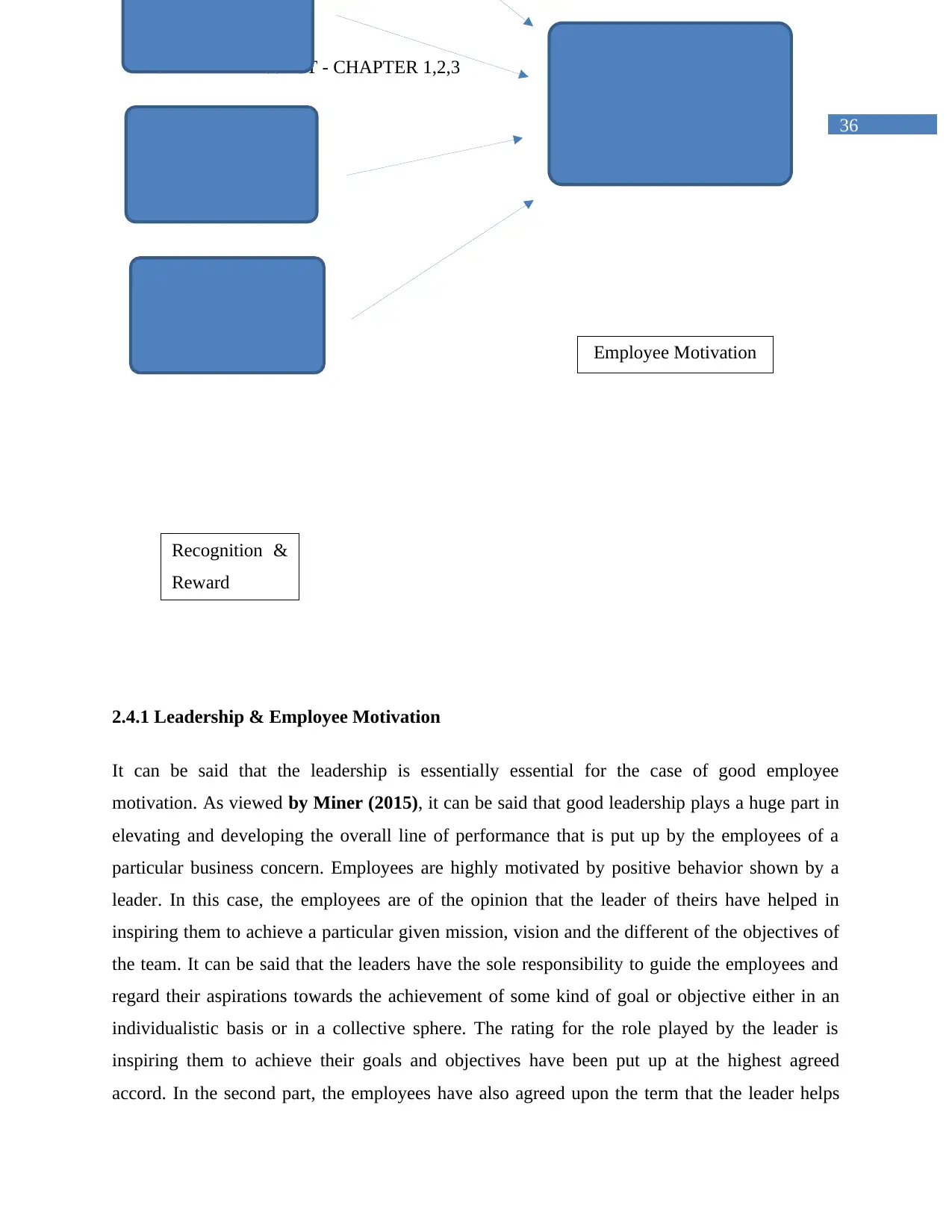
36
2.4.1 Leadership & Employee Motivation
It can be said that the leadership is essentially essential for the case of good employee
motivation. As viewed by Miner (2015), it can be said that good leadership plays a huge part in
elevating and developing the overall line of performance that is put up by the employees of a
particular business concern. Employees are highly motivated by positive behavior shown by a
leader. In this case, the employees are of the opinion that the leader of theirs have helped in
inspiring them to achieve a particular given mission, vision and the different of the objectives of
the team. It can be said that the leaders have the sole responsibility to guide the employees and
regard their aspirations towards the achievement of some kind of goal or objective either in an
individualistic basis or in a collective sphere. The rating for the role played by the leader is
inspiring them to achieve their goals and objectives have been put up at the highest agreed
accord. In the second part, the employees have also agreed upon the term that the leader helps
Employee Motivation
Recognition &
Reward
Paraphrase This Document
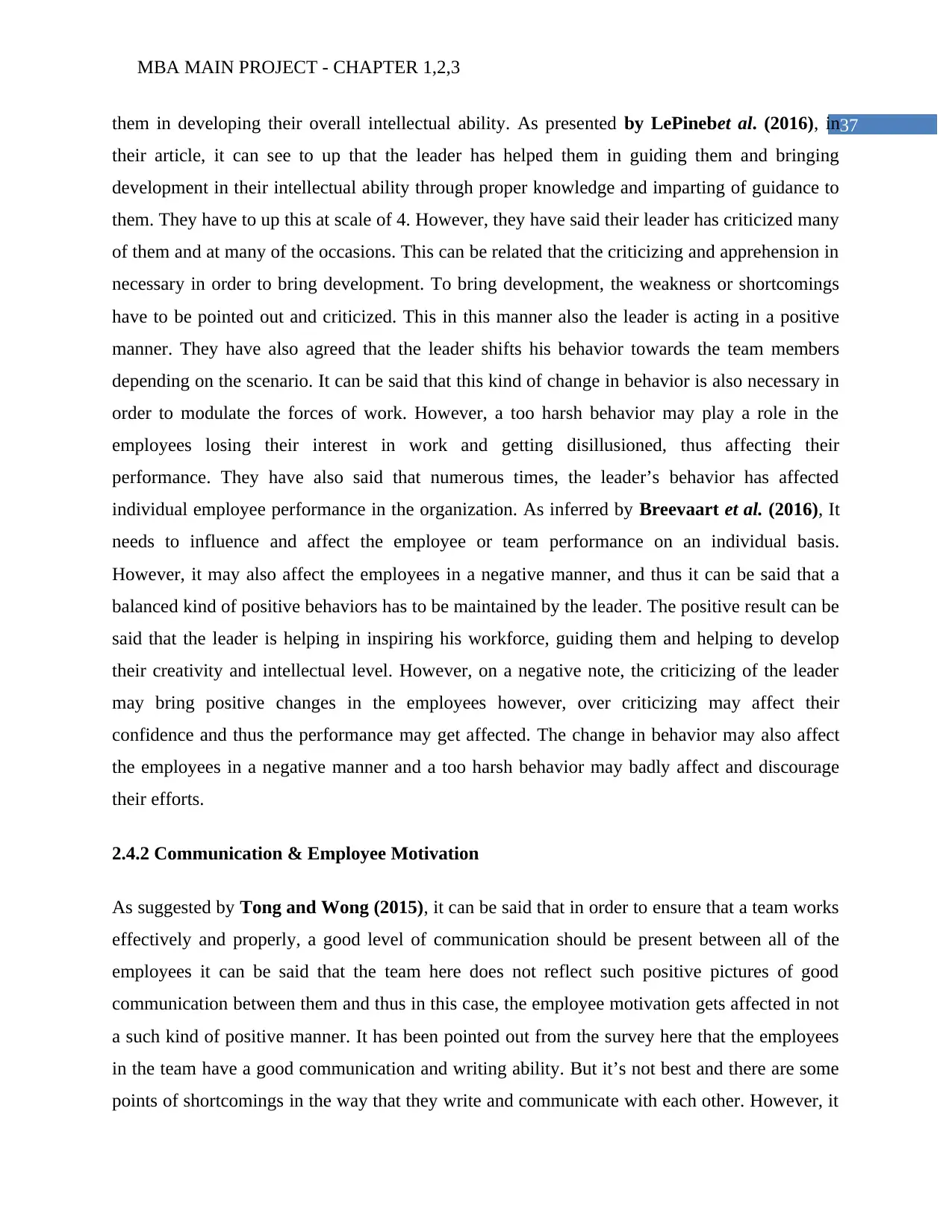
37them in developing their overall intellectual ability. As presented by LePinebet al. (2016), in
their article, it can see to up that the leader has helped them in guiding them and bringing
development in their intellectual ability through proper knowledge and imparting of guidance to
them. They have to up this at scale of 4. However, they have said their leader has criticized many
of them and at many of the occasions. This can be related that the criticizing and apprehension in
necessary in order to bring development. To bring development, the weakness or shortcomings
have to be pointed out and criticized. This in this manner also the leader is acting in a positive
manner. They have also agreed that the leader shifts his behavior towards the team members
depending on the scenario. It can be said that this kind of change in behavior is also necessary in
order to modulate the forces of work. However, a too harsh behavior may play a role in the
employees losing their interest in work and getting disillusioned, thus affecting their
performance. They have also said that numerous times, the leader’s behavior has affected
individual employee performance in the organization. As inferred by Breevaart et al. (2016), It
needs to influence and affect the employee or team performance on an individual basis.
However, it may also affect the employees in a negative manner, and thus it can be said that a
balanced kind of positive behaviors has to be maintained by the leader. The positive result can be
said that the leader is helping in inspiring his workforce, guiding them and helping to develop
their creativity and intellectual level. However, on a negative note, the criticizing of the leader
may bring positive changes in the employees however, over criticizing may affect their
confidence and thus the performance may get affected. The change in behavior may also affect
the employees in a negative manner and a too harsh behavior may badly affect and discourage
their efforts.
2.4.2 Communication & Employee Motivation
As suggested by Tong and Wong (2015), it can be said that in order to ensure that a team works
effectively and properly, a good level of communication should be present between all of the
employees it can be said that the team here does not reflect such positive pictures of good
communication between them and thus in this case, the employee motivation gets affected in not
a such kind of positive manner. It has been pointed out from the survey here that the employees
in the team have a good communication and writing ability. But it’s not best and there are some
points of shortcomings in the way that they write and communicate with each other. However, it
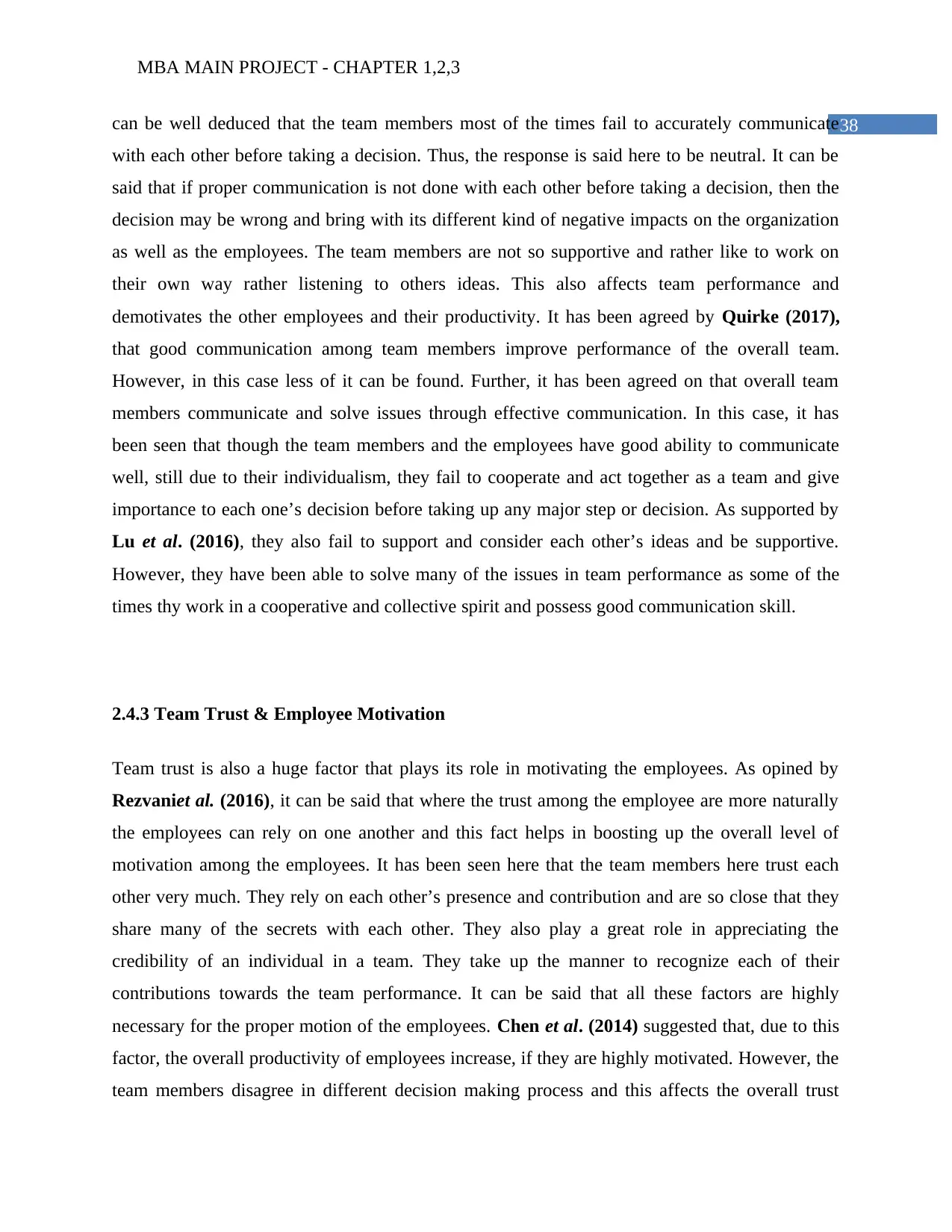
38can be well deduced that the team members most of the times fail to accurately communicate
with each other before taking a decision. Thus, the response is said here to be neutral. It can be
said that if proper communication is not done with each other before taking a decision, then the
decision may be wrong and bring with its different kind of negative impacts on the organization
as well as the employees. The team members are not so supportive and rather like to work on
their own way rather listening to others ideas. This also affects team performance and
demotivates the other employees and their productivity. It has been agreed by Quirke (2017),
that good communication among team members improve performance of the overall team.
However, in this case less of it can be found. Further, it has been agreed on that overall team
members communicate and solve issues through effective communication. In this case, it has
been seen that though the team members and the employees have good ability to communicate
well, still due to their individualism, they fail to cooperate and act together as a team and give
importance to each one’s decision before taking up any major step or decision. As supported by
Lu et al. (2016), they also fail to support and consider each other’s ideas and be supportive.
However, they have been able to solve many of the issues in team performance as some of the
times thy work in a cooperative and collective spirit and possess good communication skill.
2.4.3 Team Trust & Employee Motivation
Team trust is also a huge factor that plays its role in motivating the employees. As opined by
Rezvaniet al. (2016), it can be said that where the trust among the employee are more naturally
the employees can rely on one another and this fact helps in boosting up the overall level of
motivation among the employees. It has been seen here that the team members here trust each
other very much. They rely on each other’s presence and contribution and are so close that they
share many of the secrets with each other. They also play a great role in appreciating the
credibility of an individual in a team. They take up the manner to recognize each of their
contributions towards the team performance. It can be said that all these factors are highly
necessary for the proper motion of the employees. Chen et al. (2014) suggested that, due to this
factor, the overall productivity of employees increase, if they are highly motivated. However, the
team members disagree in different decision making process and this affects the overall trust
⊘ This is a preview!⊘
Do you want full access?
Subscribe today to unlock all pages.

Trusted by 1+ million students worldwide
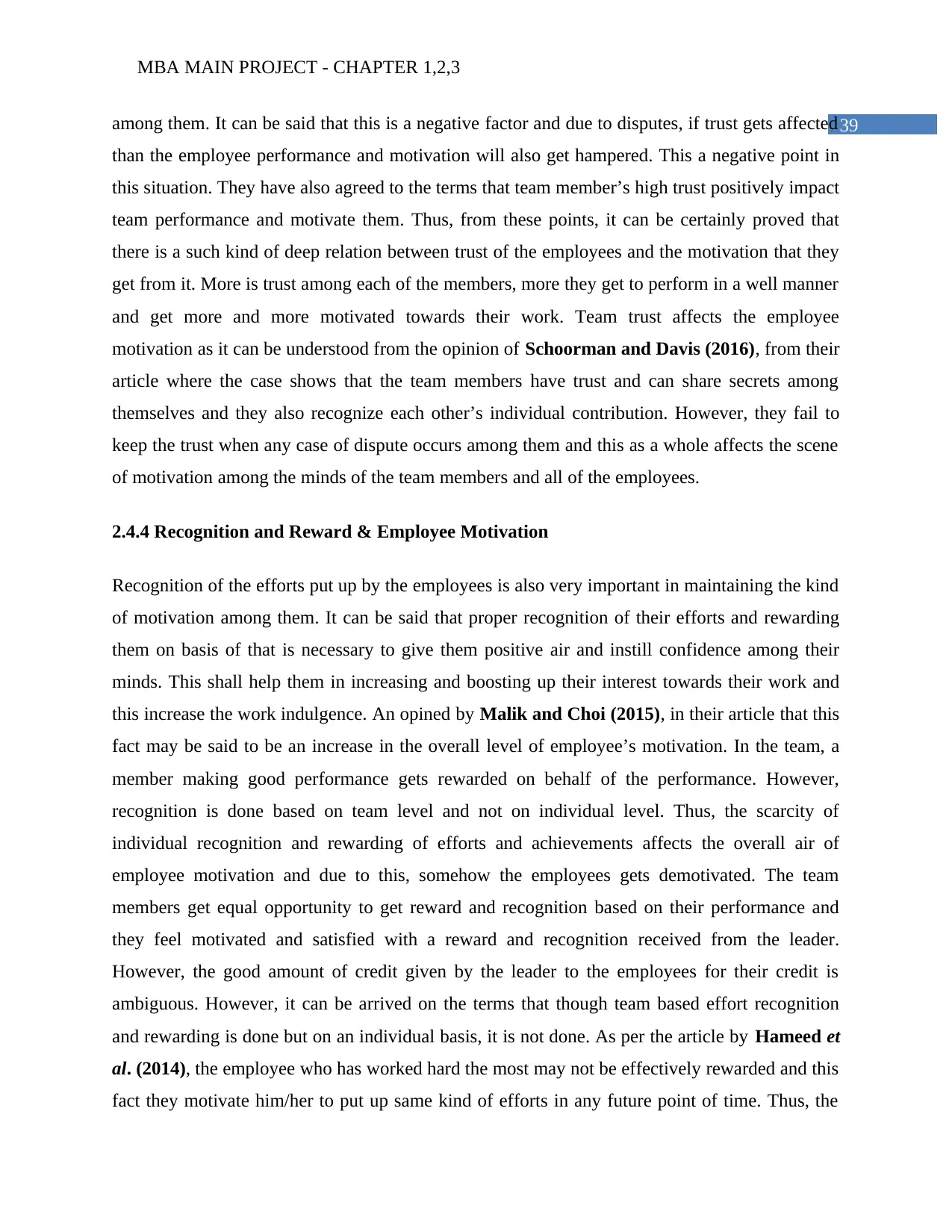
39among them. It can be said that this is a negative factor and due to disputes, if trust gets affected
than the employee performance and motivation will also get hampered. This a negative point in
this situation. They have also agreed to the terms that team member’s high trust positively impact
team performance and motivate them. Thus, from these points, it can be certainly proved that
there is a such kind of deep relation between trust of the employees and the motivation that they
get from it. More is trust among each of the members, more they get to perform in a well manner
and get more and more motivated towards their work. Team trust affects the employee
motivation as it can be understood from the opinion of Schoorman and Davis (2016), from their
article where the case shows that the team members have trust and can share secrets among
themselves and they also recognize each other’s individual contribution. However, they fail to
keep the trust when any case of dispute occurs among them and this as a whole affects the scene
of motivation among the minds of the team members and all of the employees.
2.4.4 Recognition and Reward & Employee Motivation
Recognition of the efforts put up by the employees is also very important in maintaining the kind
of motivation among them. It can be said that proper recognition of their efforts and rewarding
them on basis of that is necessary to give them positive air and instill confidence among their
minds. This shall help them in increasing and boosting up their interest towards their work and
this increase the work indulgence. An opined by Malik and Choi (2015), in their article that this
fact may be said to be an increase in the overall level of employee’s motivation. In the team, a
member making good performance gets rewarded on behalf of the performance. However,
recognition is done based on team level and not on individual level. Thus, the scarcity of
individual recognition and rewarding of efforts and achievements affects the overall air of
employee motivation and due to this, somehow the employees gets demotivated. The team
members get equal opportunity to get reward and recognition based on their performance and
they feel motivated and satisfied with a reward and recognition received from the leader.
However, the good amount of credit given by the leader to the employees for their credit is
ambiguous. However, it can be arrived on the terms that though team based effort recognition
and rewarding is done but on an individual basis, it is not done. As per the article by Hameed et
al. (2014), the employee who has worked hard the most may not be effectively rewarded and this
fact they motivate him/her to put up same kind of efforts in any future point of time. Thus, the
Paraphrase This Document
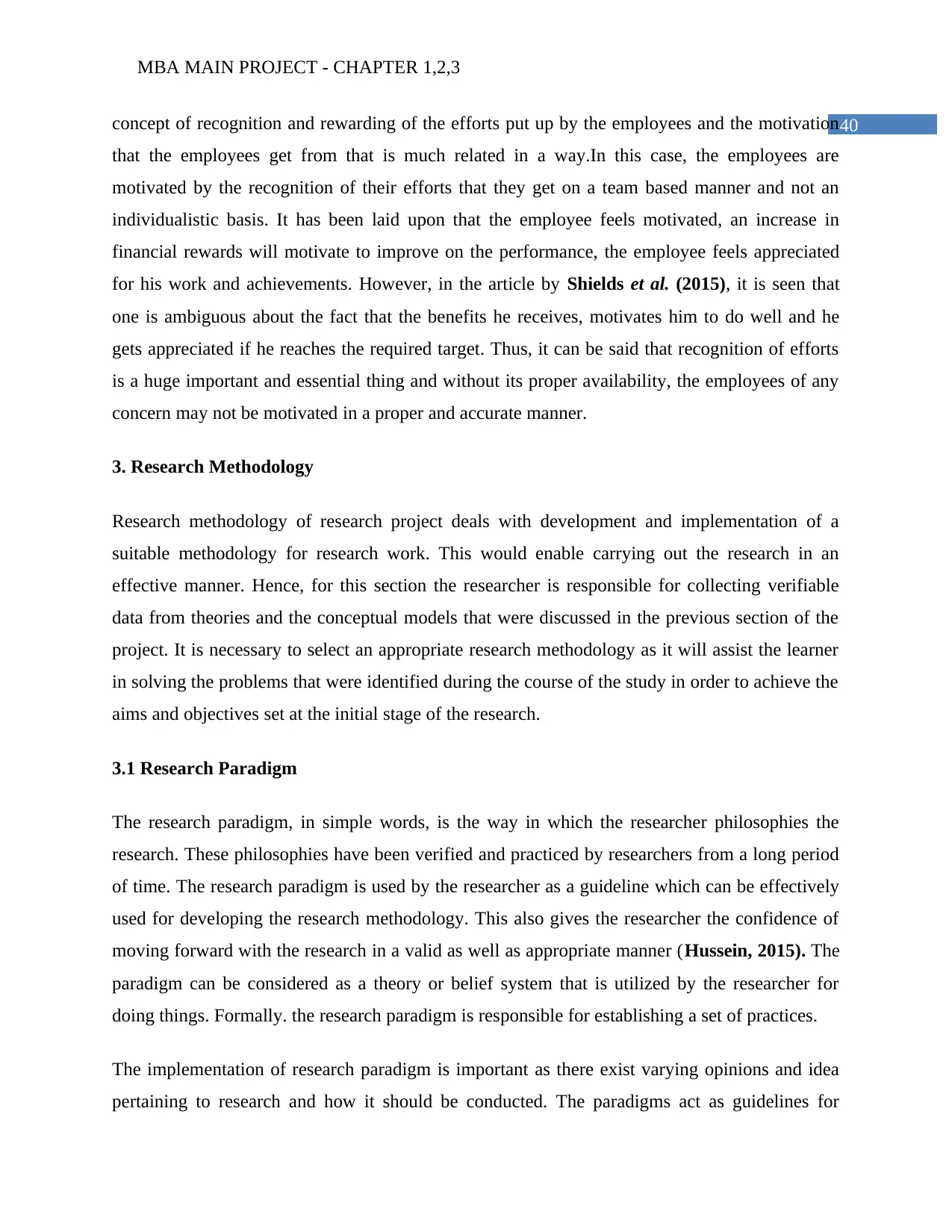
40concept of recognition and rewarding of the efforts put up by the employees and the motivation
that the employees get from that is much related in a way.In this case, the employees are
motivated by the recognition of their efforts that they get on a team based manner and not an
individualistic basis. It has been laid upon that the employee feels motivated, an increase in
financial rewards will motivate to improve on the performance, the employee feels appreciated
for his work and achievements. However, in the article by Shields et al. (2015), it is seen that
one is ambiguous about the fact that the benefits he receives, motivates him to do well and he
gets appreciated if he reaches the required target. Thus, it can be said that recognition of efforts
is a huge important and essential thing and without its proper availability, the employees of any
concern may not be motivated in a proper and accurate manner.
3. Research Methodology
Research methodology of research project deals with development and implementation of a
suitable methodology for research work. This would enable carrying out the research in an
effective manner. Hence, for this section the researcher is responsible for collecting verifiable
data from theories and the conceptual models that were discussed in the previous section of the
project. It is necessary to select an appropriate research methodology as it will assist the learner
in solving the problems that were identified during the course of the study in order to achieve the
aims and objectives set at the initial stage of the research.
3.1 Research Paradigm
The research paradigm, in simple words, is the way in which the researcher philosophies the
research. These philosophies have been verified and practiced by researchers from a long period
of time. The research paradigm is used by the researcher as a guideline which can be effectively
used for developing the research methodology. This also gives the researcher the confidence of
moving forward with the research in a valid as well as appropriate manner (Hussein, 2015). The
paradigm can be considered as a theory or belief system that is utilized by the researcher for
doing things. Formally. the research paradigm is responsible for establishing a set of practices.
The implementation of research paradigm is important as there exist varying opinions and idea
pertaining to research and how it should be conducted. The paradigms act as guidelines for
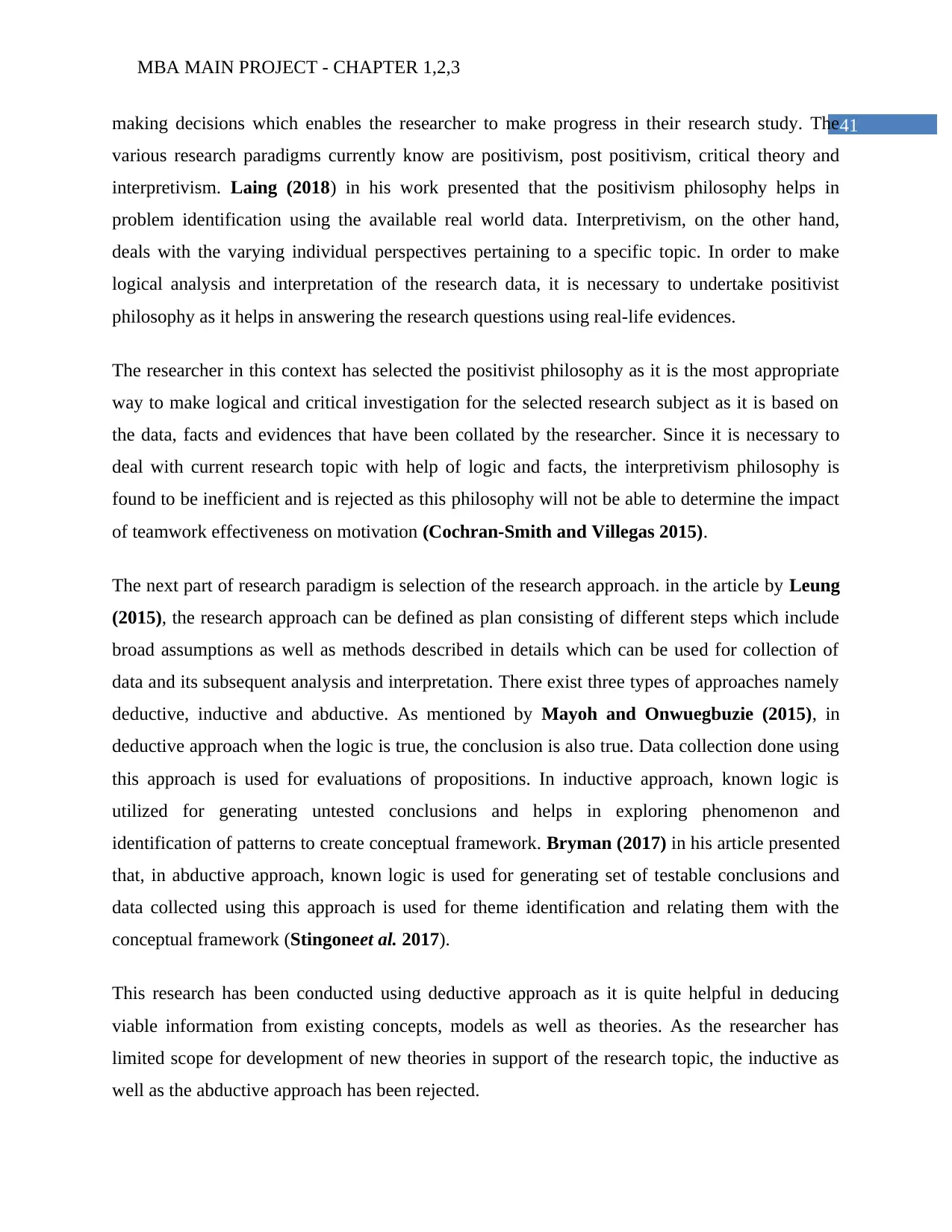
41making decisions which enables the researcher to make progress in their research study. The
various research paradigms currently know are positivism, post positivism, critical theory and
interpretivism. Laing (2018) in his work presented that the positivism philosophy helps in
problem identification using the available real world data. Interpretivism, on the other hand,
deals with the varying individual perspectives pertaining to a specific topic. In order to make
logical analysis and interpretation of the research data, it is necessary to undertake positivist
philosophy as it helps in answering the research questions using real-life evidences.
The researcher in this context has selected the positivist philosophy as it is the most appropriate
way to make logical and critical investigation for the selected research subject as it is based on
the data, facts and evidences that have been collated by the researcher. Since it is necessary to
deal with current research topic with help of logic and facts, the interpretivism philosophy is
found to be inefficient and is rejected as this philosophy will not be able to determine the impact
of teamwork effectiveness on motivation (Cochran-Smith and Villegas 2015).
The next part of research paradigm is selection of the research approach. in the article by Leung
(2015), the research approach can be defined as plan consisting of different steps which include
broad assumptions as well as methods described in details which can be used for collection of
data and its subsequent analysis and interpretation. There exist three types of approaches namely
deductive, inductive and abductive. As mentioned by Mayoh and Onwuegbuzie (2015), in
deductive approach when the logic is true, the conclusion is also true. Data collection done using
this approach is used for evaluations of propositions. In inductive approach, known logic is
utilized for generating untested conclusions and helps in exploring phenomenon and
identification of patterns to create conceptual framework. Bryman (2017) in his article presented
that, in abductive approach, known logic is used for generating set of testable conclusions and
data collected using this approach is used for theme identification and relating them with the
conceptual framework (Stingoneet al. 2017).
This research has been conducted using deductive approach as it is quite helpful in deducing
viable information from existing concepts, models as well as theories. As the researcher has
limited scope for development of new theories in support of the research topic, the inductive as
well as the abductive approach has been rejected.
⊘ This is a preview!⊘
Do you want full access?
Subscribe today to unlock all pages.

Trusted by 1+ million students worldwide
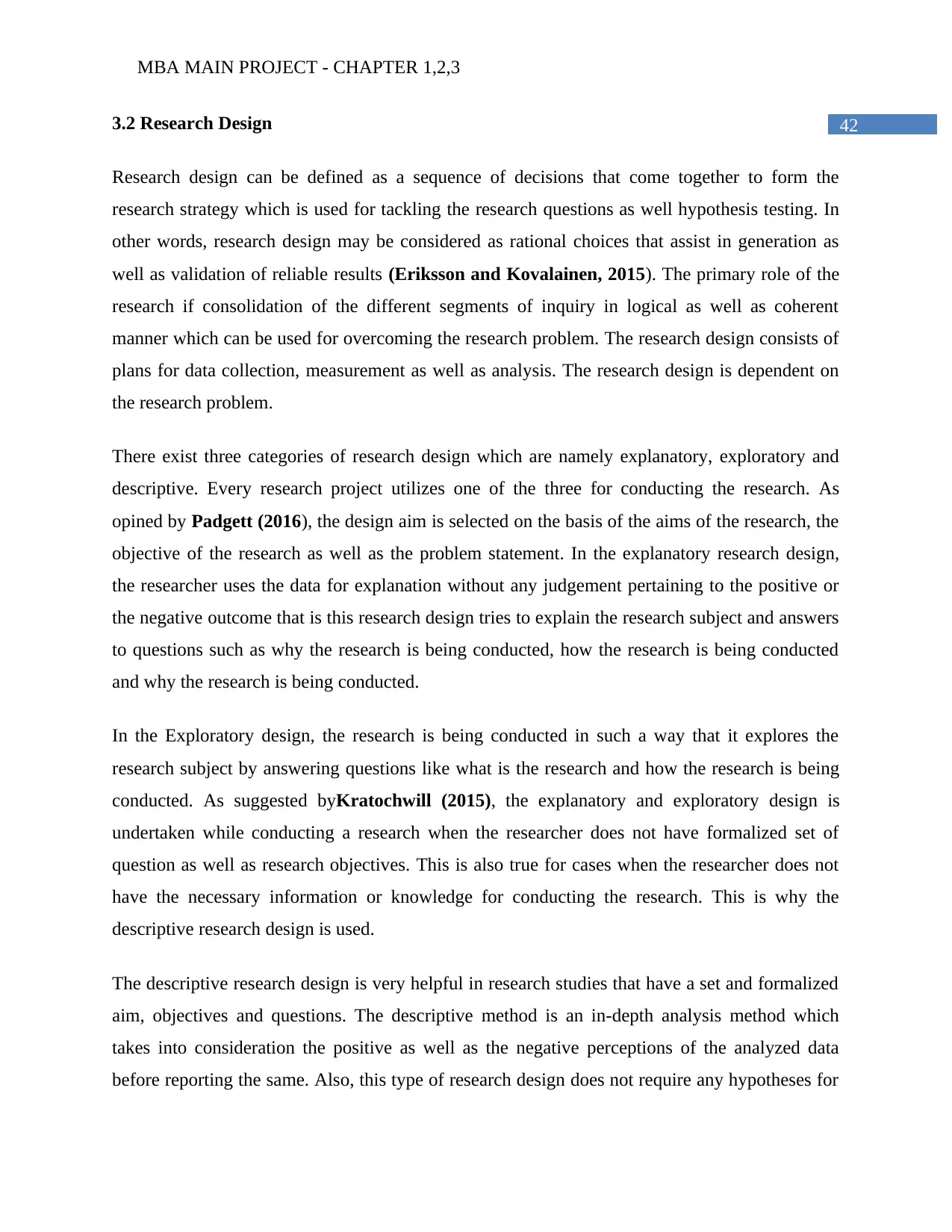
423.2 Research Design
Research design can be defined as a sequence of decisions that come together to form the
research strategy which is used for tackling the research questions as well hypothesis testing. In
other words, research design may be considered as rational choices that assist in generation as
well as validation of reliable results (Eriksson and Kovalainen, 2015). The primary role of the
research if consolidation of the different segments of inquiry in logical as well as coherent
manner which can be used for overcoming the research problem. The research design consists of
plans for data collection, measurement as well as analysis. The research design is dependent on
the research problem.
There exist three categories of research design which are namely explanatory, exploratory and
descriptive. Every research project utilizes one of the three for conducting the research. As
opined by Padgett (2016), the design aim is selected on the basis of the aims of the research, the
objective of the research as well as the problem statement. In the explanatory research design,
the researcher uses the data for explanation without any judgement pertaining to the positive or
the negative outcome that is this research design tries to explain the research subject and answers
to questions such as why the research is being conducted, how the research is being conducted
and why the research is being conducted.
In the Exploratory design, the research is being conducted in such a way that it explores the
research subject by answering questions like what is the research and how the research is being
conducted. As suggested byKratochwill (2015), the explanatory and exploratory design is
undertaken while conducting a research when the researcher does not have formalized set of
question as well as research objectives. This is also true for cases when the researcher does not
have the necessary information or knowledge for conducting the research. This is why the
descriptive research design is used.
The descriptive research design is very helpful in research studies that have a set and formalized
aim, objectives and questions. The descriptive method is an in-depth analysis method which
takes into consideration the positive as well as the negative perceptions of the analyzed data
before reporting the same. Also, this type of research design does not require any hypotheses for
Paraphrase This Document

43initiating (Merriam and Tisdell 2015). The analysis is done by utilizing the existing data that
has been collected as this is theoretical research design type. This design is used for analyzing
human characteristics, socio-economic aspects, mostly data of qualitative nature.
The researcher has already introduced a set of formalized objectives and questions which is
suitable for implementation of the descriptive research design. This design is appropriate for
structured as well as formal research studies. As considered by Walliman (2015), it makes
provision for making in depth analysis of data and this means the researcher is burdened with the
task of identifying and collecting relevant information that is suitable for the purpose of the
research study. Hence, the researcher has adopted the descriptive design for conducting this
research and rejected the explanatory as well as the exploratory research design.
Holloway and Galvin (2016) in their work presented that, one of the disadvantages of using
descriptive design is time constraints as the researcher has the researcher is using a cross
sectional strategy. However, the descriptive design of the research has been supported by the
survey. The primary benefit of utilizing the descriptive design is that in addition to cross
sectional strategy, the descriptive design assists the researcher to analyses a very vast population
in a short span of time.
3.3 Research Strategy
Research strategy is part by part action plan which helps in focusing thoughts and efforts that
enables in conducting the research in a systematic manner to minimize errors and obtain set of
results supported by a detailed report for conducting a research, two types of strategy are
undertaken namely longitudinal and cross-sectional strategy. Longitudinal research is different
from the cross sectional studies (Sekaran and Bougie 2016). While the cross sectional study
takes place in a single time frame using different samples to provide a depiction of the context at
that instant of time, the longitudinal research takes into consideration numerous timeframes and
utilizes the same sample to identify the changes occurring at the individual level.
On the basis of the appropriate approach for conducting the research, the next logical step is
selection of the research strategies to conduct the research. The research strategies that are
available for the current research are survey, case studies, interviews, experiments to name a few.
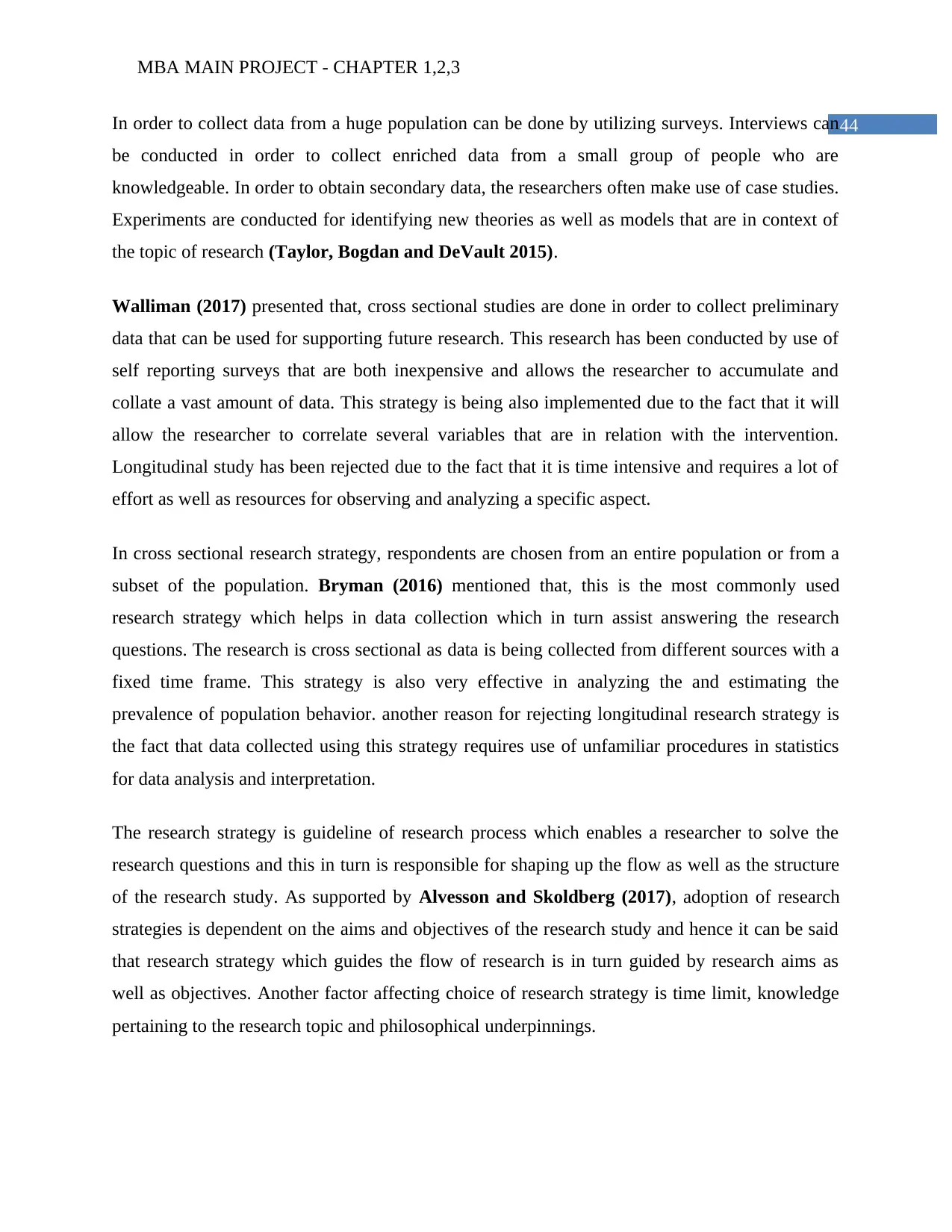
44In order to collect data from a huge population can be done by utilizing surveys. Interviews can
be conducted in order to collect enriched data from a small group of people who are
knowledgeable. In order to obtain secondary data, the researchers often make use of case studies.
Experiments are conducted for identifying new theories as well as models that are in context of
the topic of research (Taylor, Bogdan and DeVault 2015).
Walliman (2017) presented that, cross sectional studies are done in order to collect preliminary
data that can be used for supporting future research. This research has been conducted by use of
self reporting surveys that are both inexpensive and allows the researcher to accumulate and
collate a vast amount of data. This strategy is being also implemented due to the fact that it will
allow the researcher to correlate several variables that are in relation with the intervention.
Longitudinal study has been rejected due to the fact that it is time intensive and requires a lot of
effort as well as resources for observing and analyzing a specific aspect.
In cross sectional research strategy, respondents are chosen from an entire population or from a
subset of the population. Bryman (2016) mentioned that, this is the most commonly used
research strategy which helps in data collection which in turn assist answering the research
questions. The research is cross sectional as data is being collected from different sources with a
fixed time frame. This strategy is also very effective in analyzing the and estimating the
prevalence of population behavior. another reason for rejecting longitudinal research strategy is
the fact that data collected using this strategy requires use of unfamiliar procedures in statistics
for data analysis and interpretation.
The research strategy is guideline of research process which enables a researcher to solve the
research questions and this in turn is responsible for shaping up the flow as well as the structure
of the research study. As supported by Alvesson and Skoldberg (2017), adoption of research
strategies is dependent on the aims and objectives of the research study and hence it can be said
that research strategy which guides the flow of research is in turn guided by research aims as
well as objectives. Another factor affecting choice of research strategy is time limit, knowledge
pertaining to the research topic and philosophical underpinnings.
⊘ This is a preview!⊘
Do you want full access?
Subscribe today to unlock all pages.

Trusted by 1+ million students worldwide
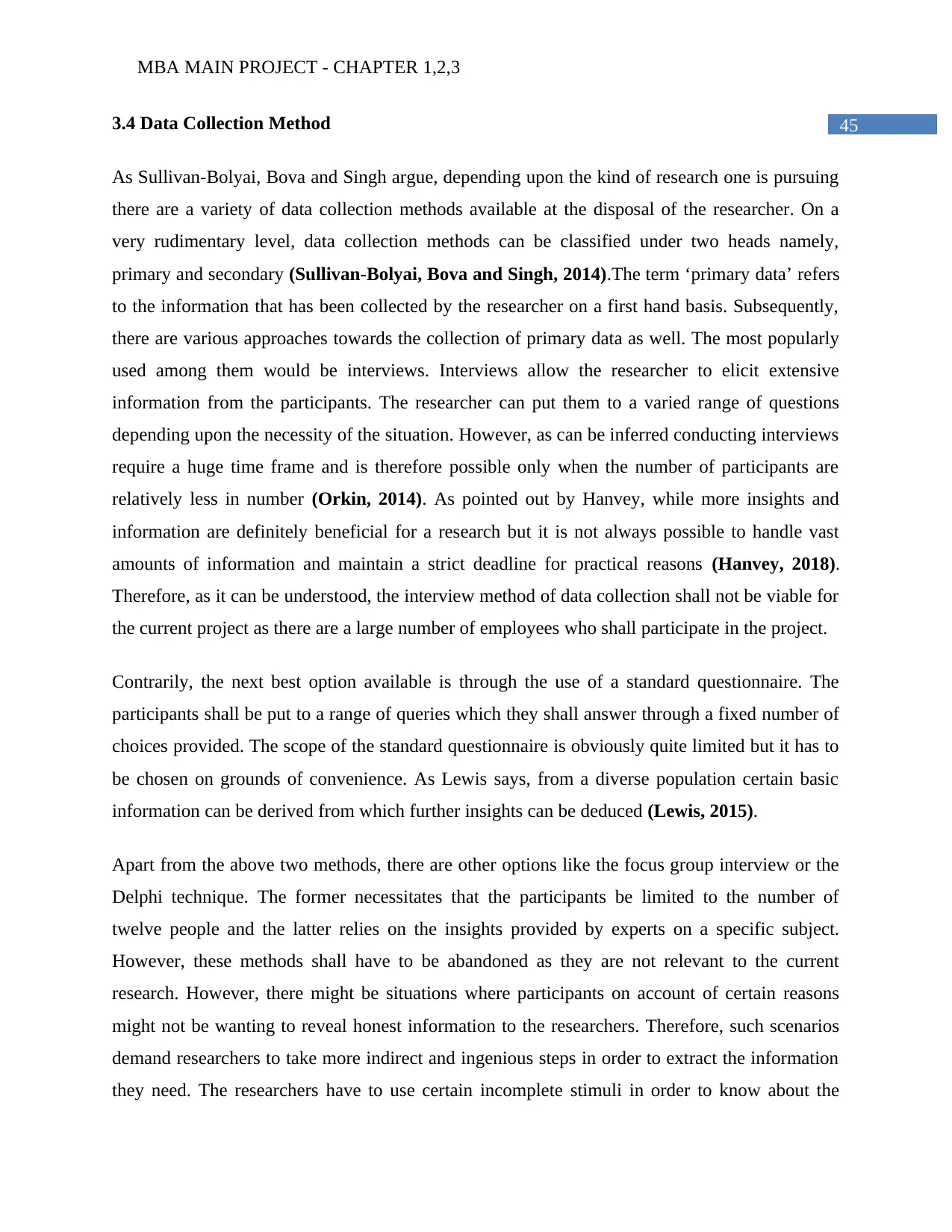
453.4 Data Collection Method
As Sullivan-Bolyai, Bova and Singh argue, depending upon the kind of research one is pursuing
there are a variety of data collection methods available at the disposal of the researcher. On a
very rudimentary level, data collection methods can be classified under two heads namely,
primary and secondary (Sullivan-Bolyai, Bova and Singh, 2014).The term ‘primary data’ refers
to the information that has been collected by the researcher on a first hand basis. Subsequently,
there are various approaches towards the collection of primary data as well. The most popularly
used among them would be interviews. Interviews allow the researcher to elicit extensive
information from the participants. The researcher can put them to a varied range of questions
depending upon the necessity of the situation. However, as can be inferred conducting interviews
require a huge time frame and is therefore possible only when the number of participants are
relatively less in number (Orkin, 2014). As pointed out by Hanvey, while more insights and
information are definitely beneficial for a research but it is not always possible to handle vast
amounts of information and maintain a strict deadline for practical reasons (Hanvey, 2018).
Therefore, as it can be understood, the interview method of data collection shall not be viable for
the current project as there are a large number of employees who shall participate in the project.
Contrarily, the next best option available is through the use of a standard questionnaire. The
participants shall be put to a range of queries which they shall answer through a fixed number of
choices provided. The scope of the standard questionnaire is obviously quite limited but it has to
be chosen on grounds of convenience. As Lewis says, from a diverse population certain basic
information can be derived from which further insights can be deduced (Lewis, 2015).
Apart from the above two methods, there are other options like the focus group interview or the
Delphi technique. The former necessitates that the participants be limited to the number of
twelve people and the latter relies on the insights provided by experts on a specific subject.
However, these methods shall have to be abandoned as they are not relevant to the current
research. However, there might be situations where participants on account of certain reasons
might not be wanting to reveal honest information to the researchers. Therefore, such scenarios
demand researchers to take more indirect and ingenious steps in order to extract the information
they need. The researchers have to use certain incomplete stimuli in order to know about the
Paraphrase This Document

46underlying intentions and concealed emotions of the participants as formulated by Lin, Xu,
Rainer, Rice, Spence and Lachlan (Lin et al. 2017). Such techniques are known as Projective
techniques.
Speaking about secondary method of research, it involves references to the research
accomplished by others in order to build a hypothesis. The characteristic of a well-balanced
research project would be a perfect amalgamation of both primary and secondary methods as has
been put forward by Taylor, Bogdan and DeVault(Taylor et al. 2015). While primary research
lays the basic foundation of the research in the form of data, secondary research supplies the
additional knowledge that is required in order to contextualize the current situation and make it
more relevant.
Therefore, certain aspects of secondary methods shall also have to be applied in order to deal
with the data that shall be collected. From a quite different perspective we can also look at the
project from the lenses of quantitative and qualitative research. The data that has to be worked
with shall be of quantitative nature as the questionnaire is closed-ended. Participants shall have
to choose from a limited number of responses that shall be provided in the questionnaire itself.
However, this does not mean that all forms of qualitative approaches shall be not opted for. It
must be understood that qualitative research is a necessity in all kinds of research projects as not
only does other sources of information allow the researcher to build up on the current research
project as Glesne says (Glesne, 2015) but also provides the relevant background to the research
by being conscious about the present state of knowledge available in the required area
(Silverman, 2015). And Bernard, Wutich and Ryan opines that it also aids in the creation of new
avenues of knowledge and a certain degree of academic consciousness can be crucial in shedding
light upon the prevailing gaps in the current understanding of the topic (Bernard et al. 2016).
Therefore, from the above section it can be known that although a primary method through
questionnaire shall be the basic foundation of the research, secondary approaches coupled with
qualitative techniques shall be of aid the building of insights (Creswell and Creswell, 2017).
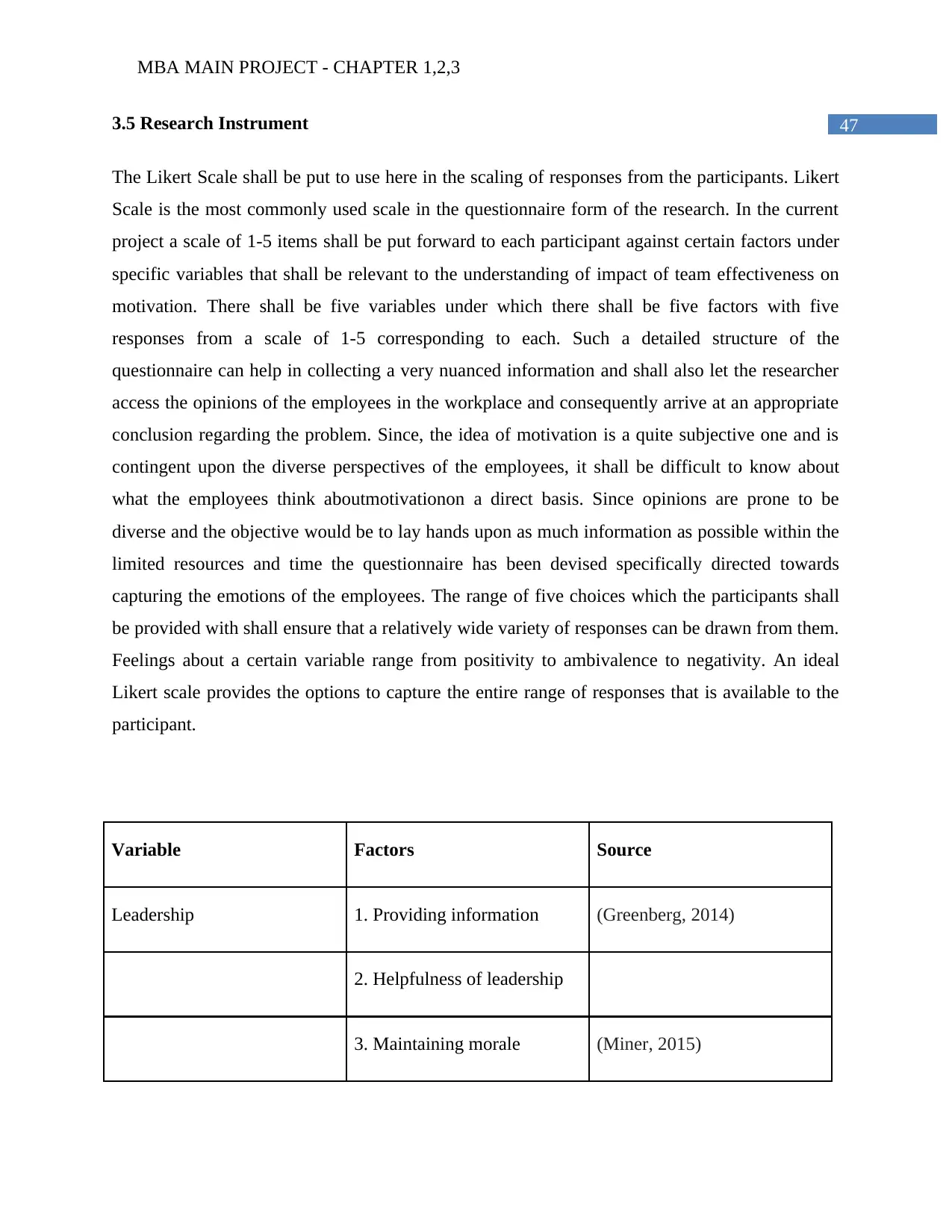
473.5 Research Instrument
The Likert Scale shall be put to use here in the scaling of responses from the participants. Likert
Scale is the most commonly used scale in the questionnaire form of the research. In the current
project a scale of 1-5 items shall be put forward to each participant against certain factors under
specific variables that shall be relevant to the understanding of impact of team effectiveness on
motivation. There shall be five variables under which there shall be five factors with five
responses from a scale of 1-5 corresponding to each. Such a detailed structure of the
questionnaire can help in collecting a very nuanced information and shall also let the researcher
access the opinions of the employees in the workplace and consequently arrive at an appropriate
conclusion regarding the problem. Since, the idea of motivation is a quite subjective one and is
contingent upon the diverse perspectives of the employees, it shall be difficult to know about
what the employees think aboutmotivationon a direct basis. Since opinions are prone to be
diverse and the objective would be to lay hands upon as much information as possible within the
limited resources and time the questionnaire has been devised specifically directed towards
capturing the emotions of the employees. The range of five choices which the participants shall
be provided with shall ensure that a relatively wide variety of responses can be drawn from them.
Feelings about a certain variable range from positivity to ambivalence to negativity. An ideal
Likert scale provides the options to capture the entire range of responses that is available to the
participant.
Variable Factors Source
Leadership 1. Providing information (Greenberg, 2014)
2. Helpfulness of leadership
3. Maintaining morale (Miner, 2015)
⊘ This is a preview!⊘
Do you want full access?
Subscribe today to unlock all pages.

Trusted by 1+ million students worldwide

48
4. Judiciousness
5. Impact upon employees
Communication 1.Proficiency of team
members
(Karangeset al. 2015)
2. Democratic functioning
3. Receptiveness of members
4.Relationship between
communication and
performance
5.Prevailing state of
communication
Team Trust 1. Trustworthiness
2. Personal intimacy
3. Individual credibility
4. Effect of differences on
trust
5. Role in motivation and
performance
Paraphrase This Document
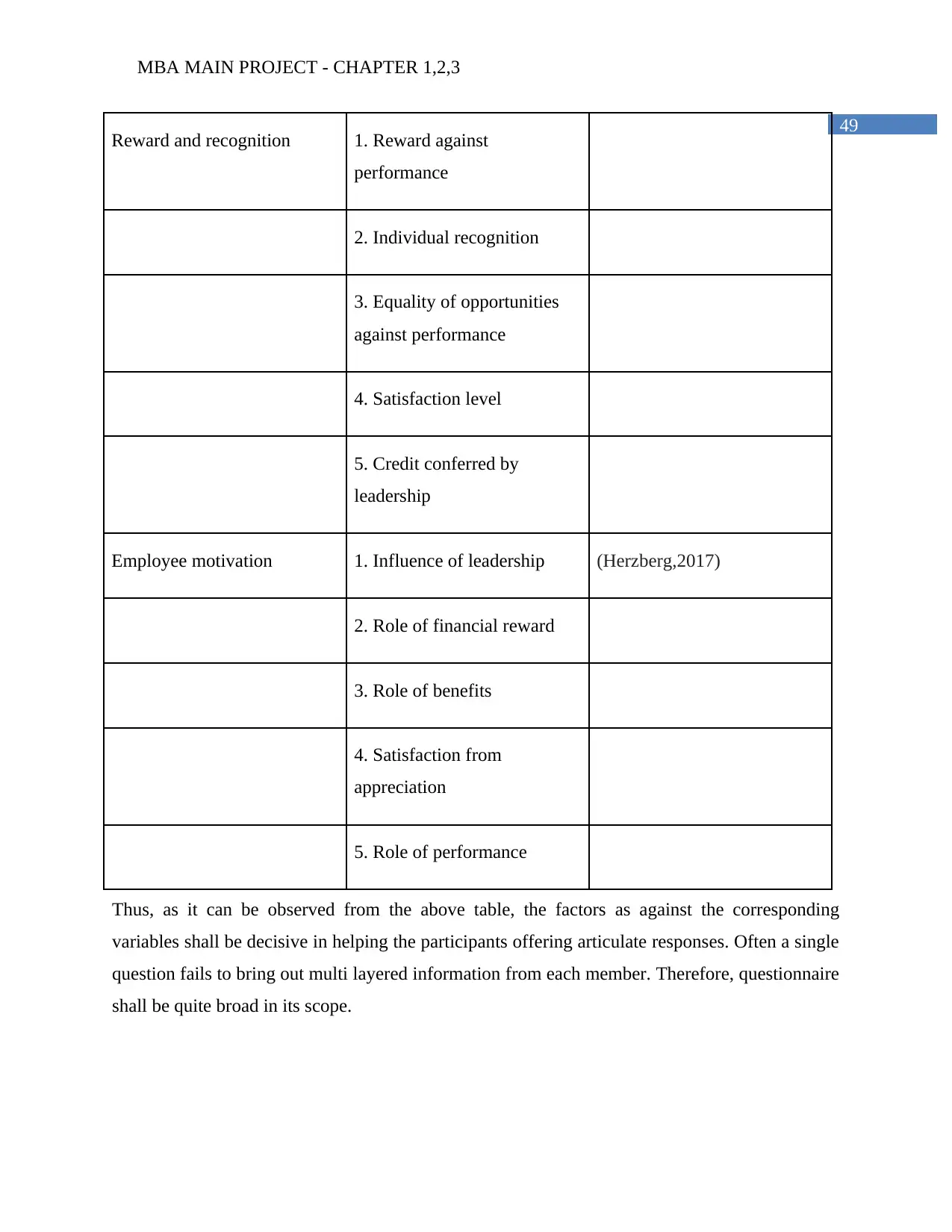
49
Reward and recognition 1. Reward against
performance
2. Individual recognition
3. Equality of opportunities
against performance
4. Satisfaction level
5. Credit conferred by
leadership
Employee motivation 1. Influence of leadership (Herzberg,2017)
2. Role of financial reward
3. Role of benefits
4. Satisfaction from
appreciation
5. Role of performance
Thus, as it can be observed from the above table, the factors as against the corresponding
variables shall be decisive in helping the participants offering articulate responses. Often a single
question fails to bring out multi layered information from each member. Therefore, questionnaire
shall be quite broad in its scope.
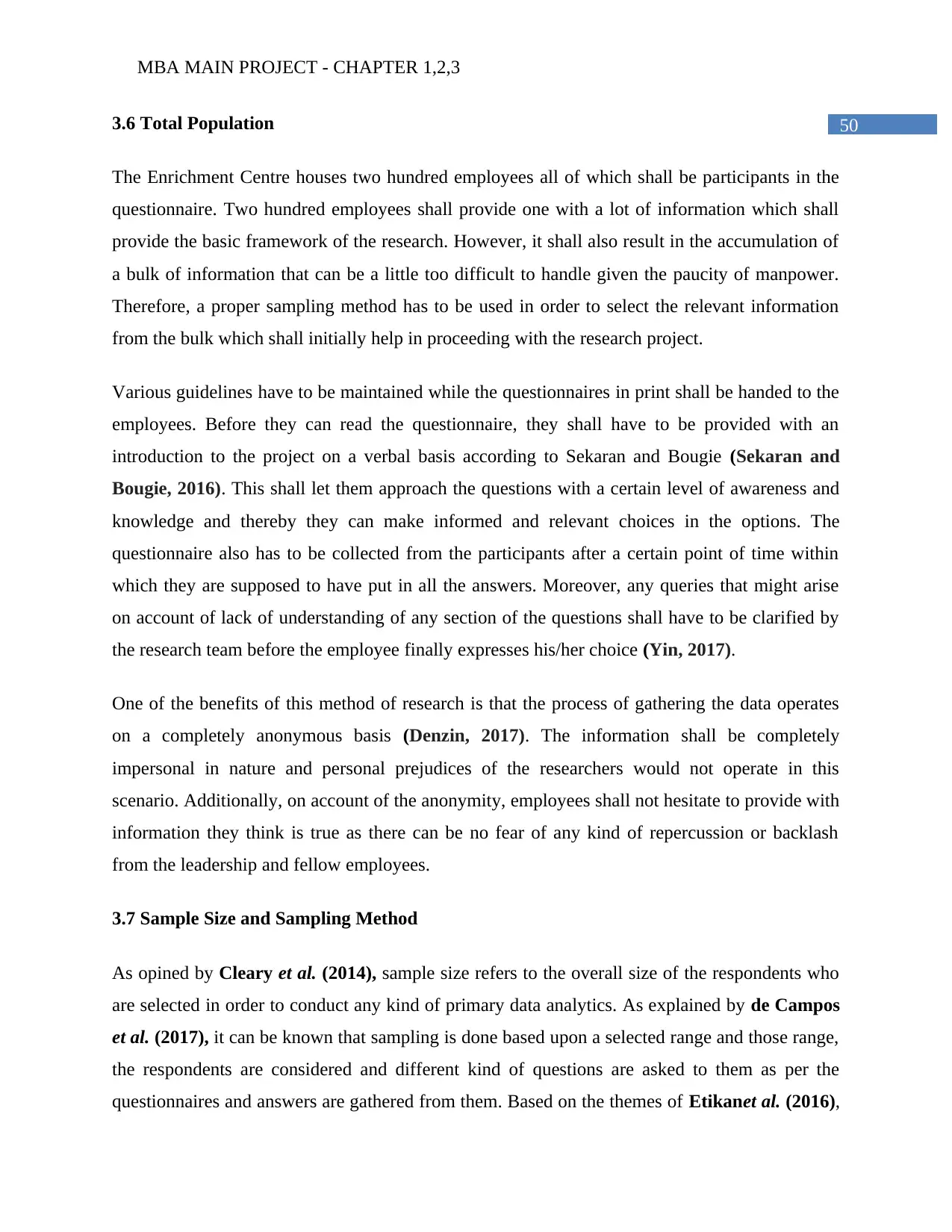
503.6 Total Population
The Enrichment Centre houses two hundred employees all of which shall be participants in the
questionnaire. Two hundred employees shall provide one with a lot of information which shall
provide the basic framework of the research. However, it shall also result in the accumulation of
a bulk of information that can be a little too difficult to handle given the paucity of manpower.
Therefore, a proper sampling method has to be used in order to select the relevant information
from the bulk which shall initially help in proceeding with the research project.
Various guidelines have to be maintained while the questionnaires in print shall be handed to the
employees. Before they can read the questionnaire, they shall have to be provided with an
introduction to the project on a verbal basis according to Sekaran and Bougie (Sekaran and
Bougie, 2016). This shall let them approach the questions with a certain level of awareness and
knowledge and thereby they can make informed and relevant choices in the options. The
questionnaire also has to be collected from the participants after a certain point of time within
which they are supposed to have put in all the answers. Moreover, any queries that might arise
on account of lack of understanding of any section of the questions shall have to be clarified by
the research team before the employee finally expresses his/her choice (Yin, 2017).
One of the benefits of this method of research is that the process of gathering the data operates
on a completely anonymous basis (Denzin, 2017). The information shall be completely
impersonal in nature and personal prejudices of the researchers would not operate in this
scenario. Additionally, on account of the anonymity, employees shall not hesitate to provide with
information they think is true as there can be no fear of any kind of repercussion or backlash
from the leadership and fellow employees.
3.7 Sample Size and Sampling Method
As opined by Cleary et al. (2014), sample size refers to the overall size of the respondents who
are selected in order to conduct any kind of primary data analytics. As explained by de Campos
et al. (2017), it can be known that sampling is done based upon a selected range and those range,
the respondents are considered and different kind of questions are asked to them as per the
questionnaires and answers are gathered from them. Based on the themes of Etikanet al. (2016),
⊘ This is a preview!⊘
Do you want full access?
Subscribe today to unlock all pages.

Trusted by 1+ million students worldwide
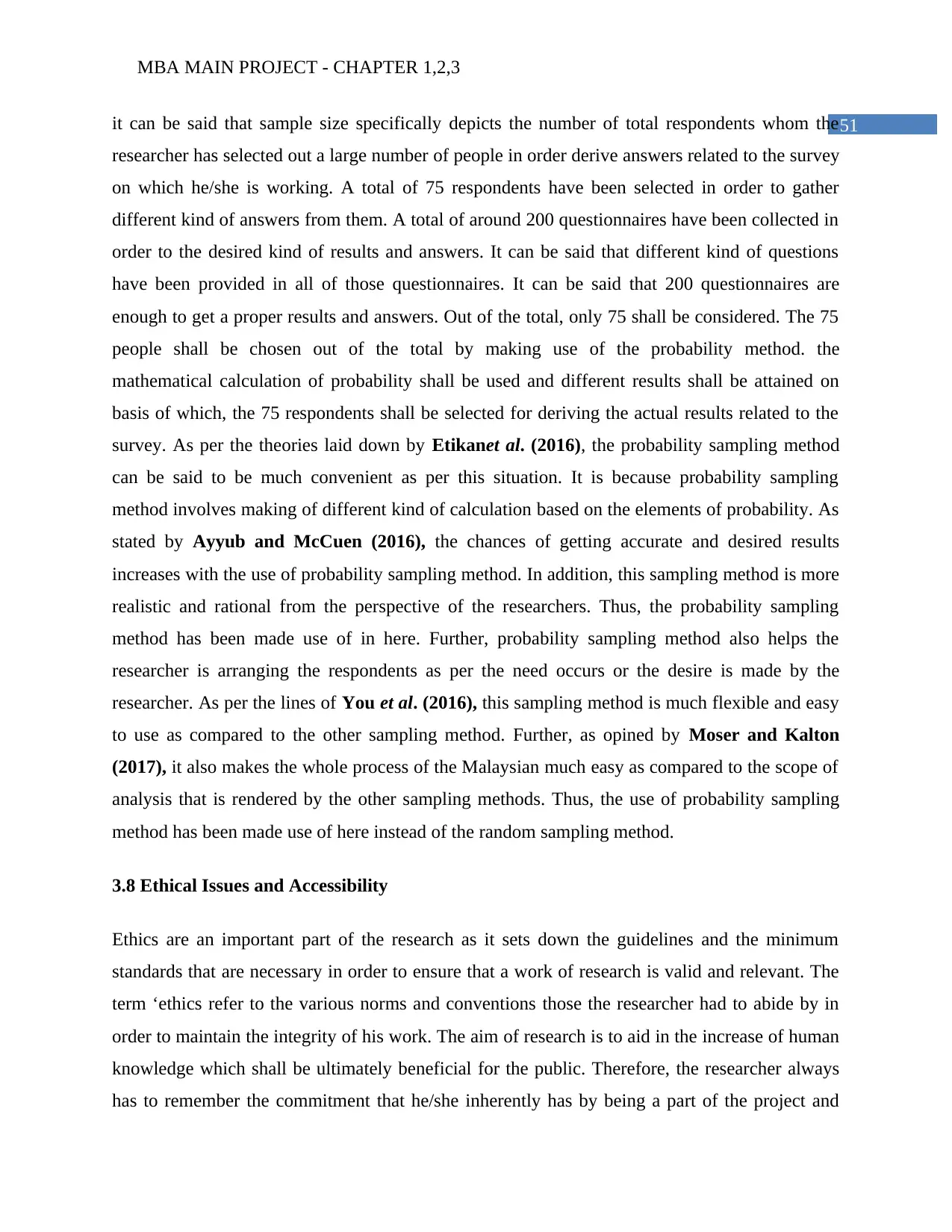
51it can be said that sample size specifically depicts the number of total respondents whom the
researcher has selected out a large number of people in order derive answers related to the survey
on which he/she is working. A total of 75 respondents have been selected in order to gather
different kind of answers from them. A total of around 200 questionnaires have been collected in
order to the desired kind of results and answers. It can be said that different kind of questions
have been provided in all of those questionnaires. It can be said that 200 questionnaires are
enough to get a proper results and answers. Out of the total, only 75 shall be considered. The 75
people shall be chosen out of the total by making use of the probability method. the
mathematical calculation of probability shall be used and different results shall be attained on
basis of which, the 75 respondents shall be selected for deriving the actual results related to the
survey. As per the theories laid down by Etikanet al. (2016), the probability sampling method
can be said to be much convenient as per this situation. It is because probability sampling
method involves making of different kind of calculation based on the elements of probability. As
stated by Ayyub and McCuen (2016), the chances of getting accurate and desired results
increases with the use of probability sampling method. In addition, this sampling method is more
realistic and rational from the perspective of the researchers. Thus, the probability sampling
method has been made use of in here. Further, probability sampling method also helps the
researcher is arranging the respondents as per the need occurs or the desire is made by the
researcher. As per the lines of You et al. (2016), this sampling method is much flexible and easy
to use as compared to the other sampling method. Further, as opined by Moser and Kalton
(2017), it also makes the whole process of the Malaysian much easy as compared to the scope of
analysis that is rendered by the other sampling methods. Thus, the use of probability sampling
method has been made use of here instead of the random sampling method.
3.8 Ethical Issues and Accessibility
Ethics are an important part of the research as it sets down the guidelines and the minimum
standards that are necessary in order to ensure that a work of research is valid and relevant. The
term ‘ethics refer to the various norms and conventions those the researcher had to abide by in
order to maintain the integrity of his work. The aim of research is to aid in the increase of human
knowledge which shall be ultimately beneficial for the public. Therefore, the researcher always
has to remember the commitment that he/she inherently has by being a part of the project and
Paraphrase This Document
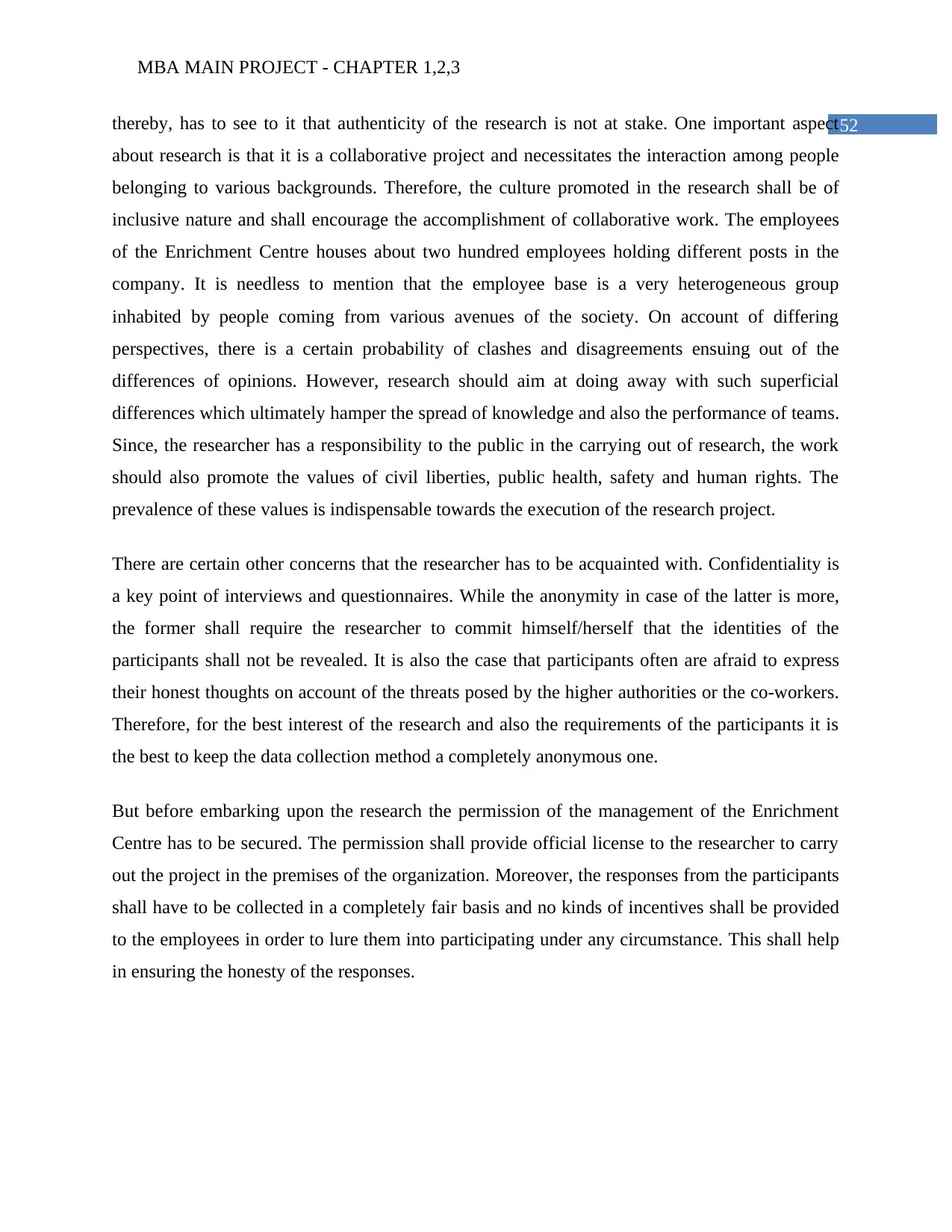
52thereby, has to see to it that authenticity of the research is not at stake. One important aspect
about research is that it is a collaborative project and necessitates the interaction among people
belonging to various backgrounds. Therefore, the culture promoted in the research shall be of
inclusive nature and shall encourage the accomplishment of collaborative work. The employees
of the Enrichment Centre houses about two hundred employees holding different posts in the
company. It is needless to mention that the employee base is a very heterogeneous group
inhabited by people coming from various avenues of the society. On account of differing
perspectives, there is a certain probability of clashes and disagreements ensuing out of the
differences of opinions. However, research should aim at doing away with such superficial
differences which ultimately hamper the spread of knowledge and also the performance of teams.
Since, the researcher has a responsibility to the public in the carrying out of research, the work
should also promote the values of civil liberties, public health, safety and human rights. The
prevalence of these values is indispensable towards the execution of the research project.
There are certain other concerns that the researcher has to be acquainted with. Confidentiality is
a key point of interviews and questionnaires. While the anonymity in case of the latter is more,
the former shall require the researcher to commit himself/herself that the identities of the
participants shall not be revealed. It is also the case that participants often are afraid to express
their honest thoughts on account of the threats posed by the higher authorities or the co-workers.
Therefore, for the best interest of the research and also the requirements of the participants it is
the best to keep the data collection method a completely anonymous one.
But before embarking upon the research the permission of the management of the Enrichment
Centre has to be secured. The permission shall provide official license to the researcher to carry
out the project in the premises of the organization. Moreover, the responses from the participants
shall have to be collected in a completely fair basis and no kinds of incentives shall be provided
to the employees in order to lure them into participating under any circumstance. This shall help
in ensuring the honesty of the responses.
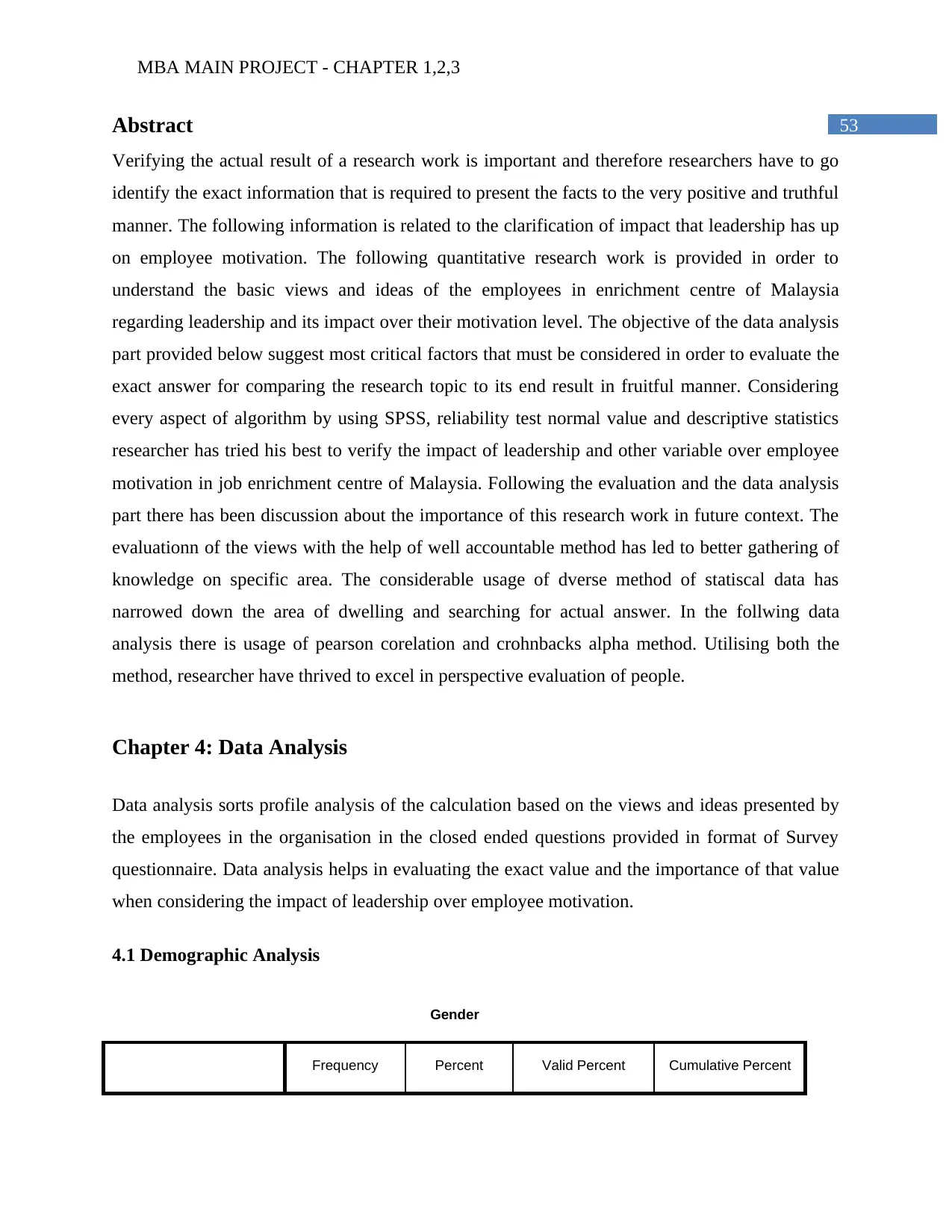
53Abstract
Verifying the actual result of a research work is important and therefore researchers have to go
identify the exact information that is required to present the facts to the very positive and truthful
manner. The following information is related to the clarification of impact that leadership has up
on employee motivation. The following quantitative research work is provided in order to
understand the basic views and ideas of the employees in enrichment centre of Malaysia
regarding leadership and its impact over their motivation level. The objective of the data analysis
part provided below suggest most critical factors that must be considered in order to evaluate the
exact answer for comparing the research topic to its end result in fruitful manner. Considering
every aspect of algorithm by using SPSS, reliability test normal value and descriptive statistics
researcher has tried his best to verify the impact of leadership and other variable over employee
motivation in job enrichment centre of Malaysia. Following the evaluation and the data analysis
part there has been discussion about the importance of this research work in future context. The
evaluationn of the views with the help of well accountable method has led to better gathering of
knowledge on specific area. The considerable usage of dverse method of statiscal data has
narrowed down the area of dwelling and searching for actual answer. In the follwing data
analysis there is usage of pearson corelation and crohnbacks alpha method. Utilising both the
method, researcher have thrived to excel in perspective evaluation of people.
Chapter 4: Data Analysis
Data analysis sorts profile analysis of the calculation based on the views and ideas presented by
the employees in the organisation in the closed ended questions provided in format of Survey
questionnaire. Data analysis helps in evaluating the exact value and the importance of that value
when considering the impact of leadership over employee motivation.
4.1 Demographic Analysis
Gender
Frequency Percent Valid Percent Cumulative Percent
⊘ This is a preview!⊘
Do you want full access?
Subscribe today to unlock all pages.

Trusted by 1+ million students worldwide
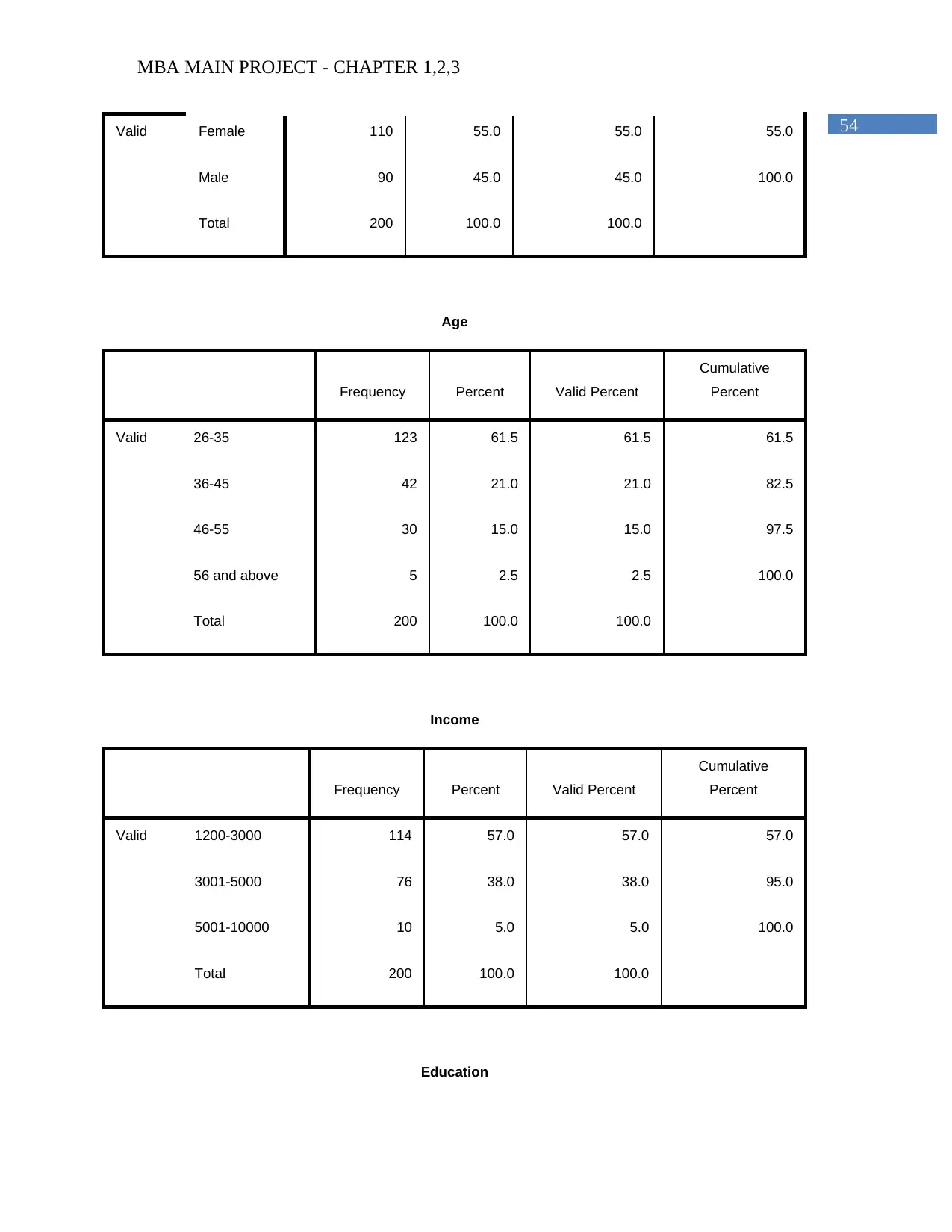
54Valid Female 110 55.0 55.0 55.0
Male 90 45.0 45.0 100.0
Total 200 100.0 100.0
Age
Frequency Percent Valid Percent
Cumulative
Percent
Valid 26-35 123 61.5 61.5 61.5
36-45 42 21.0 21.0 82.5
46-55 30 15.0 15.0 97.5
56 and above 5 2.5 2.5 100.0
Total 200 100.0 100.0
Income
Frequency Percent Valid Percent
Cumulative
Percent
Valid 1200-3000 114 57.0 57.0 57.0
3001-5000 76 38.0 38.0 95.0
5001-10000 10 5.0 5.0 100.0
Total 200 100.0 100.0
Education
Paraphrase This Document
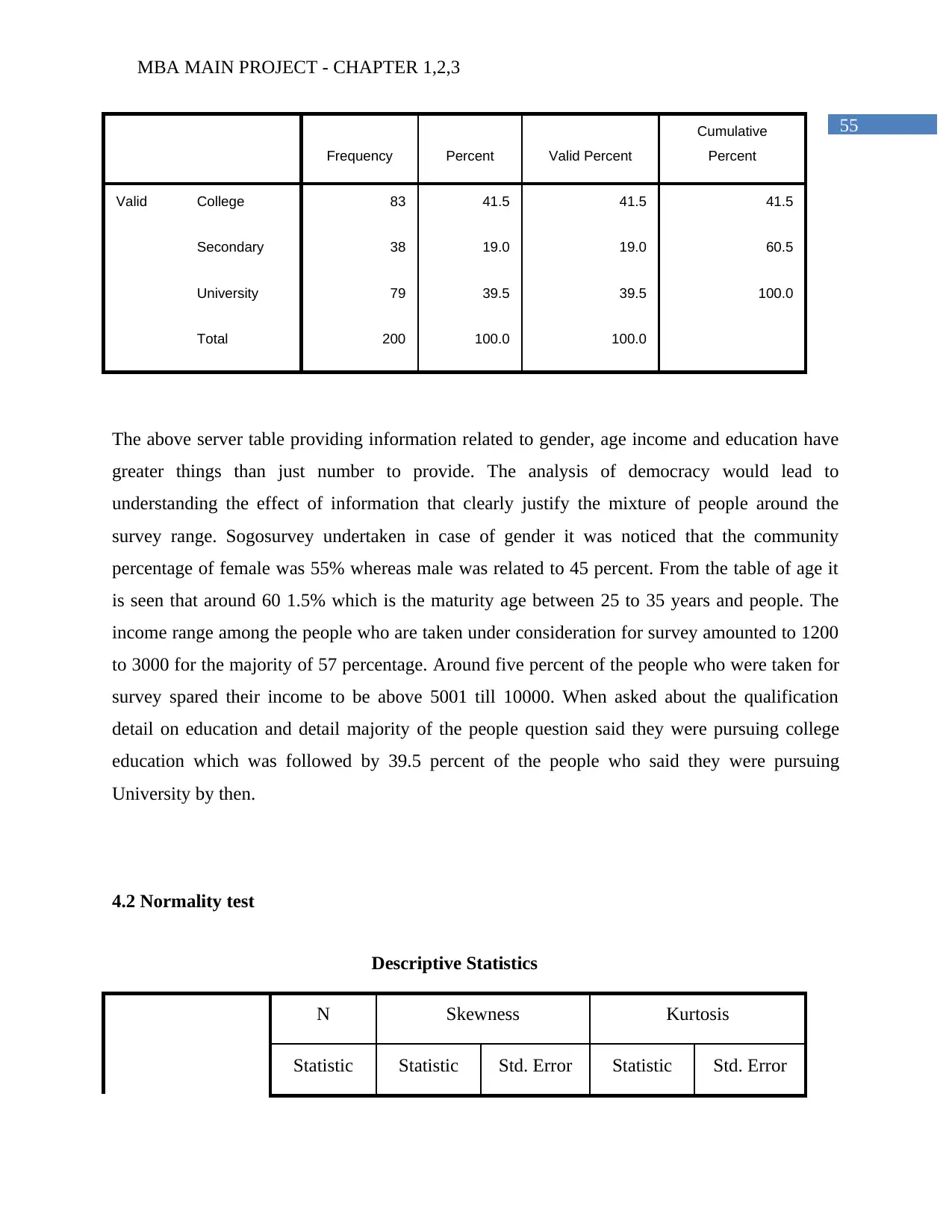
55
Frequency Percent Valid Percent
Cumulative
Percent
Valid College 83 41.5 41.5 41.5
Secondary 38 19.0 19.0 60.5
University 79 39.5 39.5 100.0
Total 200 100.0 100.0
The above server table providing information related to gender, age income and education have
greater things than just number to provide. The analysis of democracy would lead to
understanding the effect of information that clearly justify the mixture of people around the
survey range. Sogosurvey undertaken in case of gender it was noticed that the community
percentage of female was 55% whereas male was related to 45 percent. From the table of age it
is seen that around 60 1.5% which is the maturity age between 25 to 35 years and people. The
income range among the people who are taken under consideration for survey amounted to 1200
to 3000 for the majority of 57 percentage. Around five percent of the people who were taken for
survey spared their income to be above 5001 till 10000. When asked about the qualification
detail on education and detail majority of the people question said they were pursuing college
education which was followed by 39.5 percent of the people who said they were pursuing
University by then.
4.2 Normality test
Descriptive Statistics
N Skewness Kurtosis
Statistic Statistic Std. Error Statistic Std. Error
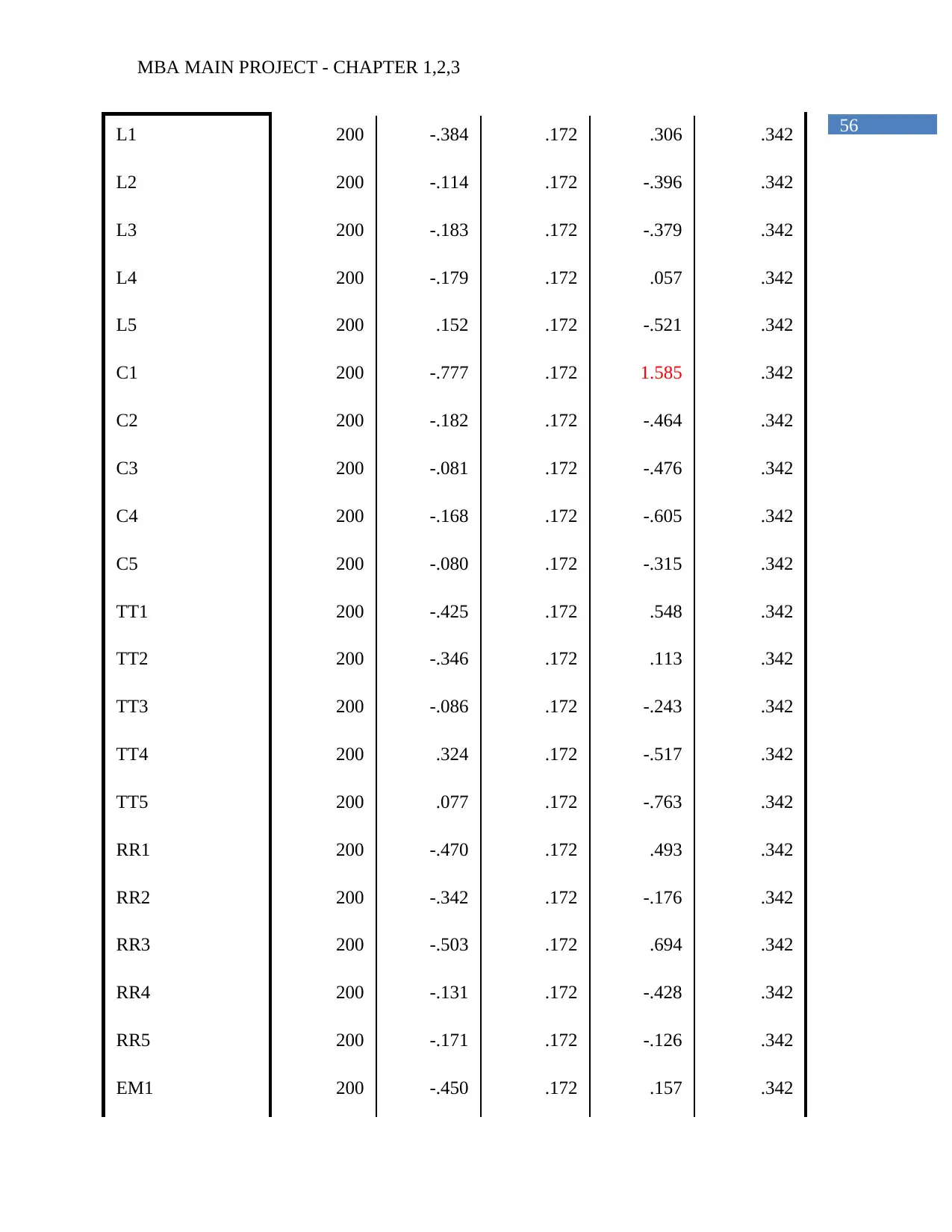
56L1 200 -.384 .172 .306 .342
L2 200 -.114 .172 -.396 .342
L3 200 -.183 .172 -.379 .342
L4 200 -.179 .172 .057 .342
L5 200 .152 .172 -.521 .342
C1 200 -.777 .172 1.585 .342
C2 200 -.182 .172 -.464 .342
C3 200 -.081 .172 -.476 .342
C4 200 -.168 .172 -.605 .342
C5 200 -.080 .172 -.315 .342
TT1 200 -.425 .172 .548 .342
TT2 200 -.346 .172 .113 .342
TT3 200 -.086 .172 -.243 .342
TT4 200 .324 .172 -.517 .342
TT5 200 .077 .172 -.763 .342
RR1 200 -.470 .172 .493 .342
RR2 200 -.342 .172 -.176 .342
RR3 200 -.503 .172 .694 .342
RR4 200 -.131 .172 -.428 .342
RR5 200 -.171 .172 -.126 .342
EM1 200 -.450 .172 .157 .342
⊘ This is a preview!⊘
Do you want full access?
Subscribe today to unlock all pages.

Trusted by 1+ million students worldwide

57EM2 200 -.366 .172 -.417 .342
EM3 200 -.570 .172 .555 .342
EM4 200 .085 .172 -1.070 .342
EM5 200 .114 .172 -.955 .342
Valid N (listwise) 200
In the table above it has been seen that variables entered had gone through a normality test which
the levels of variances according to the standard deviation has been put test in order know the
overall levels of variations attached to different variables which provide in the current statistical
analysis. Skewness test is done in order provide knowledge about the amount of symmetry
involved in the variables meter for the analytics. On the other Kurtosis shows on whether the
data will heavy or light tailed from its normal distribution. As seen in the above case it has
measure that variables entered derive negative results whereas the means are positive which
shows that variables will overall has a positive performance in statistical analysis and derive
efficient information regards of the researched topic. It can be said that level of kurtosis is also
negative which means that the variables entered derive a flatter distribution with same means and
standard deviation. Thus it can be said that overall the variables entered have low variance levels
and will tend to derive positive performance in the statical analysis.
4.3 Reliability test
Variable No. of Items Crohnbach’s alpha
Overall 25 .923
Leadership 5 .766
Communication 5 .751
Team trust 5 .769
Paraphrase This Document
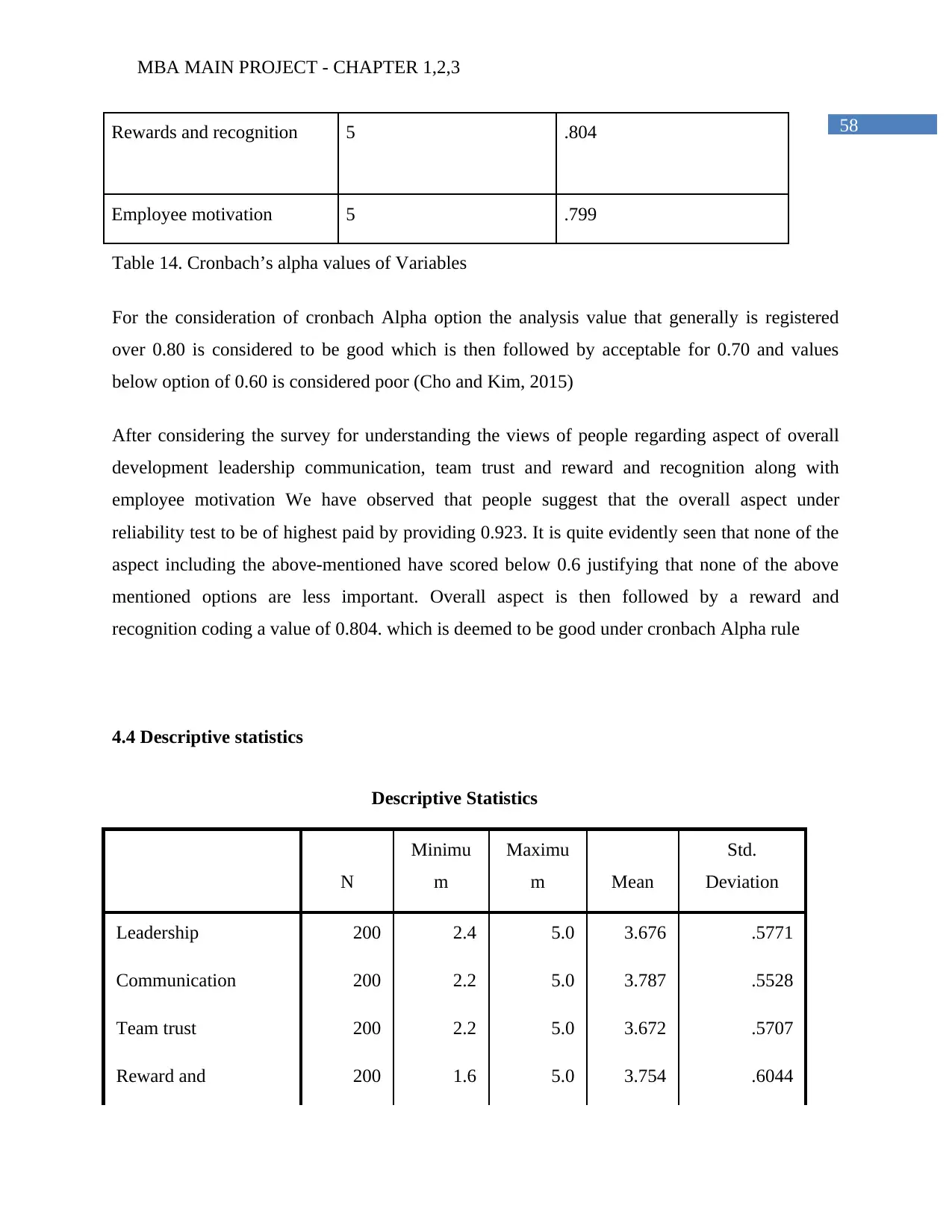
58Rewards and recognition 5 .804
Employee motivation 5 .799
Table 14. Cronbach’s alpha values of Variables
For the consideration of cronbach Alpha option the analysis value that generally is registered
over 0.80 is considered to be good which is then followed by acceptable for 0.70 and values
below option of 0.60 is considered poor (Cho and Kim, 2015)
After considering the survey for understanding the views of people regarding aspect of overall
development leadership communication, team trust and reward and recognition along with
employee motivation We have observed that people suggest that the overall aspect under
reliability test to be of highest paid by providing 0.923. It is quite evidently seen that none of the
aspect including the above-mentioned have scored below 0.6 justifying that none of the above
mentioned options are less important. Overall aspect is then followed by a reward and
recognition coding a value of 0.804. which is deemed to be good under cronbach Alpha rule
4.4 Descriptive statistics
Descriptive Statistics
N
Minimu
m
Maximu
m Mean
Std.
Deviation
Leadership 200 2.4 5.0 3.676 .5771
Communication 200 2.2 5.0 3.787 .5528
Team trust 200 2.2 5.0 3.672 .5707
Reward and 200 1.6 5.0 3.754 .6044
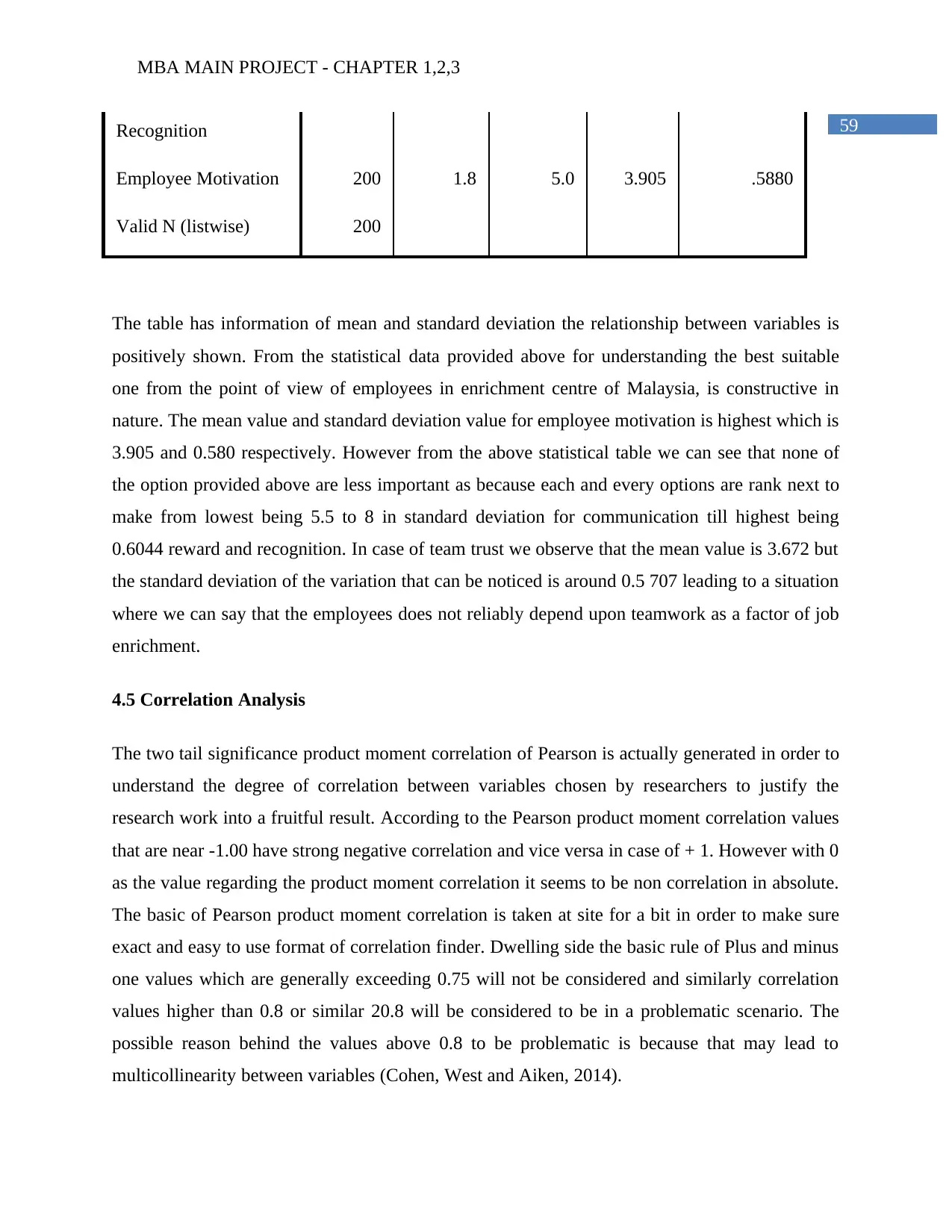
59Recognition
Employee Motivation 200 1.8 5.0 3.905 .5880
Valid N (listwise) 200
The table has information of mean and standard deviation the relationship between variables is
positively shown. From the statistical data provided above for understanding the best suitable
one from the point of view of employees in enrichment centre of Malaysia, is constructive in
nature. The mean value and standard deviation value for employee motivation is highest which is
3.905 and 0.580 respectively. However from the above statistical table we can see that none of
the option provided above are less important as because each and every options are rank next to
make from lowest being 5.5 to 8 in standard deviation for communication till highest being
0.6044 reward and recognition. In case of team trust we observe that the mean value is 3.672 but
the standard deviation of the variation that can be noticed is around 0.5 707 leading to a situation
where we can say that the employees does not reliably depend upon teamwork as a factor of job
enrichment.
4.5 Correlation Analysis
The two tail significance product moment correlation of Pearson is actually generated in order to
understand the degree of correlation between variables chosen by researchers to justify the
research work into a fruitful result. According to the Pearson product moment correlation values
that are near -1.00 have strong negative correlation and vice versa in case of + 1. However with 0
as the value regarding the product moment correlation it seems to be non correlation in absolute.
The basic of Pearson product moment correlation is taken at site for a bit in order to make sure
exact and easy to use format of correlation finder. Dwelling side the basic rule of Plus and minus
one values which are generally exceeding 0.75 will not be considered and similarly correlation
values higher than 0.8 or similar 20.8 will be considered to be in a problematic scenario. The
possible reason behind the values above 0.8 to be problematic is because that may lead to
multicollinearity between variables (Cohen, West and Aiken, 2014).
⊘ This is a preview!⊘
Do you want full access?
Subscribe today to unlock all pages.

Trusted by 1+ million students worldwide

60Correlations
Employ
ee
Motivati
on
Leader
ship
Communi
cation
Team
trust
Reward
and
Recognit
ion
Employee
Motivation
Pearson
Correlation
1 .602** .482** .536** .665**
Sig. (2-
tailed)
.000 .000 .000 .000
N 200 200 200 200 200
Leadership Pearson
Correlation
.602** 1 .593** .646** .617**
Sig. (2-
tailed)
.000 .000 .000 .000
N 200 200 200 200 200
Communicatio
n
Pearson
Correlation
.482** .593** 1 .462** .529**
Sig. (2-
tailed)
.000 .000 .000 .000
N 200 200 200 200 200
Team trust Pearson
Correlation
.536** .646** .462** 1 .655**
Sig. (2-
tailed)
.000 .000 .000 .000
Paraphrase This Document
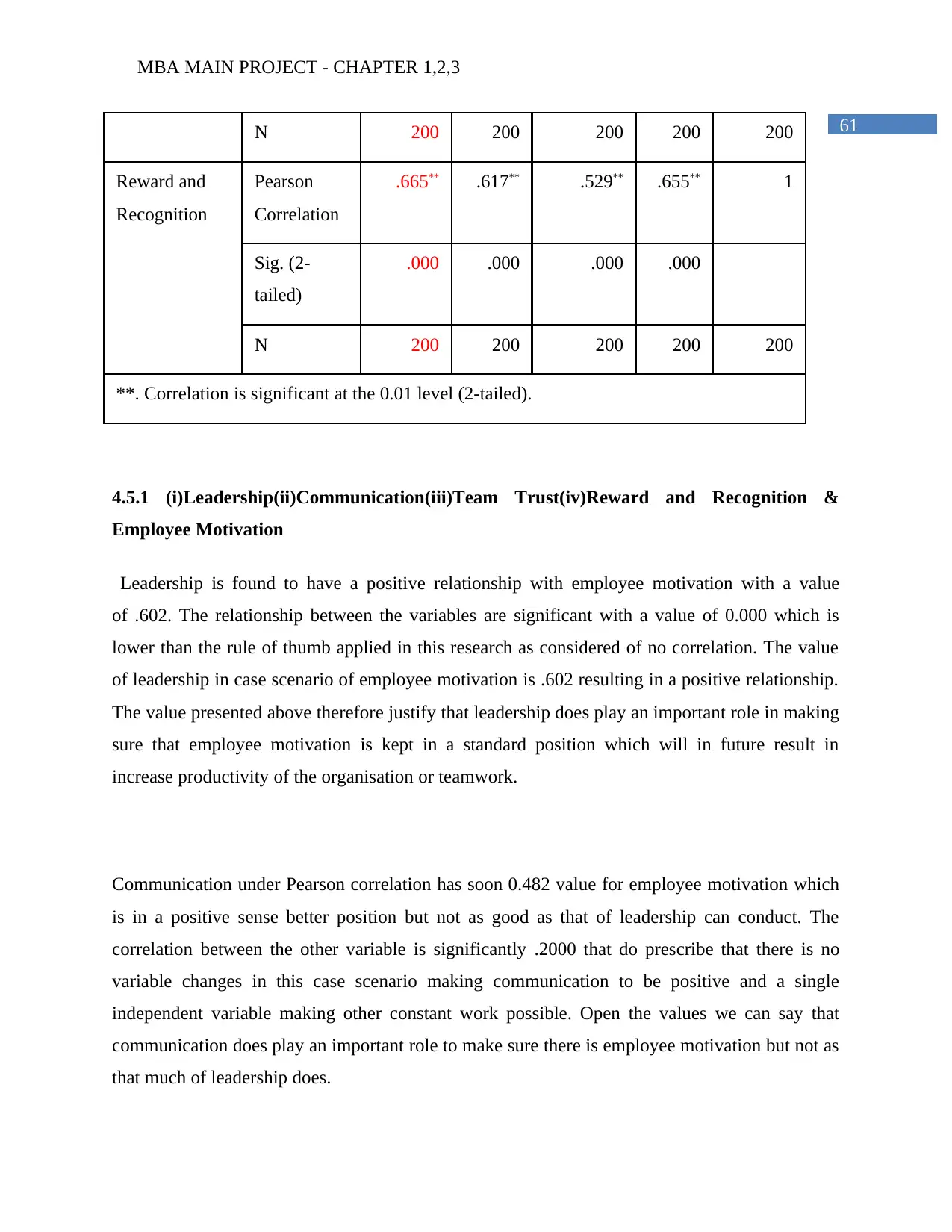
61N 200 200 200 200 200
Reward and
Recognition
Pearson
Correlation
.665** .617** .529** .655** 1
Sig. (2-
tailed)
.000 .000 .000 .000
N 200 200 200 200 200
**. Correlation is significant at the 0.01 level (2-tailed).
4.5.1 (i)Leadership(ii)Communication(iii)Team Trust(iv)Reward and Recognition &
Employee Motivation
Leadership is found to have a positive relationship with employee motivation with a value
of .602. The relationship between the variables are significant with a value of 0.000 which is
lower than the rule of thumb applied in this research as considered of no correlation. The value
of leadership in case scenario of employee motivation is .602 resulting in a positive relationship.
The value presented above therefore justify that leadership does play an important role in making
sure that employee motivation is kept in a standard position which will in future result in
increase productivity of the organisation or teamwork.
Communication under Pearson correlation has soon 0.482 value for employee motivation which
is in a positive sense better position but not as good as that of leadership can conduct. The
correlation between the other variable is significantly .2000 that do prescribe that there is no
variable changes in this case scenario making communication to be positive and a single
independent variable making other constant work possible. Open the values we can say that
communication does play an important role to make sure there is employee motivation but not as
that much of leadership does.
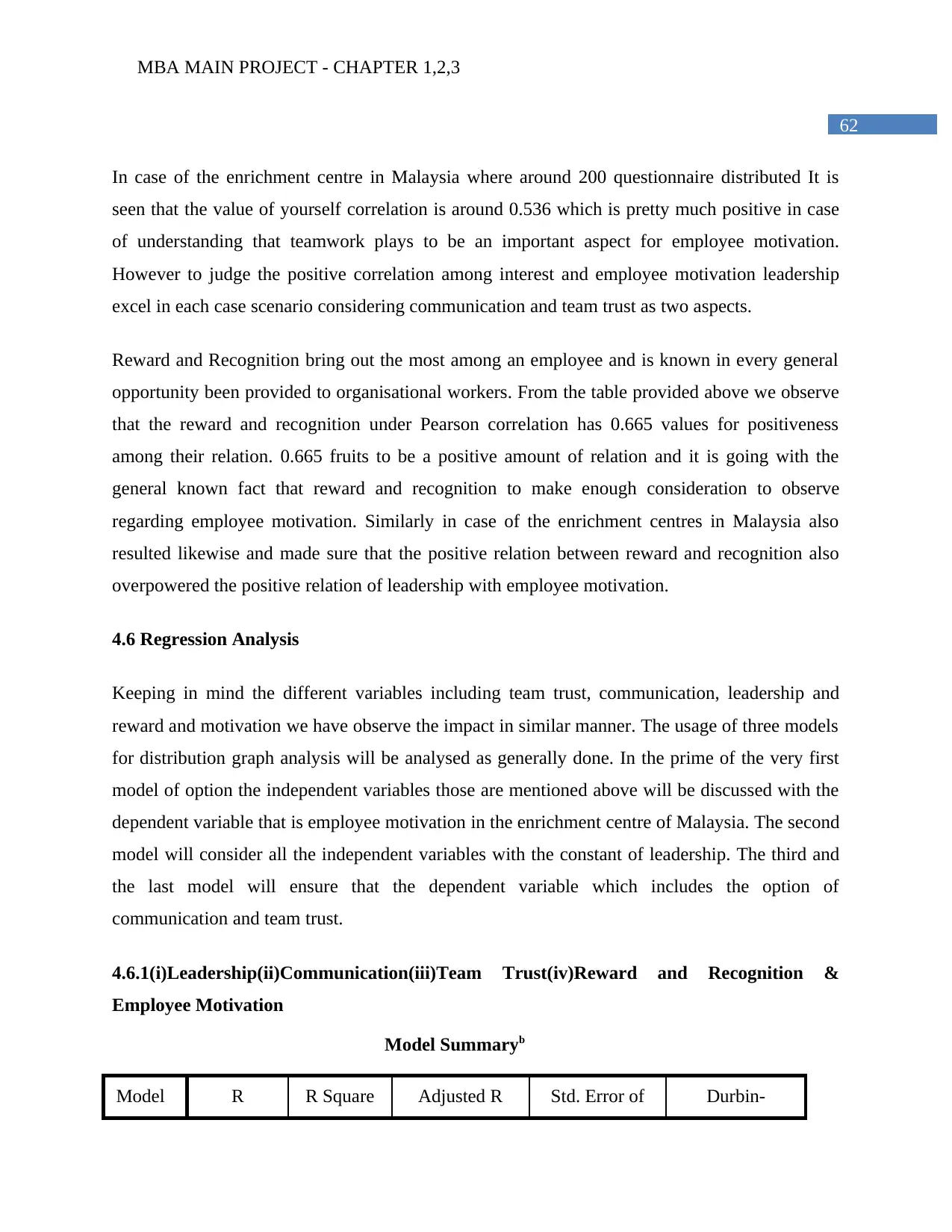
62
In case of the enrichment centre in Malaysia where around 200 questionnaire distributed It is
seen that the value of yourself correlation is around 0.536 which is pretty much positive in case
of understanding that teamwork plays to be an important aspect for employee motivation.
However to judge the positive correlation among interest and employee motivation leadership
excel in each case scenario considering communication and team trust as two aspects.
Reward and Recognition bring out the most among an employee and is known in every general
opportunity been provided to organisational workers. From the table provided above we observe
that the reward and recognition under Pearson correlation has 0.665 values for positiveness
among their relation. 0.665 fruits to be a positive amount of relation and it is going with the
general known fact that reward and recognition to make enough consideration to observe
regarding employee motivation. Similarly in case of the enrichment centres in Malaysia also
resulted likewise and made sure that the positive relation between reward and recognition also
overpowered the positive relation of leadership with employee motivation.
4.6 Regression Analysis
Keeping in mind the different variables including team trust, communication, leadership and
reward and motivation we have observe the impact in similar manner. The usage of three models
for distribution graph analysis will be analysed as generally done. In the prime of the very first
model of option the independent variables those are mentioned above will be discussed with the
dependent variable that is employee motivation in the enrichment centre of Malaysia. The second
model will consider all the independent variables with the constant of leadership. The third and
the last model will ensure that the dependent variable which includes the option of
communication and team trust.
4.6.1(i)Leadership(ii)Communication(iii)Team Trust(iv)Reward and Recognition &
Employee Motivation
Model Summaryb
Model R R Square Adjusted R Std. Error of Durbin-
⊘ This is a preview!⊘
Do you want full access?
Subscribe today to unlock all pages.

Trusted by 1+ million students worldwide
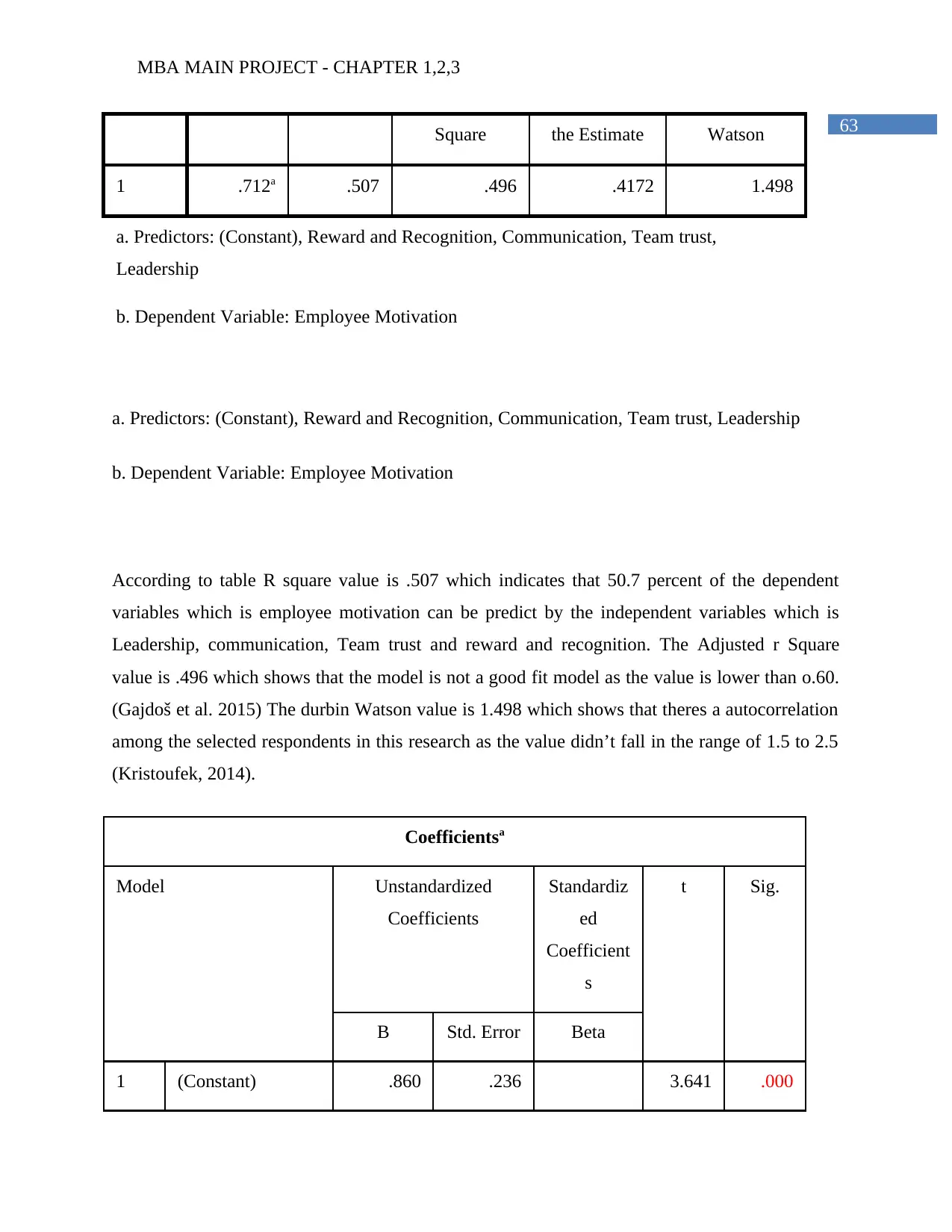
63Square the Estimate Watson
1 .712a .507 .496 .4172 1.498
a. Predictors: (Constant), Reward and Recognition, Communication, Team trust,
Leadership
b. Dependent Variable: Employee Motivation
a. Predictors: (Constant), Reward and Recognition, Communication, Team trust, Leadership
b. Dependent Variable: Employee Motivation
According to table R square value is .507 which indicates that 50.7 percent of the dependent
variables which is employee motivation can be predict by the independent variables which is
Leadership, communication, Team trust and reward and recognition. The Adjusted r Square
value is .496 which shows that the model is not a good fit model as the value is lower than o.60.
(Gajdoš et al. 2015) The durbin Watson value is 1.498 which shows that theres a autocorrelation
among the selected respondents in this research as the value didn’t fall in the range of 1.5 to 2.5
(Kristoufek, 2014).
Coefficientsa
Model Unstandardized
Coefficients
Standardiz
ed
Coefficient
s
t Sig.
B Std. Error Beta
1 (Constant) .860 .236 3.641 .000
Paraphrase This Document

64Leadership .262 .077 .257 3.425 .001
Communication .083 .069 .078 1.199 .232
Team trust .053 .075 .051 .702 .483
Reward and
Recognition
.420 .071 .431 5.947 .000
a. Dependent Variable: Employee Motivation
According to table no Leadership is found to have a positive impact on employee motivation
with a coefficient value of .257. The Leadership value is significant with a value of 0.001 which
is lower than rule of thumb applied in this research. Hence leadership is found to have a positive
significant impact on employee motivation.
4.6.2 Discussion on Hypothesis Findings:
H1: Leadership has a positive significant impact on employee motivation (Accepted)
In current scenario observing at the prospect we clearly understand that leadership that have
social impact of operation in an organisation in the development of motivation among employees
(Wang et al. 2014). Understanding the importance of relationship does not only mean evaluating
its cause and effect but also to understand how it can be used off to bring in more revolution. The
research conducted has also provided positive result. The very important factor of leadership
standard of employee motivation is that it create a sense of unity and the option for making sure
that the work that the employees provide are all for the development of the organisation and not
individualism. The research has also provided similar answers for positivity have been shown
through ears and correlation rule also. It can be justified that leadership by is very name have
authentically provided every objectivity towards the employees that results in long term benefit
of motivation in the organisational workplace like the Malaysian job enrichment centre. The
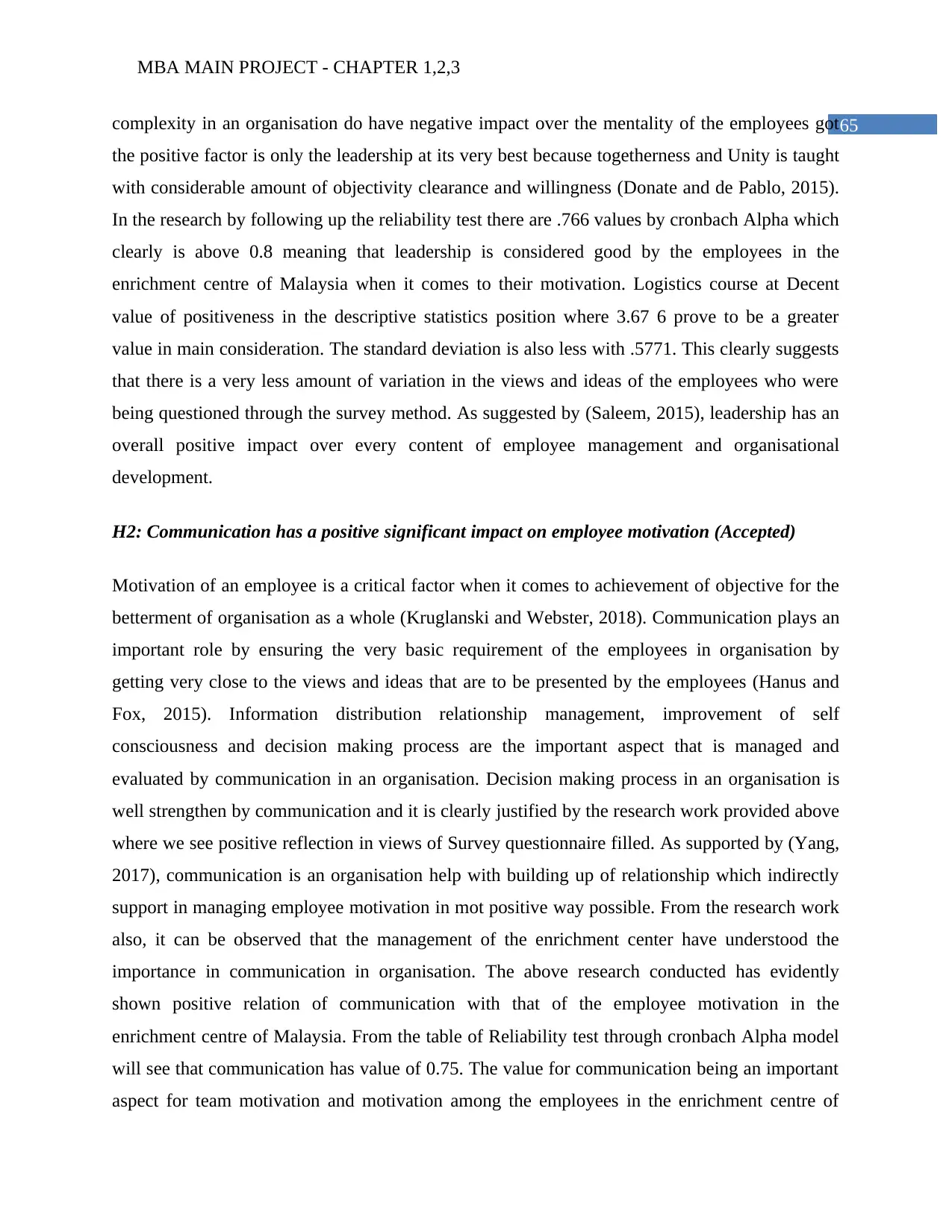
65complexity in an organisation do have negative impact over the mentality of the employees got
the positive factor is only the leadership at its very best because togetherness and Unity is taught
with considerable amount of objectivity clearance and willingness (Donate and de Pablo, 2015).
In the research by following up the reliability test there are .766 values by cronbach Alpha which
clearly is above 0.8 meaning that leadership is considered good by the employees in the
enrichment centre of Malaysia when it comes to their motivation. Logistics course at Decent
value of positiveness in the descriptive statistics position where 3.67 6 prove to be a greater
value in main consideration. The standard deviation is also less with .5771. This clearly suggests
that there is a very less amount of variation in the views and ideas of the employees who were
being questioned through the survey method. As suggested by (Saleem, 2015), leadership has an
overall positive impact over every content of employee management and organisational
development.
H2: Communication has a positive significant impact on employee motivation (Accepted)
Motivation of an employee is a critical factor when it comes to achievement of objective for the
betterment of organisation as a whole (Kruglanski and Webster, 2018). Communication plays an
important role by ensuring the very basic requirement of the employees in organisation by
getting very close to the views and ideas that are to be presented by the employees (Hanus and
Fox, 2015). Information distribution relationship management, improvement of self
consciousness and decision making process are the important aspect that is managed and
evaluated by communication in an organisation. Decision making process in an organisation is
well strengthen by communication and it is clearly justified by the research work provided above
where we see positive reflection in views of Survey questionnaire filled. As supported by (Yang,
2017), communication is an organisation help with building up of relationship which indirectly
support in managing employee motivation in mot positive way possible. From the research work
also, it can be observed that the management of the enrichment center have understood the
importance in communication in organisation. The above research conducted has evidently
shown positive relation of communication with that of the employee motivation in the
enrichment centre of Malaysia. From the table of Reliability test through cronbach Alpha model
will see that communication has value of 0.75. The value for communication being an important
aspect for team motivation and motivation among the employees in the enrichment centre of
⊘ This is a preview!⊘
Do you want full access?
Subscribe today to unlock all pages.

Trusted by 1+ million students worldwide
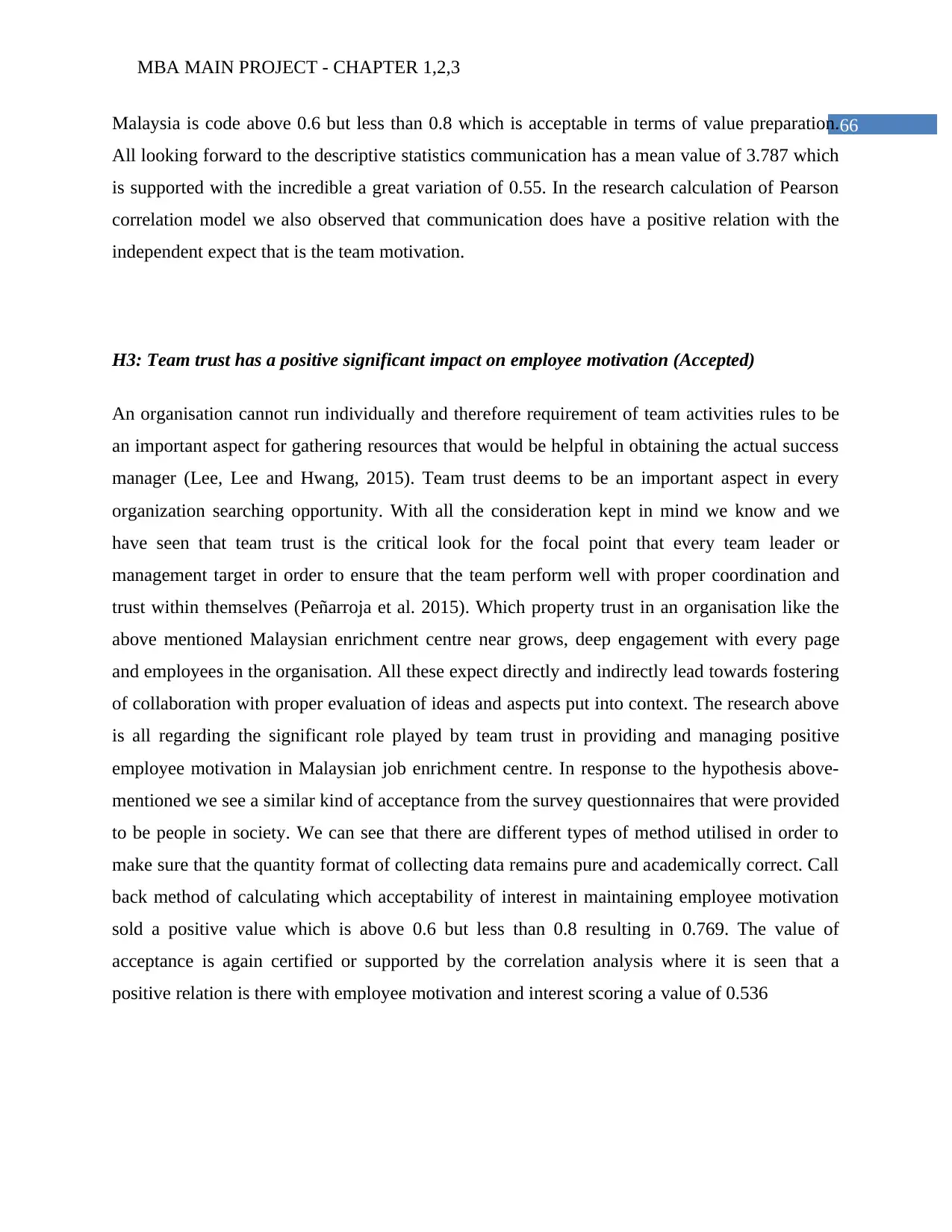
66Malaysia is code above 0.6 but less than 0.8 which is acceptable in terms of value preparation.
All looking forward to the descriptive statistics communication has a mean value of 3.787 which
is supported with the incredible a great variation of 0.55. In the research calculation of Pearson
correlation model we also observed that communication does have a positive relation with the
independent expect that is the team motivation.
H3: Team trust has a positive significant impact on employee motivation (Accepted)
An organisation cannot run individually and therefore requirement of team activities rules to be
an important aspect for gathering resources that would be helpful in obtaining the actual success
manager (Lee, Lee and Hwang, 2015). Team trust deems to be an important aspect in every
organization searching opportunity. With all the consideration kept in mind we know and we
have seen that team trust is the critical look for the focal point that every team leader or
management target in order to ensure that the team perform well with proper coordination and
trust within themselves (Peñarroja et al. 2015). Which property trust in an organisation like the
above mentioned Malaysian enrichment centre near grows, deep engagement with every page
and employees in the organisation. All these expect directly and indirectly lead towards fostering
of collaboration with proper evaluation of ideas and aspects put into context. The research above
is all regarding the significant role played by team trust in providing and managing positive
employee motivation in Malaysian job enrichment centre. In response to the hypothesis above-
mentioned we see a similar kind of acceptance from the survey questionnaires that were provided
to be people in society. We can see that there are different types of method utilised in order to
make sure that the quantity format of collecting data remains pure and academically correct. Call
back method of calculating which acceptability of interest in maintaining employee motivation
sold a positive value which is above 0.6 but less than 0.8 resulting in 0.769. The value of
acceptance is again certified or supported by the correlation analysis where it is seen that a
positive relation is there with employee motivation and interest scoring a value of 0.536
Paraphrase This Document
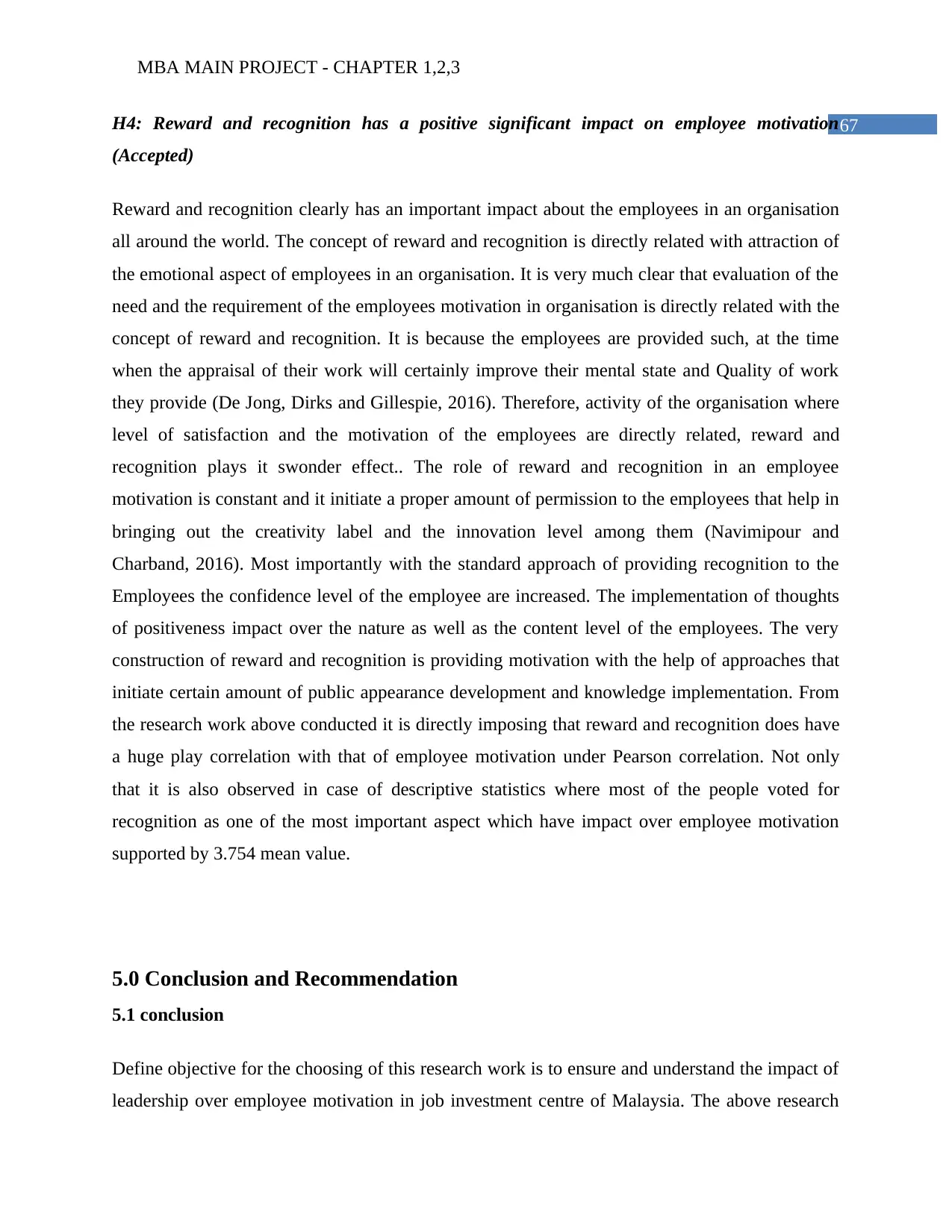
67H4: Reward and recognition has a positive significant impact on employee motivation
(Accepted)
Reward and recognition clearly has an important impact about the employees in an organisation
all around the world. The concept of reward and recognition is directly related with attraction of
the emotional aspect of employees in an organisation. It is very much clear that evaluation of the
need and the requirement of the employees motivation in organisation is directly related with the
concept of reward and recognition. It is because the employees are provided such, at the time
when the appraisal of their work will certainly improve their mental state and Quality of work
they provide (De Jong, Dirks and Gillespie, 2016). Therefore, activity of the organisation where
level of satisfaction and the motivation of the employees are directly related, reward and
recognition plays it swonder effect.. The role of reward and recognition in an employee
motivation is constant and it initiate a proper amount of permission to the employees that help in
bringing out the creativity label and the innovation level among them (Navimipour and
Charband, 2016). Most importantly with the standard approach of providing recognition to the
Employees the confidence level of the employee are increased. The implementation of thoughts
of positiveness impact over the nature as well as the content level of the employees. The very
construction of reward and recognition is providing motivation with the help of approaches that
initiate certain amount of public appearance development and knowledge implementation. From
the research work above conducted it is directly imposing that reward and recognition does have
a huge play correlation with that of employee motivation under Pearson correlation. Not only
that it is also observed in case of descriptive statistics where most of the people voted for
recognition as one of the most important aspect which have impact over employee motivation
supported by 3.754 mean value.
5.0 Conclusion and Recommendation
5.1 conclusion
Define objective for the choosing of this research work is to ensure and understand the impact of
leadership over employee motivation in job investment centre of Malaysia. The above research

68work has critically evaluated every required information of dependent and independent variables.
Leadership, communication, team trust and recognition or you are taken into consideration as the
variables as employee motivation is taken as the dependent variable. Spot the brief evaluation of
the whole research work we can observe that leadership may have their positive share of
importance in improving employee motivation in enrichment centre of Malaysia but other factors
like reward and recognition, communication and team trust does not fall out much further away.
Objective1: to examine the impact of leadership on employee motivation
The impact of leadership on employee motivation is clear from the research above done. In the
long run we get to see the impact over the motivation of employees in the Malaysian enrichment
centre. The literature review has provided to be enough information that suggest how leadership
plays its role in development of employee motivation. The information related to increase in
teamwork through leadership quality along with Unity in providing objectives for work are all
improvised in the literature review part of the research work above mentioned. Which all the
concern and importance of leadership role being provided unjustified through research work,
there are some situation which cannot be yet explained. There are some aspect that does not
work or there is some exceptions being noticed. Impact of leadership on employee motivation is
also justified and evaluated by the way how leadership appears to be mental state of the
employees in the organisation. FB achievement of organisational success is directly or indirectly
related to the way how leadership is conducted or how leaders busy with employee. Enrichment
centre in Malaysia have shown a great positive response in the survey questionnaire the well
being provided for leadership was provided a huge positive thumbs up for employee motivation.
Objective2: to examine the impact of Communication on employee motivation
Communication is another important factor that is considered in the research work to evaluate
the level of satisfaction that leadership provide from the other variable. Communication as
described in the literature review part as well as evaluated in the calculations Apple prove that it
deepens the relationship among the employees of the organisation. Creativity of the employees
are positively in which and their efforts of collaboration along with knowledge improvisation are
taken into consideration for basic work too complex work method. The decision making process
⊘ This is a preview!⊘
Do you want full access?
Subscribe today to unlock all pages.

Trusted by 1+ million students worldwide

69is developed and the sharing of information make sure that the confidence level as well as a
satisfaction level of the employees are maintained properly resulting in motivation being served
positively.
Objective3: to examine the impact of Team trust on employee motivation
Trust is something that cannot be attained easy and won't attend it has huge and greater impact
over the mental state of the employees. Essay of unity and the sense of togetherness to solve a
problem provide extra opportunity to the Employees as discussed in literature review part. There
has been discussion in literature review, about the team trust, which is the opinion of the people
regarding the importance of believing in the work of the other team mates. From the above
literature review part it has been clearly seen that the analysis of positive relationship between
the members in an organisation proves to be be result of trust between them. Other than the
literature review the survey questionnaire have also provided with a General overview of the
importance of team trust for managing employee motivation as because it brings out the
confidence level of the employees and make sure that they provide with the best possible answer
and ways to satisfy the need of the organisation.
Objective4: to examine the impact of Reward and recognition on employee motivation
Reward and recognition does have a great impact just after leadership upon the employee
motivation in an organisation. The employee motivation of an organisation is directly related to
that of the reward and recognition being provided to them. From the literature review about
provided with that the options for what does make the organisational workers work hard that
motivates them to make sure they qualify for the easy word that is being provided with an
objective of target operation. Most importantly reward and recognition have come up with
options that considerably provide important objective to the Employees resulting in bringing out
the innovativeness as well as the curiosity of the employees. Send the above research work in
process is used as well as in the research questionnaire being provided to the employee we
observe that reward and recognition act as an important aspect to engage the employees in
productive work resulting in preparation of employee engagement Hai wiki page John Abraham
Maslow hierarchy law.
Paraphrase This Document

705.2 Recommendation
From the above research result we can directly imply that leadership does have positive impact
of woodbee employee motivation factors. Configuring a very important aspect of leadership, we
now know that it has both positive as well as energizing effect over the motivation and mental
state of the employees. There are instances which clearly suggest that not only leadership of also
other sectors has their positive impact over the way the employees in the investment centre of
Malaysia can work. For the eve of Google search for the researcher complied with 4 variables
including leadership. The four variables which included leadership, communication, team trust
and reward and recognition clearly have justified their positive impact in a neck to neck
situation.
By just looking around the research survey questionnaire and the way the employees of
Malaysian enrichment Centre have answered we can understand that not only leadership but also
reward and recognition has a pretty great share of importance when it comes to motivating the
employees. In order to make sure that the employees in the organisation are not only related to
that of leadership only, the workers and the organisational employees must be treated with that of
reward and recognition for performance appraisal in a strong manner.
Going to the basic of the requirement in terms of motivating the employees in the organisation
should not work every time keeping in mind the dynamic state of organisational what force.
Objectivity where feedback is provided continuously for trusting the Employees with the
capability is maintained motivation arises in a gradual and flow rate. To evolve employee
motivation factor to a new level there must be proper method implemented other than the ones
discussed above in the research work. Making exceptation clear would have in clarifying the
object use that the employee present within themselves while completion of any work. But we
observe Hindi effect of communication open and transparent way of sharing values and ideas
could also help in development of employee motivation in enrichment centre of Malaysia
5.3 Limitation
While going on with the research work successful completion is always the objective of every
researcher. However facing with difficulties while completion of research for his eminent as
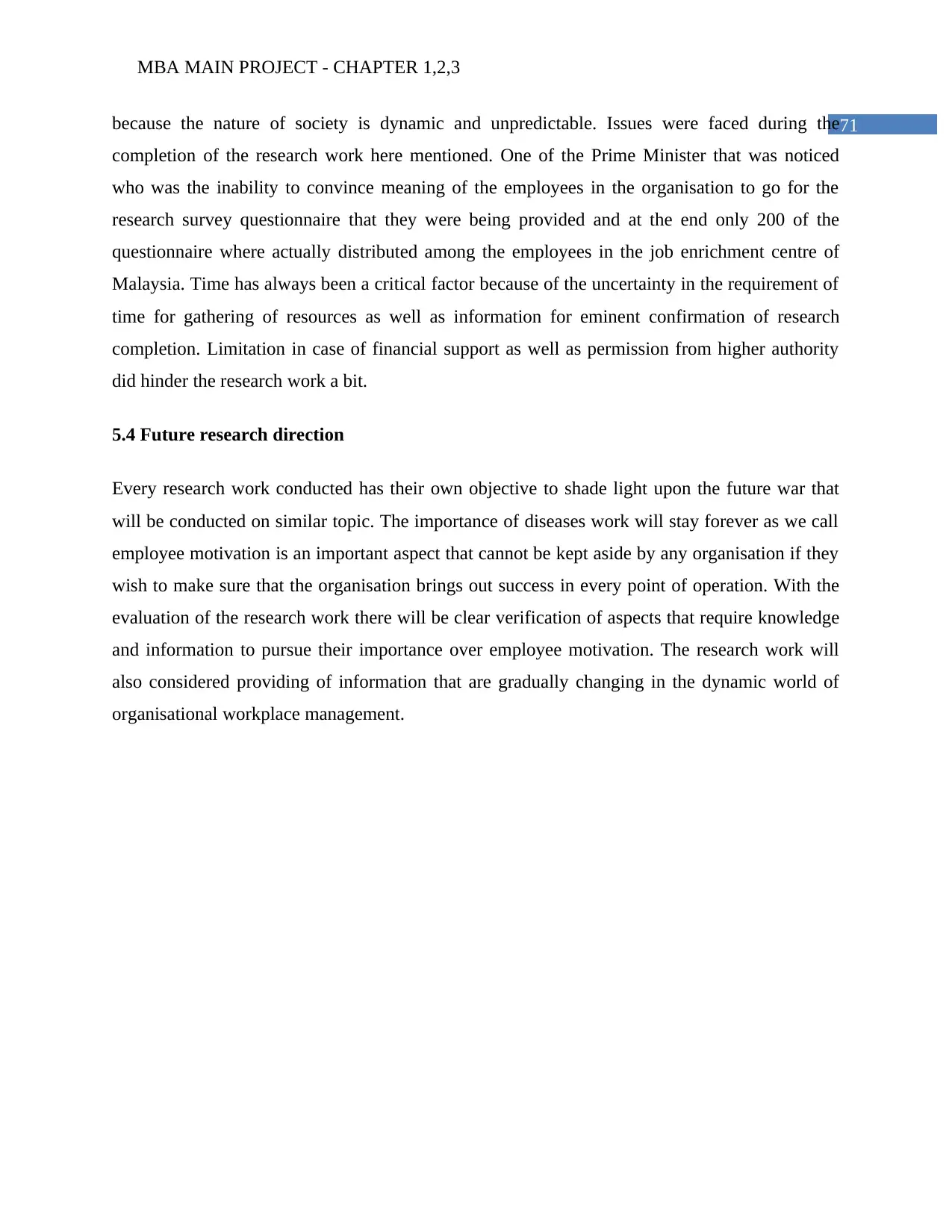
71because the nature of society is dynamic and unpredictable. Issues were faced during the
completion of the research work here mentioned. One of the Prime Minister that was noticed
who was the inability to convince meaning of the employees in the organisation to go for the
research survey questionnaire that they were being provided and at the end only 200 of the
questionnaire where actually distributed among the employees in the job enrichment centre of
Malaysia. Time has always been a critical factor because of the uncertainty in the requirement of
time for gathering of resources as well as information for eminent confirmation of research
completion. Limitation in case of financial support as well as permission from higher authority
did hinder the research work a bit.
5.4 Future research direction
Every research work conducted has their own objective to shade light upon the future war that
will be conducted on similar topic. The importance of diseases work will stay forever as we call
employee motivation is an important aspect that cannot be kept aside by any organisation if they
wish to make sure that the organisation brings out success in every point of operation. With the
evaluation of the research work there will be clear verification of aspects that require knowledge
and information to pursue their importance over employee motivation. The research work will
also considered providing of information that are gradually changing in the dynamic world of
organisational workplace management.
⊘ This is a preview!⊘
Do you want full access?
Subscribe today to unlock all pages.

Trusted by 1+ million students worldwide

72
Paraphrase This Document
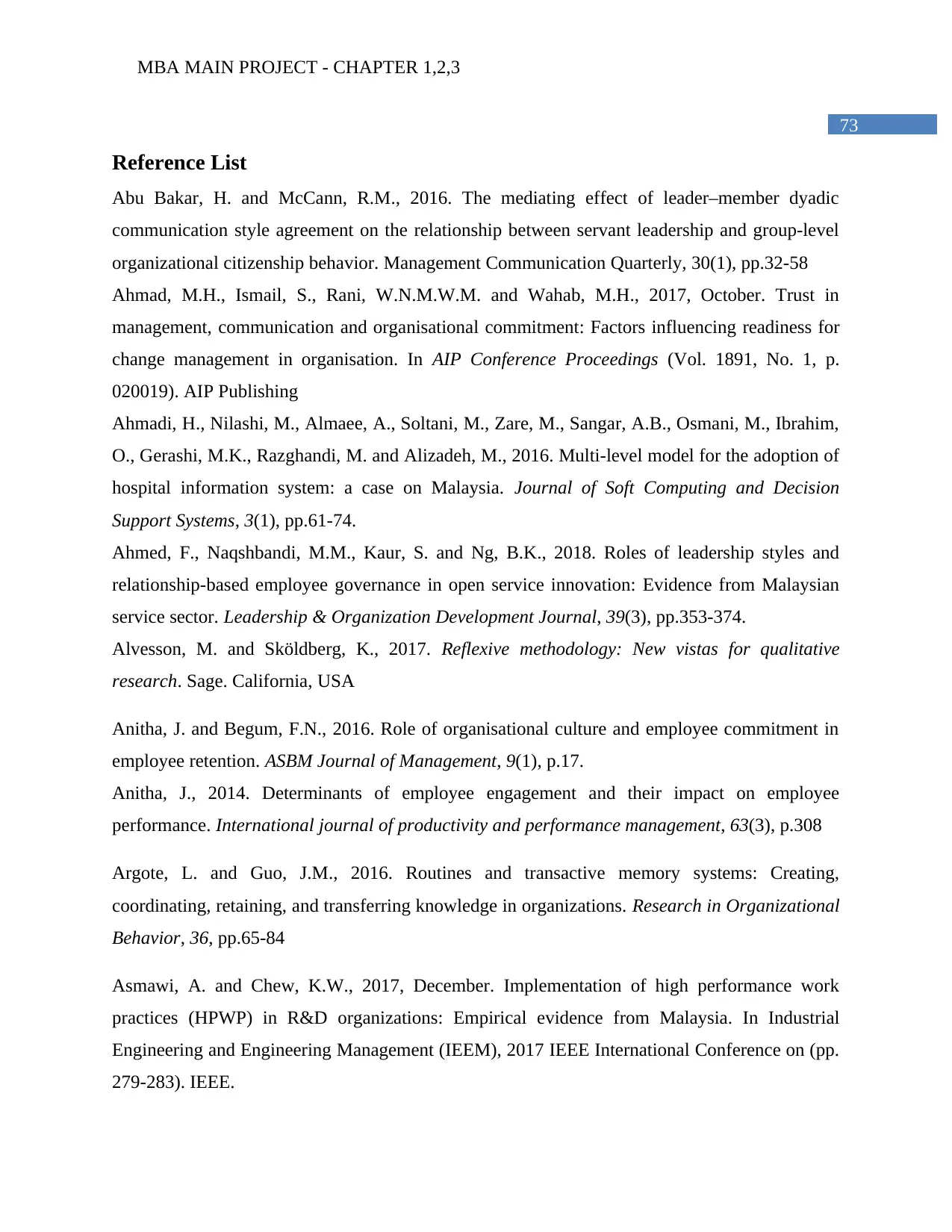
73
Reference List
Abu Bakar, H. and McCann, R.M., 2016. The mediating effect of leader–member dyadic
communication style agreement on the relationship between servant leadership and group-level
organizational citizenship behavior. Management Communication Quarterly, 30(1), pp.32-58
Ahmad, M.H., Ismail, S., Rani, W.N.M.W.M. and Wahab, M.H., 2017, October. Trust in
management, communication and organisational commitment: Factors influencing readiness for
change management in organisation. In AIP Conference Proceedings (Vol. 1891, No. 1, p.
020019). AIP Publishing
Ahmadi, H., Nilashi, M., Almaee, A., Soltani, M., Zare, M., Sangar, A.B., Osmani, M., Ibrahim,
O., Gerashi, M.K., Razghandi, M. and Alizadeh, M., 2016. Multi-level model for the adoption of
hospital information system: a case on Malaysia. Journal of Soft Computing and Decision
Support Systems, 3(1), pp.61-74.
Ahmed, F., Naqshbandi, M.M., Kaur, S. and Ng, B.K., 2018. Roles of leadership styles and
relationship-based employee governance in open service innovation: Evidence from Malaysian
service sector. Leadership & Organization Development Journal, 39(3), pp.353-374.
Alvesson, M. and Sköldberg, K., 2017. Reflexive methodology: New vistas for qualitative
research. Sage. California, USA
Anitha, J. and Begum, F.N., 2016. Role of organisational culture and employee commitment in
employee retention. ASBM Journal of Management, 9(1), p.17.
Anitha, J., 2014. Determinants of employee engagement and their impact on employee
performance. International journal of productivity and performance management, 63(3), p.308
Argote, L. and Guo, J.M., 2016. Routines and transactive memory systems: Creating,
coordinating, retaining, and transferring knowledge in organizations. Research in Organizational
Behavior, 36, pp.65-84
Asmawi, A. and Chew, K.W., 2017, December. Implementation of high performance work
practices (HPWP) in R&D organizations: Empirical evidence from Malaysia. In Industrial
Engineering and Engineering Management (IEEM), 2017 IEEE International Conference on (pp.
279-283). IEEE.
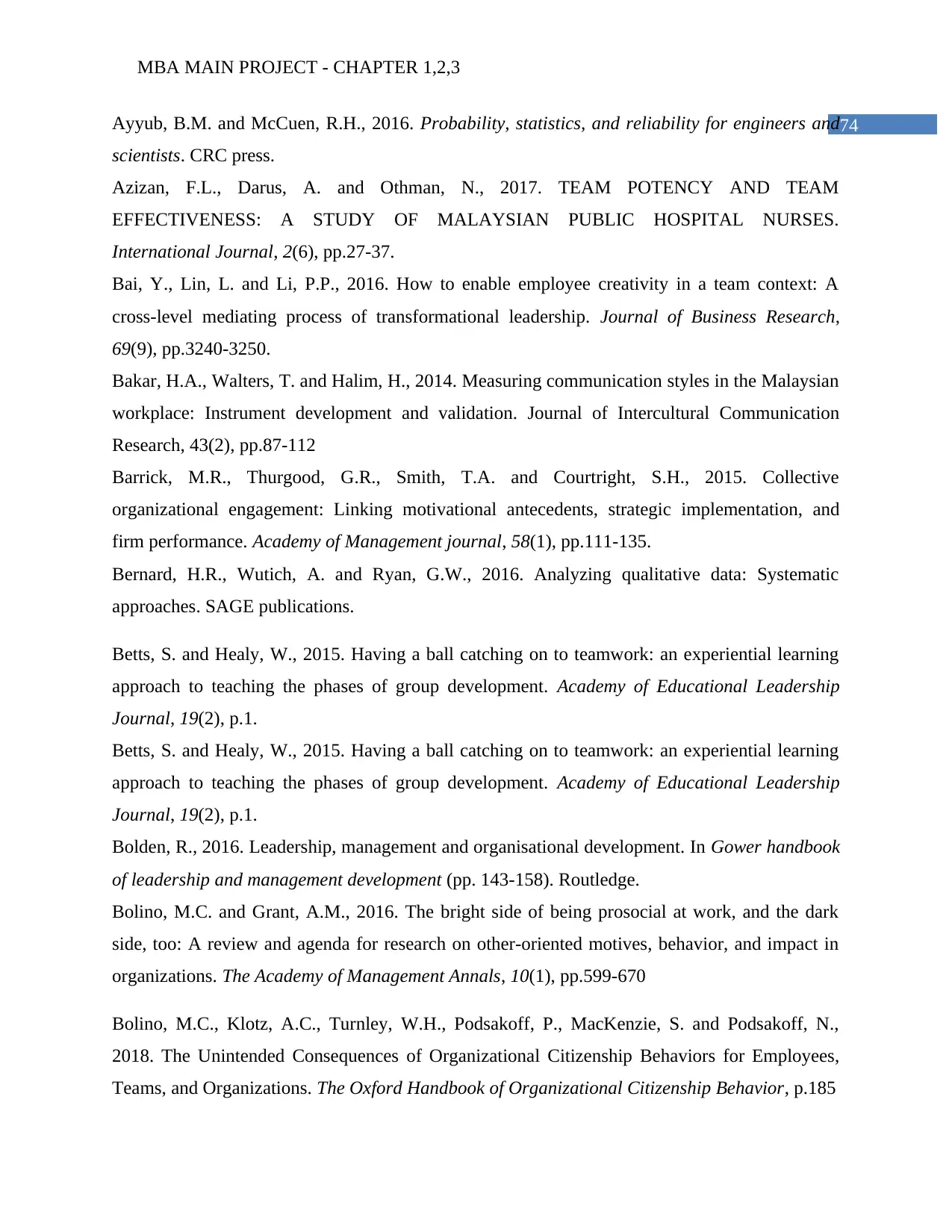
74Ayyub, B.M. and McCuen, R.H., 2016. Probability, statistics, and reliability for engineers and
scientists. CRC press.
Azizan, F.L., Darus, A. and Othman, N., 2017. TEAM POTENCY AND TEAM
EFFECTIVENESS: A STUDY OF MALAYSIAN PUBLIC HOSPITAL NURSES.
International Journal, 2(6), pp.27-37.
Bai, Y., Lin, L. and Li, P.P., 2016. How to enable employee creativity in a team context: A
cross-level mediating process of transformational leadership. Journal of Business Research,
69(9), pp.3240-3250.
Bakar, H.A., Walters, T. and Halim, H., 2014. Measuring communication styles in the Malaysian
workplace: Instrument development and validation. Journal of Intercultural Communication
Research, 43(2), pp.87-112
Barrick, M.R., Thurgood, G.R., Smith, T.A. and Courtright, S.H., 2015. Collective
organizational engagement: Linking motivational antecedents, strategic implementation, and
firm performance. Academy of Management journal, 58(1), pp.111-135.
Bernard, H.R., Wutich, A. and Ryan, G.W., 2016. Analyzing qualitative data: Systematic
approaches. SAGE publications.
Betts, S. and Healy, W., 2015. Having a ball catching on to teamwork: an experiential learning
approach to teaching the phases of group development. Academy of Educational Leadership
Journal, 19(2), p.1.
Betts, S. and Healy, W., 2015. Having a ball catching on to teamwork: an experiential learning
approach to teaching the phases of group development. Academy of Educational Leadership
Journal, 19(2), p.1.
Bolden, R., 2016. Leadership, management and organisational development. In Gower handbook
of leadership and management development (pp. 143-158). Routledge.
Bolino, M.C. and Grant, A.M., 2016. The bright side of being prosocial at work, and the dark
side, too: A review and agenda for research on other-oriented motives, behavior, and impact in
organizations. The Academy of Management Annals, 10(1), pp.599-670
Bolino, M.C., Klotz, A.C., Turnley, W.H., Podsakoff, P., MacKenzie, S. and Podsakoff, N.,
2018. The Unintended Consequences of Organizational Citizenship Behaviors for Employees,
Teams, and Organizations. The Oxford Handbook of Organizational Citizenship Behavior, p.185
⊘ This is a preview!⊘
Do you want full access?
Subscribe today to unlock all pages.

Trusted by 1+ million students worldwide
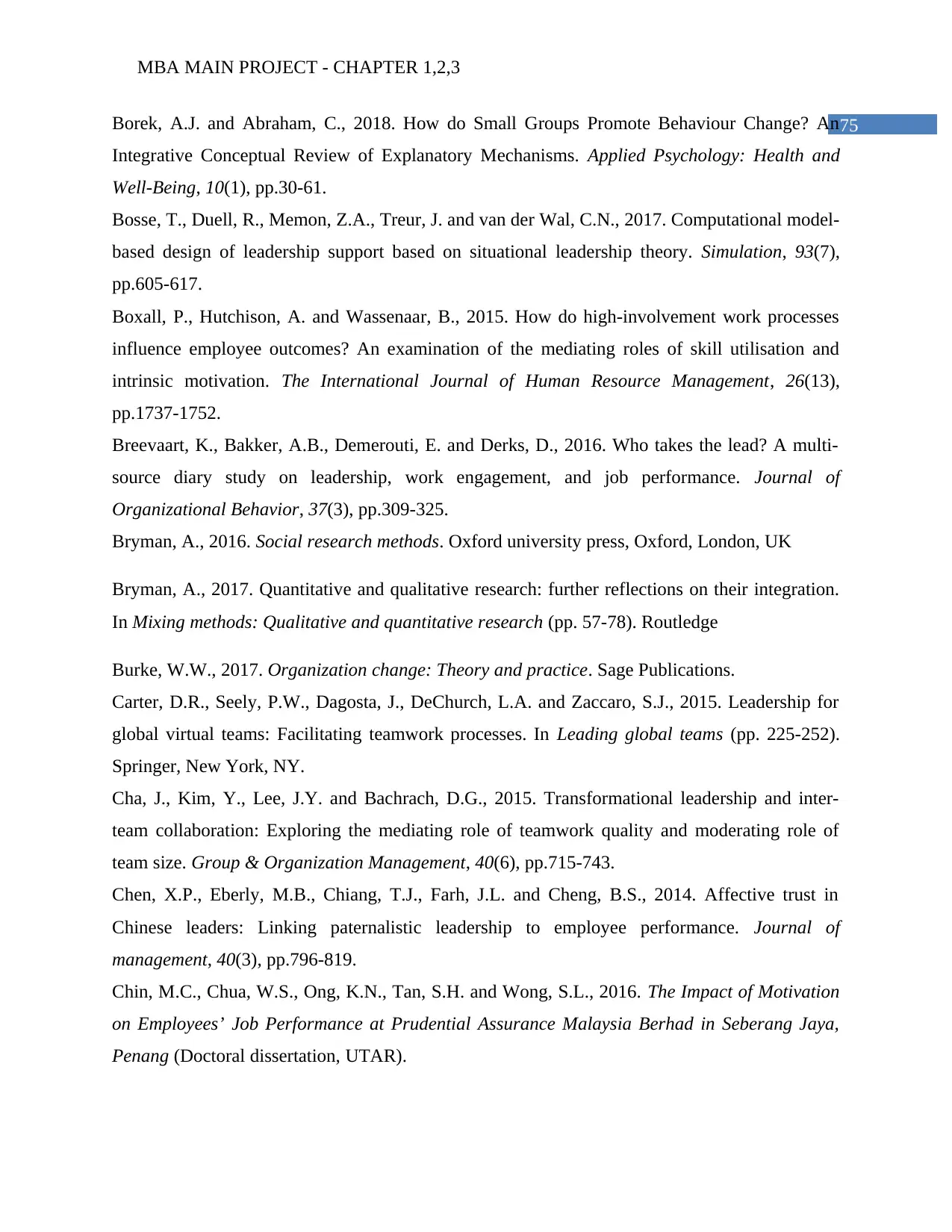
75Borek, A.J. and Abraham, C., 2018. How do Small Groups Promote Behaviour Change? An
Integrative Conceptual Review of Explanatory Mechanisms. Applied Psychology: Health and
Well‐Being, 10(1), pp.30-61.
Bosse, T., Duell, R., Memon, Z.A., Treur, J. and van der Wal, C.N., 2017. Computational model-
based design of leadership support based on situational leadership theory. Simulation, 93(7),
pp.605-617.
Boxall, P., Hutchison, A. and Wassenaar, B., 2015. How do high-involvement work processes
influence employee outcomes? An examination of the mediating roles of skill utilisation and
intrinsic motivation. The International Journal of Human Resource Management, 26(13),
pp.1737-1752.
Breevaart, K., Bakker, A.B., Demerouti, E. and Derks, D., 2016. Who takes the lead? A multi‐
source diary study on leadership, work engagement, and job performance. Journal of
Organizational Behavior, 37(3), pp.309-325.
Bryman, A., 2016. Social research methods. Oxford university press, Oxford, London, UK
Bryman, A., 2017. Quantitative and qualitative research: further reflections on their integration.
In Mixing methods: Qualitative and quantitative research (pp. 57-78). Routledge
Burke, W.W., 2017. Organization change: Theory and practice. Sage Publications.
Carter, D.R., Seely, P.W., Dagosta, J., DeChurch, L.A. and Zaccaro, S.J., 2015. Leadership for
global virtual teams: Facilitating teamwork processes. In Leading global teams (pp. 225-252).
Springer, New York, NY.
Cha, J., Kim, Y., Lee, J.Y. and Bachrach, D.G., 2015. Transformational leadership and inter-
team collaboration: Exploring the mediating role of teamwork quality and moderating role of
team size. Group & Organization Management, 40(6), pp.715-743.
Chen, X.P., Eberly, M.B., Chiang, T.J., Farh, J.L. and Cheng, B.S., 2014. Affective trust in
Chinese leaders: Linking paternalistic leadership to employee performance. Journal of
management, 40(3), pp.796-819.
Chin, M.C., Chua, W.S., Ong, K.N., Tan, S.H. and Wong, S.L., 2016. The Impact of Motivation
on Employees’ Job Performance at Prudential Assurance Malaysia Berhad in Seberang Jaya,
Penang (Doctoral dissertation, UTAR).
Paraphrase This Document

76Cho, E. and Kim, S., 2015. Cronbach’s coefficient alpha: Well known but poorly understood.
Organizational Research Methods, 18(2), pp.207-230.
Choi, S.B., Kim, K. and Kang, S.W., 2017. Effects of transformational and shared leadership
styles on employees' perception of team effectiveness. Social Behavior and Personality: an
international journal, 45(3), pp.377-386.
Cleary, M., Horsfall, J. and Hayter, M., 2014. Data collection and sampling in qualitative
research: does size matter?.Journal of advanced nursing, 70(3), pp.473-475.
Cochran-Smith, M. and Villegas, A.M., 2015. Framing teacher preparation research: An
overview of the field, part 1. Journal of Teacher Education, 66(1), pp.7-20.
Cohen, P., West, S.G. and Aiken, L.S., 2014. Applied multiple regression/correlation analysis for
the behavioral sciences. Psychology Press.
Colbert, A.E., Barrick, M.R. and Bradley, B.H., 2014. Personality and leadership composition in
top management teams: Implications for organizational effectiveness. Personnel Psychology,
67(2), pp.351-387
Costa, P.L., Passos, A.M. and Bakker, A.B., 2015. Direct and contextual influence of team
conflict on team resources, team work engagement, and team performance. Negotiation and
Conflict Management Research, 8(4), pp.211-227.
Creswell, J.W. and Creswell, J.D., 2017. Research design: Qualitative, quantitative, and mixed
methods approaches. Sage publications.
D’Innocenzo, L., Mathieu, J.E. and Kukenberger, M.R., 2016. A meta-analysis of different forms
of shared leadership–team performance relations. Journal of Management, 42(7), pp.1964-1991.
Daskin, M. and Surucu, O.A., 2016. The role of polychronicity and intrinsic motivation as
personality traits on frontline employees’ job outcomes: An empirical study from Malaysia.
Asia-Pacific Journal of Business Administration, 8(2), pp.177-196.
de Campos, R., da Conceição, E.D.O., de Oliveira Pinto, M.B., dos Santos Bertoncin, A.P.,
Higuti, J. and Martens, K., 2017. Evaluation of quantitative sampling methods in pleuston: an
example from ostracod communities. Limnologica-Ecology and Management of Inland Waters,
63, pp.36-41.
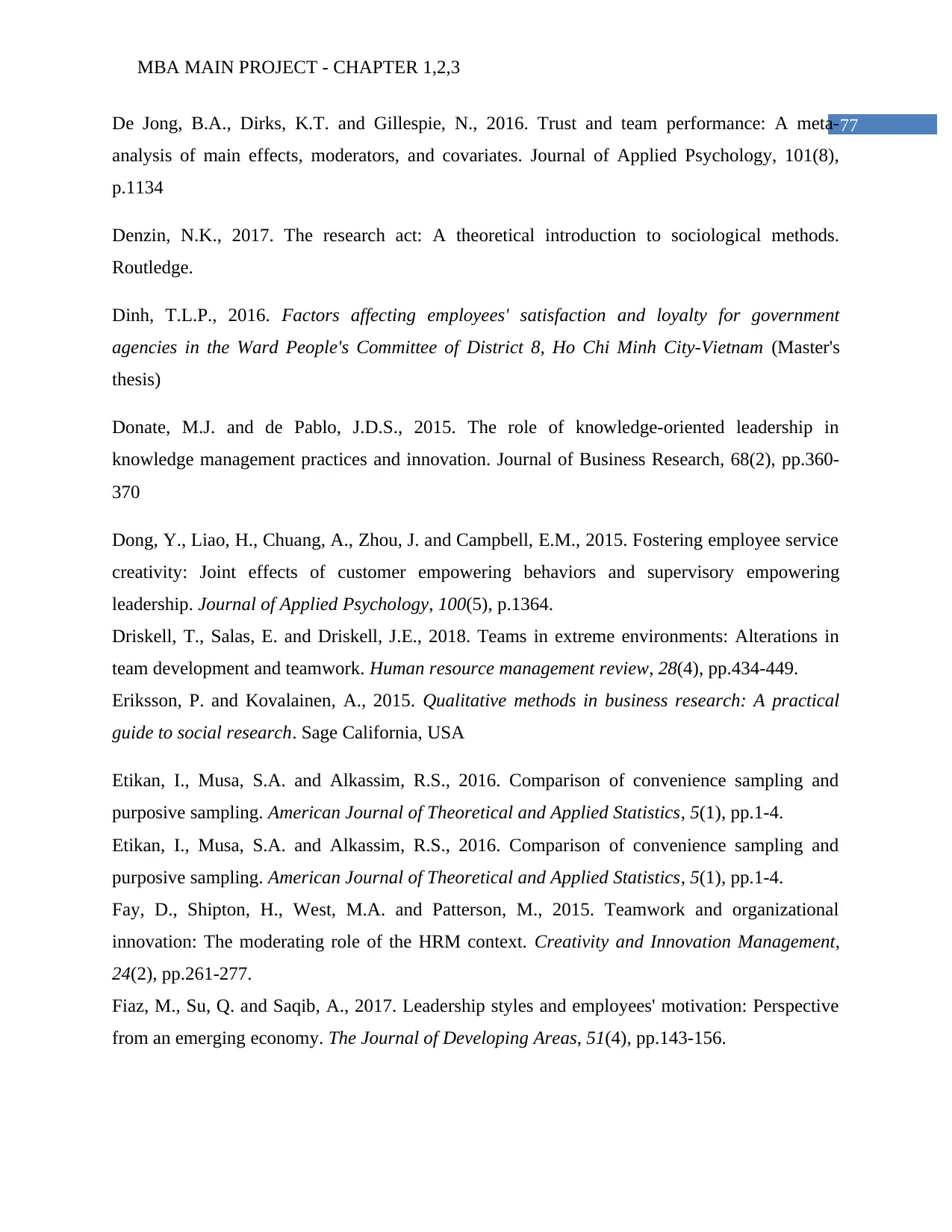
77De Jong, B.A., Dirks, K.T. and Gillespie, N., 2016. Trust and team performance: A meta-
analysis of main effects, moderators, and covariates. Journal of Applied Psychology, 101(8),
p.1134
Denzin, N.K., 2017. The research act: A theoretical introduction to sociological methods.
Routledge.
Dinh, T.L.P., 2016. Factors affecting employees' satisfaction and loyalty for government
agencies in the Ward People's Committee of District 8, Ho Chi Minh City-Vietnam (Master's
thesis)
Donate, M.J. and de Pablo, J.D.S., 2015. The role of knowledge-oriented leadership in
knowledge management practices and innovation. Journal of Business Research, 68(2), pp.360-
370
Dong, Y., Liao, H., Chuang, A., Zhou, J. and Campbell, E.M., 2015. Fostering employee service
creativity: Joint effects of customer empowering behaviors and supervisory empowering
leadership. Journal of Applied Psychology, 100(5), p.1364.
Driskell, T., Salas, E. and Driskell, J.E., 2018. Teams in extreme environments: Alterations in
team development and teamwork. Human resource management review, 28(4), pp.434-449.
Eriksson, P. and Kovalainen, A., 2015. Qualitative methods in business research: A practical
guide to social research. Sage California, USA
Etikan, I., Musa, S.A. and Alkassim, R.S., 2016. Comparison of convenience sampling and
purposive sampling. American Journal of Theoretical and Applied Statistics, 5(1), pp.1-4.
Etikan, I., Musa, S.A. and Alkassim, R.S., 2016. Comparison of convenience sampling and
purposive sampling. American Journal of Theoretical and Applied Statistics, 5(1), pp.1-4.
Fay, D., Shipton, H., West, M.A. and Patterson, M., 2015. Teamwork and organizational
innovation: The moderating role of the HRM context. Creativity and Innovation Management,
24(2), pp.261-277.
Fiaz, M., Su, Q. and Saqib, A., 2017. Leadership styles and employees' motivation: Perspective
from an emerging economy. The Journal of Developing Areas, 51(4), pp.143-156.
⊘ This is a preview!⊘
Do you want full access?
Subscribe today to unlock all pages.

Trusted by 1+ million students worldwide
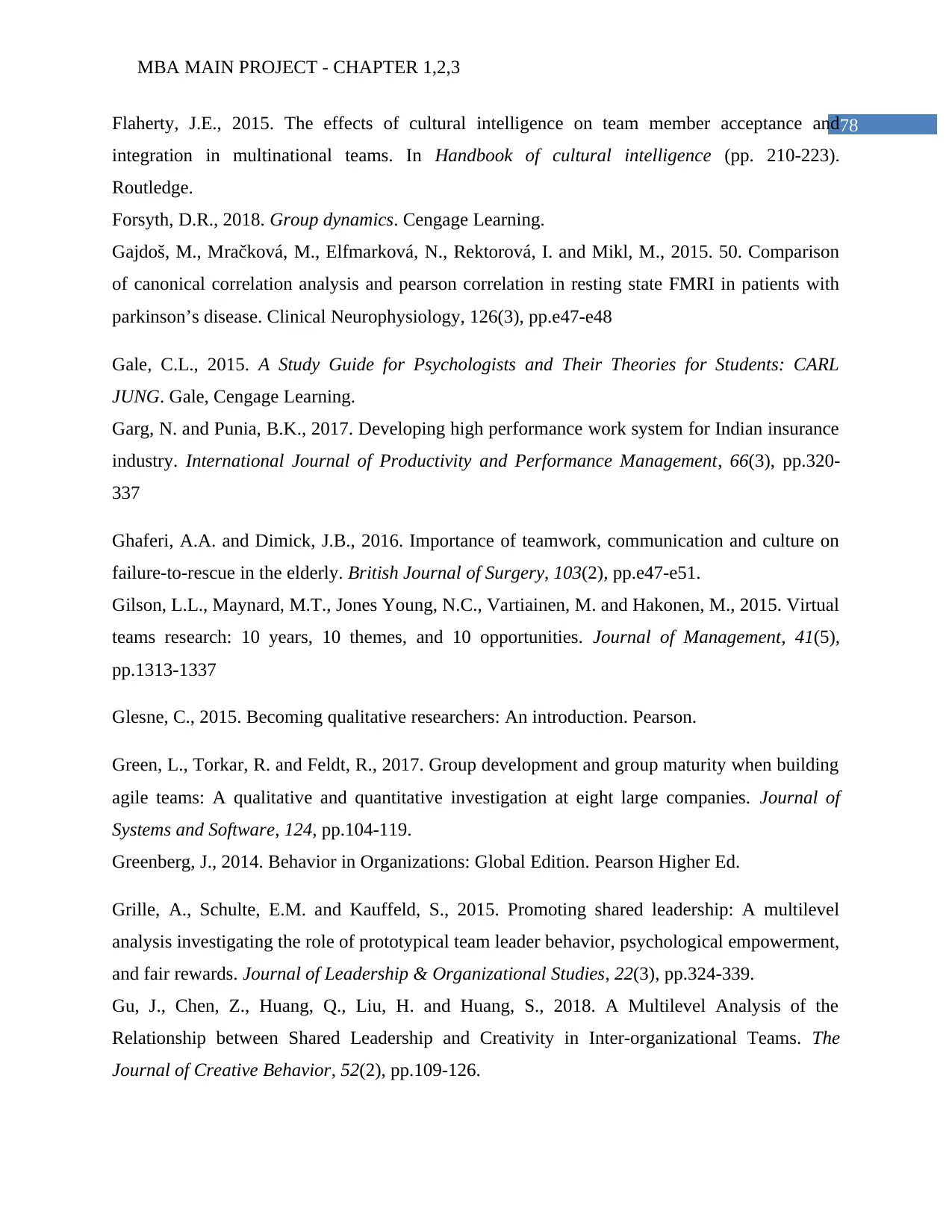
78Flaherty, J.E., 2015. The effects of cultural intelligence on team member acceptance and
integration in multinational teams. In Handbook of cultural intelligence (pp. 210-223).
Routledge.
Forsyth, D.R., 2018. Group dynamics. Cengage Learning.
Gajdoš, M., Mračková, M., Elfmarková, N., Rektorová, I. and Mikl, M., 2015. 50. Comparison
of canonical correlation analysis and pearson correlation in resting state FMRI in patients with
parkinson’s disease. Clinical Neurophysiology, 126(3), pp.e47-e48
Gale, C.L., 2015. A Study Guide for Psychologists and Their Theories for Students: CARL
JUNG. Gale, Cengage Learning.
Garg, N. and Punia, B.K., 2017. Developing high performance work system for Indian insurance
industry. International Journal of Productivity and Performance Management, 66(3), pp.320-
337
Ghaferi, A.A. and Dimick, J.B., 2016. Importance of teamwork, communication and culture on
failure‐to‐rescue in the elderly. British Journal of Surgery, 103(2), pp.e47-e51.
Gilson, L.L., Maynard, M.T., Jones Young, N.C., Vartiainen, M. and Hakonen, M., 2015. Virtual
teams research: 10 years, 10 themes, and 10 opportunities. Journal of Management, 41(5),
pp.1313-1337
Glesne, C., 2015. Becoming qualitative researchers: An introduction. Pearson.
Green, L., Torkar, R. and Feldt, R., 2017. Group development and group maturity when building
agile teams: A qualitative and quantitative investigation at eight large companies. Journal of
Systems and Software, 124, pp.104-119.
Greenberg, J., 2014. Behavior in Organizations: Global Edition. Pearson Higher Ed.
Grille, A., Schulte, E.M. and Kauffeld, S., 2015. Promoting shared leadership: A multilevel
analysis investigating the role of prototypical team leader behavior, psychological empowerment,
and fair rewards. Journal of Leadership & Organizational Studies, 22(3), pp.324-339.
Gu, J., Chen, Z., Huang, Q., Liu, H. and Huang, S., 2018. A Multilevel Analysis of the
Relationship between Shared Leadership and Creativity in Inter‐organizational Teams. The
Journal of Creative Behavior, 52(2), pp.109-126.
Paraphrase This Document
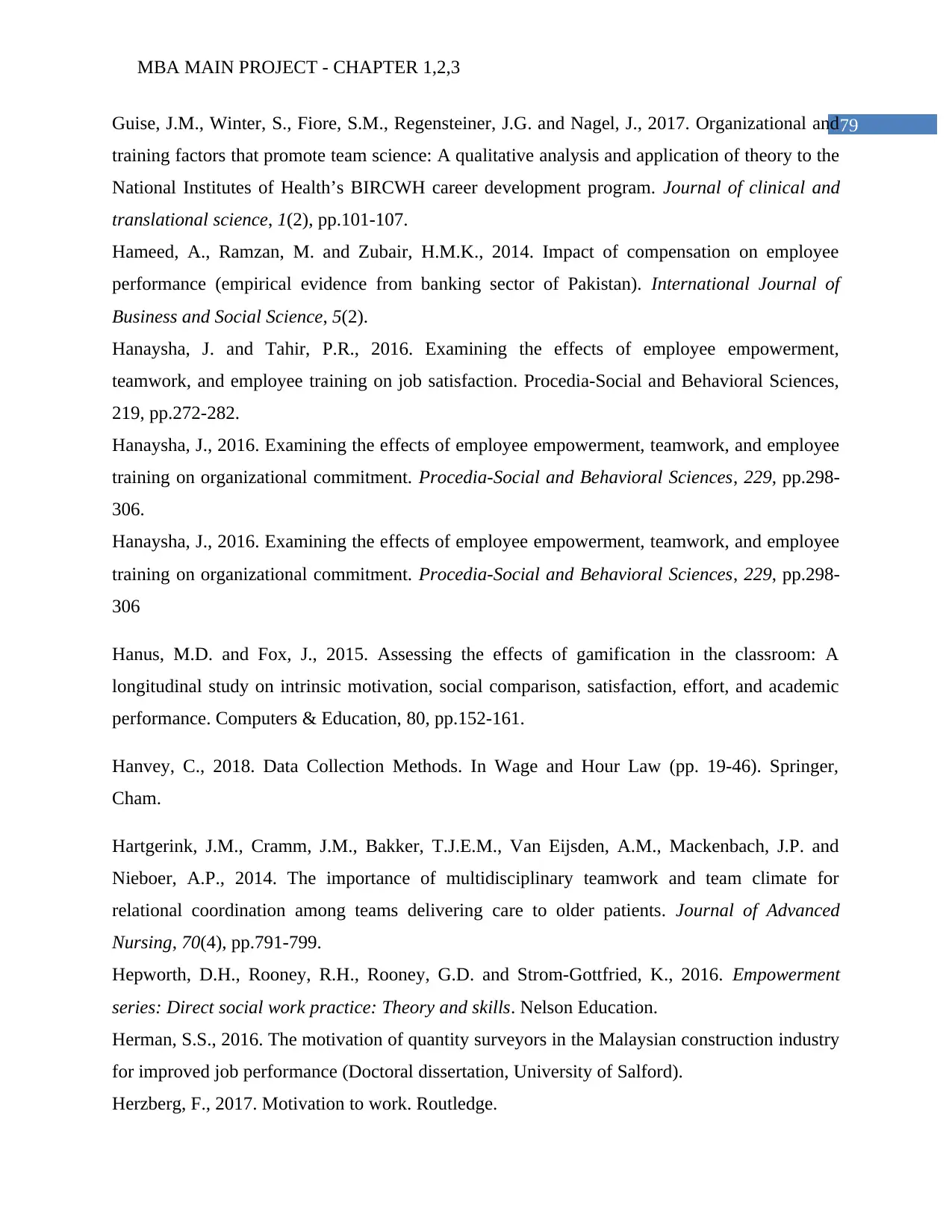
79Guise, J.M., Winter, S., Fiore, S.M., Regensteiner, J.G. and Nagel, J., 2017. Organizational and
training factors that promote team science: A qualitative analysis and application of theory to the
National Institutes of Health’s BIRCWH career development program. Journal of clinical and
translational science, 1(2), pp.101-107.
Hameed, A., Ramzan, M. and Zubair, H.M.K., 2014. Impact of compensation on employee
performance (empirical evidence from banking sector of Pakistan). International Journal of
Business and Social Science, 5(2).
Hanaysha, J. and Tahir, P.R., 2016. Examining the effects of employee empowerment,
teamwork, and employee training on job satisfaction. Procedia-Social and Behavioral Sciences,
219, pp.272-282.
Hanaysha, J., 2016. Examining the effects of employee empowerment, teamwork, and employee
training on organizational commitment. Procedia-Social and Behavioral Sciences, 229, pp.298-
306.
Hanaysha, J., 2016. Examining the effects of employee empowerment, teamwork, and employee
training on organizational commitment. Procedia-Social and Behavioral Sciences, 229, pp.298-
306
Hanus, M.D. and Fox, J., 2015. Assessing the effects of gamification in the classroom: A
longitudinal study on intrinsic motivation, social comparison, satisfaction, effort, and academic
performance. Computers & Education, 80, pp.152-161.
Hanvey, C., 2018. Data Collection Methods. In Wage and Hour Law (pp. 19-46). Springer,
Cham.
Hartgerink, J.M., Cramm, J.M., Bakker, T.J.E.M., Van Eijsden, A.M., Mackenbach, J.P. and
Nieboer, A.P., 2014. The importance of multidisciplinary teamwork and team climate for
relational coordination among teams delivering care to older patients. Journal of Advanced
Nursing, 70(4), pp.791-799.
Hepworth, D.H., Rooney, R.H., Rooney, G.D. and Strom-Gottfried, K., 2016. Empowerment
series: Direct social work practice: Theory and skills. Nelson Education.
Herman, S.S., 2016. The motivation of quantity surveyors in the Malaysian construction industry
for improved job performance (Doctoral dissertation, University of Salford).
Herzberg, F., 2017. Motivation to work. Routledge.

80Holloway, I. and Galvin, K., 2016. Qualitative research in nursing and healthcare. John Wiley
& Sons. New Jersey, USA
Hope, J., 2018. Maximize your leadership potential by understanding the 5 levels of leadership.
The Successful Registrar, 18(6), pp.8-8
Howard, L.W., Turban, D.B. and Hurley, S.K., 2016. Cooperating teams and competing reward
strategies: Incentives for team performance and firm productivity. Journal of Behavioral and
Applied Management, 3(3).
Hu, J. and Liden, R.C., 2015. Making a difference in the teamwork: Linking team prosocial
motivation to team processes and effectiveness. Academy of Management Journal, 58(4),
pp.1102-1127.
Hu, J. and Liden, R.C., 2015. Making a difference in the teamwork: Linking team prosocial
motivation to team processes and effectiveness. Academy of Management Journal, 58(4),
pp.1102-1127
Hu, J. and Liden, R.C., 2015. Making a difference in the teamwork: Linking team prosocial
motivation to team processes and effectiveness. Academy of Management Journal, 58(4),
pp.1102-1127.
Hu, J. and Liden, R.C., 2015. Making a difference in the teamwork: Linking team prosocial
motivation to team processes and effectiveness. Academy of Management Journal, 58(4),
pp.1102-1127.
Hussein, A., 2015. The use of triangulation in social sciences research: Can qualitative and
quantitative methods be combined?.Journal of comparative social work, 4(1)
Idris, M.A., Dollard, M.F. and Tuckey, M.R., 2015. Psychosocial safety climate as a
management tool for employee engagement and performance: A multilevel analysis.
International Journal of Stress Management, 22(2), p.183.
Idros, W., Sulaiman, W. and Mahbob, M.H., 2012. An Analysis on the Effectiveness of Team
Building: The Impact on Human Resources. Asian Social Science, 8(5), p.29.
Irfan, M. and Lodhi, S., 2015. Impact of Teamwork on Employee Motivation: A Case of
Banking Sector of Pakistan. The International Journal of Business & Management, 3(11), p.26.
⊘ This is a preview!⊘
Do you want full access?
Subscribe today to unlock all pages.

Trusted by 1+ million students worldwide
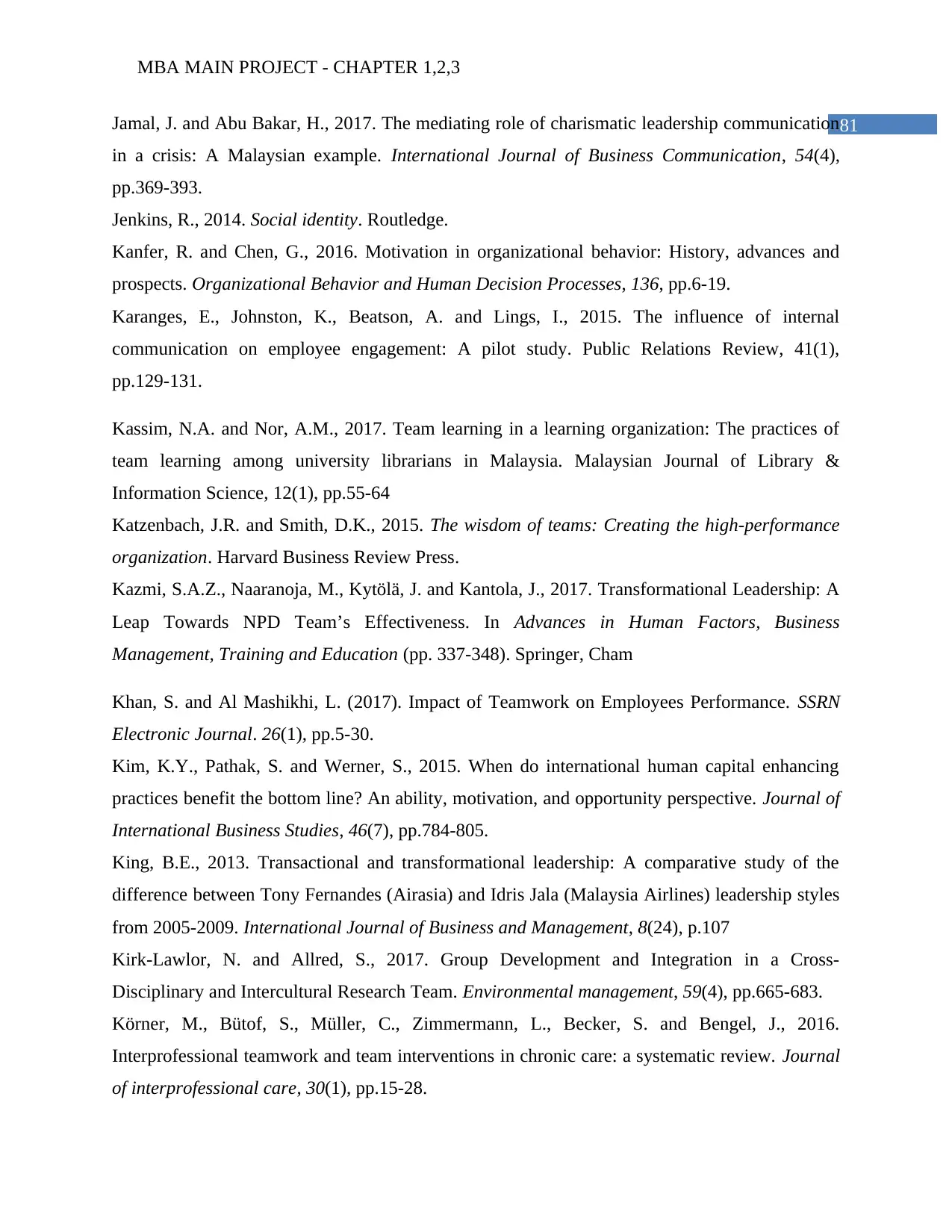
81Jamal, J. and Abu Bakar, H., 2017. The mediating role of charismatic leadership communication
in a crisis: A Malaysian example. International Journal of Business Communication, 54(4),
pp.369-393.
Jenkins, R., 2014. Social identity. Routledge.
Kanfer, R. and Chen, G., 2016. Motivation in organizational behavior: History, advances and
prospects. Organizational Behavior and Human Decision Processes, 136, pp.6-19.
Karanges, E., Johnston, K., Beatson, A. and Lings, I., 2015. The influence of internal
communication on employee engagement: A pilot study. Public Relations Review, 41(1),
pp.129-131.
Kassim, N.A. and Nor, A.M., 2017. Team learning in a learning organization: The practices of
team learning among university librarians in Malaysia. Malaysian Journal of Library &
Information Science, 12(1), pp.55-64
Katzenbach, J.R. and Smith, D.K., 2015. The wisdom of teams: Creating the high-performance
organization. Harvard Business Review Press.
Kazmi, S.A.Z., Naaranoja, M., Kytölä, J. and Kantola, J., 2017. Transformational Leadership: A
Leap Towards NPD Team’s Effectiveness. In Advances in Human Factors, Business
Management, Training and Education (pp. 337-348). Springer, Cham
Khan, S. and Al Mashikhi, L. (2017). Impact of Teamwork on Employees Performance. SSRN
Electronic Journal. 26(1), pp.5-30.
Kim, K.Y., Pathak, S. and Werner, S., 2015. When do international human capital enhancing
practices benefit the bottom line? An ability, motivation, and opportunity perspective. Journal of
International Business Studies, 46(7), pp.784-805.
King, B.E., 2013. Transactional and transformational leadership: A comparative study of the
difference between Tony Fernandes (Airasia) and Idris Jala (Malaysia Airlines) leadership styles
from 2005-2009. International Journal of Business and Management, 8(24), p.107
Kirk-Lawlor, N. and Allred, S., 2017. Group Development and Integration in a Cross-
Disciplinary and Intercultural Research Team. Environmental management, 59(4), pp.665-683.
Körner, M., Bütof, S., Müller, C., Zimmermann, L., Becker, S. and Bengel, J., 2016.
Interprofessional teamwork and team interventions in chronic care: a systematic review. Journal
of interprofessional care, 30(1), pp.15-28.
Paraphrase This Document
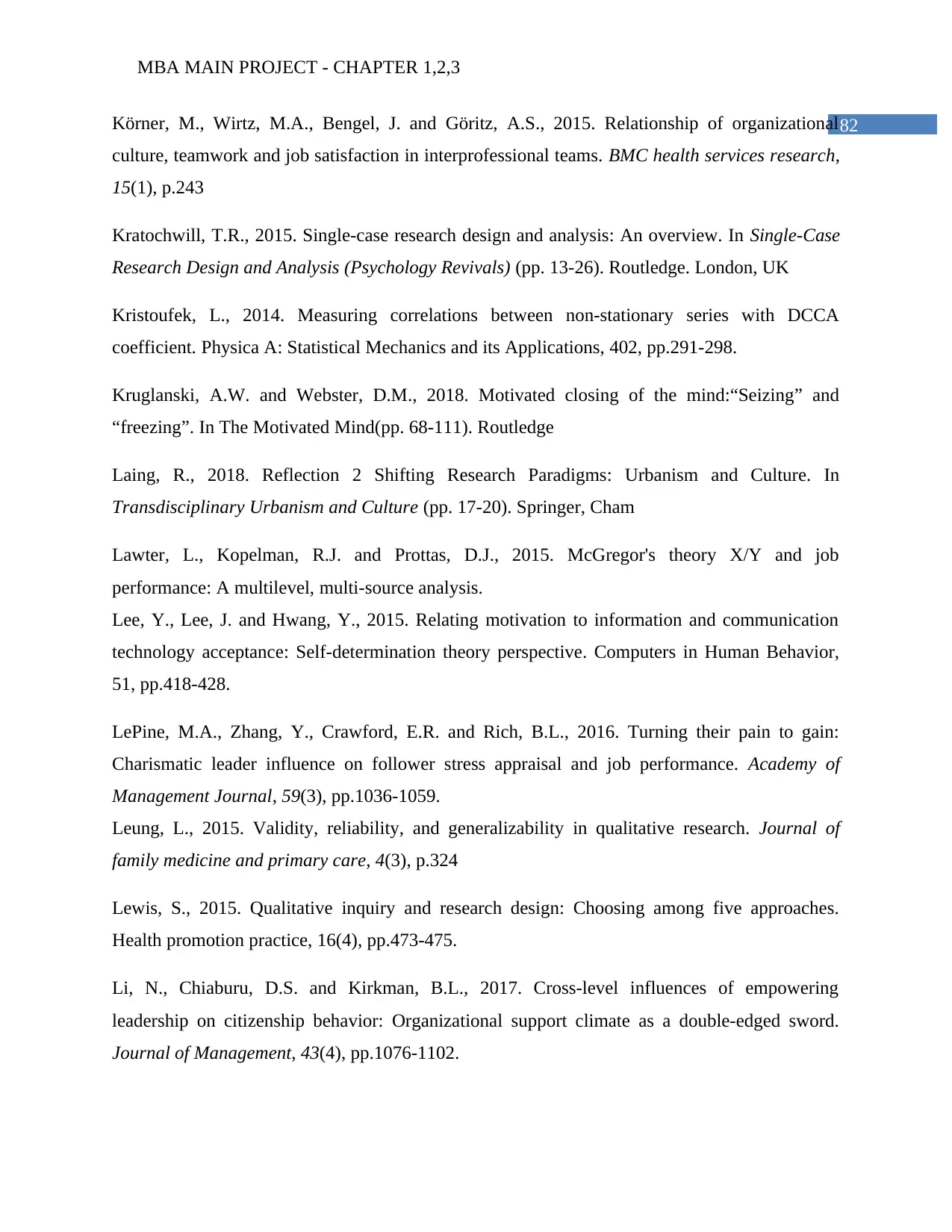
82Körner, M., Wirtz, M.A., Bengel, J. and Göritz, A.S., 2015. Relationship of organizational
culture, teamwork and job satisfaction in interprofessional teams. BMC health services research,
15(1), p.243
Kratochwill, T.R., 2015. Single-case research design and analysis: An overview. In Single-Case
Research Design and Analysis (Psychology Revivals) (pp. 13-26). Routledge. London, UK
Kristoufek, L., 2014. Measuring correlations between non-stationary series with DCCA
coefficient. Physica A: Statistical Mechanics and its Applications, 402, pp.291-298.
Kruglanski, A.W. and Webster, D.M., 2018. Motivated closing of the mind:“Seizing” and
“freezing”. In The Motivated Mind(pp. 68-111). Routledge
Laing, R., 2018. Reflection 2 Shifting Research Paradigms: Urbanism and Culture. In
Transdisciplinary Urbanism and Culture (pp. 17-20). Springer, Cham
Lawter, L., Kopelman, R.J. and Prottas, D.J., 2015. McGregor's theory X/Y and job
performance: A multilevel, multi-source analysis.
Lee, Y., Lee, J. and Hwang, Y., 2015. Relating motivation to information and communication
technology acceptance: Self-determination theory perspective. Computers in Human Behavior,
51, pp.418-428.
LePine, M.A., Zhang, Y., Crawford, E.R. and Rich, B.L., 2016. Turning their pain to gain:
Charismatic leader influence on follower stress appraisal and job performance. Academy of
Management Journal, 59(3), pp.1036-1059.
Leung, L., 2015. Validity, reliability, and generalizability in qualitative research. Journal of
family medicine and primary care, 4(3), p.324
Lewis, S., 2015. Qualitative inquiry and research design: Choosing among five approaches.
Health promotion practice, 16(4), pp.473-475.
Li, N., Chiaburu, D.S. and Kirkman, B.L., 2017. Cross-level influences of empowering
leadership on citizenship behavior: Organizational support climate as a double-edged sword.
Journal of Management, 43(4), pp.1076-1102.
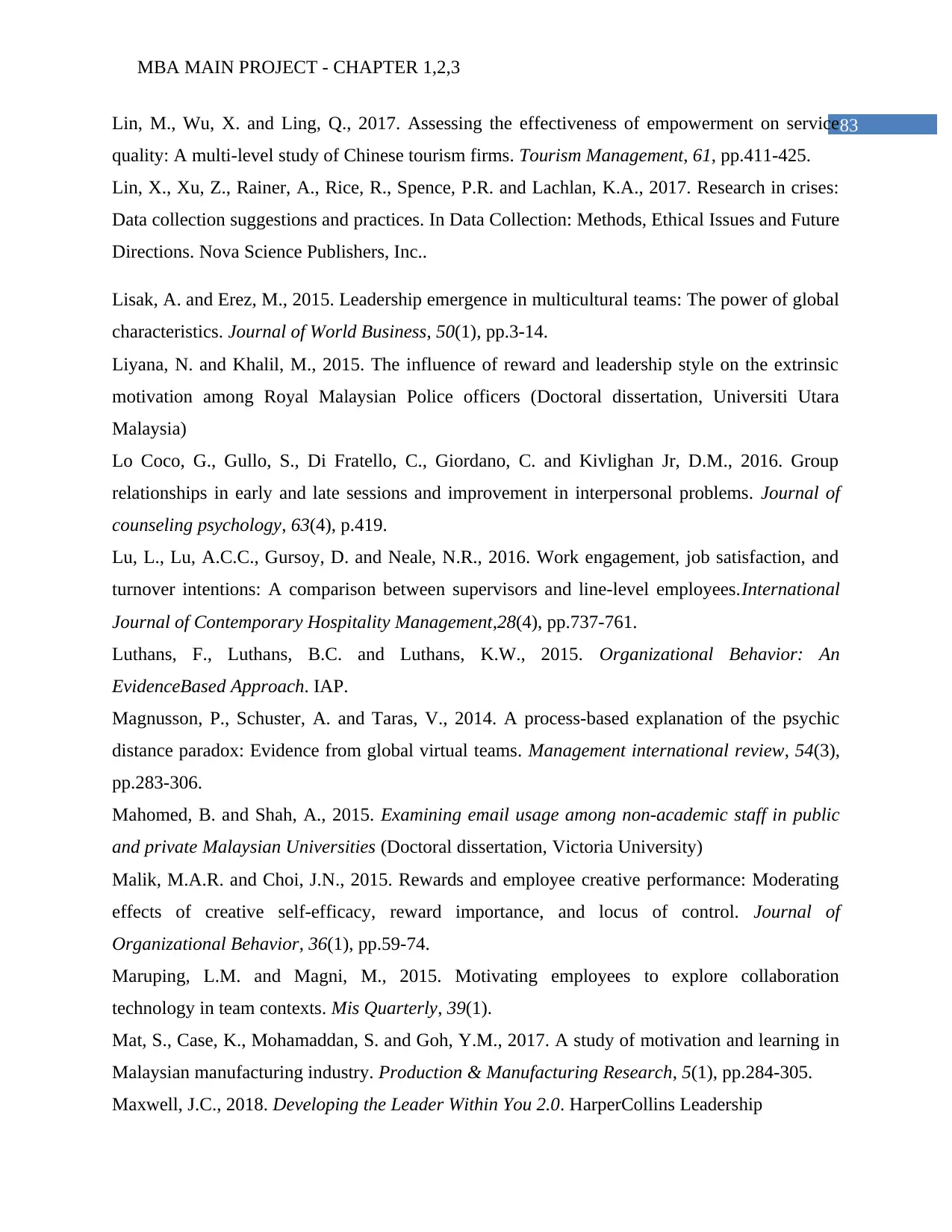
83Lin, M., Wu, X. and Ling, Q., 2017. Assessing the effectiveness of empowerment on service
quality: A multi-level study of Chinese tourism firms. Tourism Management, 61, pp.411-425.
Lin, X., Xu, Z., Rainer, A., Rice, R., Spence, P.R. and Lachlan, K.A., 2017. Research in crises:
Data collection suggestions and practices. In Data Collection: Methods, Ethical Issues and Future
Directions. Nova Science Publishers, Inc..
Lisak, A. and Erez, M., 2015. Leadership emergence in multicultural teams: The power of global
characteristics. Journal of World Business, 50(1), pp.3-14.
Liyana, N. and Khalil, M., 2015. The influence of reward and leadership style on the extrinsic
motivation among Royal Malaysian Police officers (Doctoral dissertation, Universiti Utara
Malaysia)
Lo Coco, G., Gullo, S., Di Fratello, C., Giordano, C. and Kivlighan Jr, D.M., 2016. Group
relationships in early and late sessions and improvement in interpersonal problems. Journal of
counseling psychology, 63(4), p.419.
Lu, L., Lu, A.C.C., Gursoy, D. and Neale, N.R., 2016. Work engagement, job satisfaction, and
turnover intentions: A comparison between supervisors and line-level employees.International
Journal of Contemporary Hospitality Management,28(4), pp.737-761.
Luthans, F., Luthans, B.C. and Luthans, K.W., 2015. Organizational Behavior: An
EvidenceBased Approach. IAP.
Magnusson, P., Schuster, A. and Taras, V., 2014. A process-based explanation of the psychic
distance paradox: Evidence from global virtual teams. Management international review, 54(3),
pp.283-306.
Mahomed, B. and Shah, A., 2015. Examining email usage among non-academic staff in public
and private Malaysian Universities (Doctoral dissertation, Victoria University)
Malik, M.A.R. and Choi, J.N., 2015. Rewards and employee creative performance: Moderating
effects of creative self‐efficacy, reward importance, and locus of control. Journal of
Organizational Behavior, 36(1), pp.59-74.
Maruping, L.M. and Magni, M., 2015. Motivating employees to explore collaboration
technology in team contexts. Mis Quarterly, 39(1).
Mat, S., Case, K., Mohamaddan, S. and Goh, Y.M., 2017. A study of motivation and learning in
Malaysian manufacturing industry. Production & Manufacturing Research, 5(1), pp.284-305.
Maxwell, J.C., 2018. Developing the Leader Within You 2.0. HarperCollins Leadership
⊘ This is a preview!⊘
Do you want full access?
Subscribe today to unlock all pages.

Trusted by 1+ million students worldwide
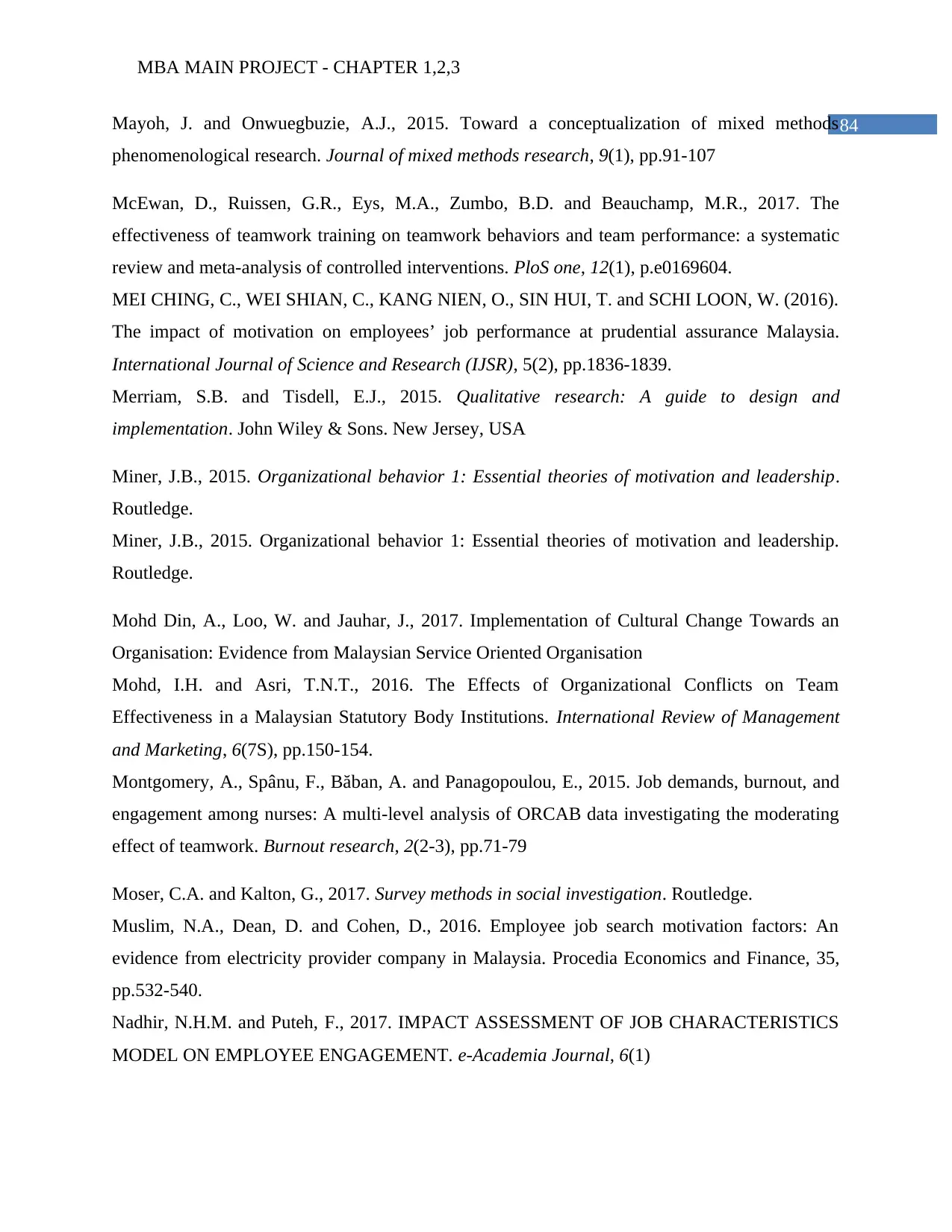
84Mayoh, J. and Onwuegbuzie, A.J., 2015. Toward a conceptualization of mixed methods
phenomenological research. Journal of mixed methods research, 9(1), pp.91-107
McEwan, D., Ruissen, G.R., Eys, M.A., Zumbo, B.D. and Beauchamp, M.R., 2017. The
effectiveness of teamwork training on teamwork behaviors and team performance: a systematic
review and meta-analysis of controlled interventions. PloS one, 12(1), p.e0169604.
MEI CHING, C., WEI SHIAN, C., KANG NIEN, O., SIN HUI, T. and SCHI LOON, W. (2016).
The impact of motivation on employees’ job performance at prudential assurance Malaysia.
International Journal of Science and Research (IJSR), 5(2), pp.1836-1839.
Merriam, S.B. and Tisdell, E.J., 2015. Qualitative research: A guide to design and
implementation. John Wiley & Sons. New Jersey, USA
Miner, J.B., 2015. Organizational behavior 1: Essential theories of motivation and leadership.
Routledge.
Miner, J.B., 2015. Organizational behavior 1: Essential theories of motivation and leadership.
Routledge.
Mohd Din, A., Loo, W. and Jauhar, J., 2017. Implementation of Cultural Change Towards an
Organisation: Evidence from Malaysian Service Oriented Organisation
Mohd, I.H. and Asri, T.N.T., 2016. The Effects of Organizational Conflicts on Team
Effectiveness in a Malaysian Statutory Body Institutions. International Review of Management
and Marketing, 6(7S), pp.150-154.
Montgomery, A., Spânu, F., Băban, A. and Panagopoulou, E., 2015. Job demands, burnout, and
engagement among nurses: A multi-level analysis of ORCAB data investigating the moderating
effect of teamwork. Burnout research, 2(2-3), pp.71-79
Moser, C.A. and Kalton, G., 2017. Survey methods in social investigation. Routledge.
Muslim, N.A., Dean, D. and Cohen, D., 2016. Employee job search motivation factors: An
evidence from electricity provider company in Malaysia. Procedia Economics and Finance, 35,
pp.532-540.
Nadhir, N.H.M. and Puteh, F., 2017. IMPACT ASSESSMENT OF JOB CHARACTERISTICS
MODEL ON EMPLOYEE ENGAGEMENT. e-Academia Journal, 6(1)
Paraphrase This Document
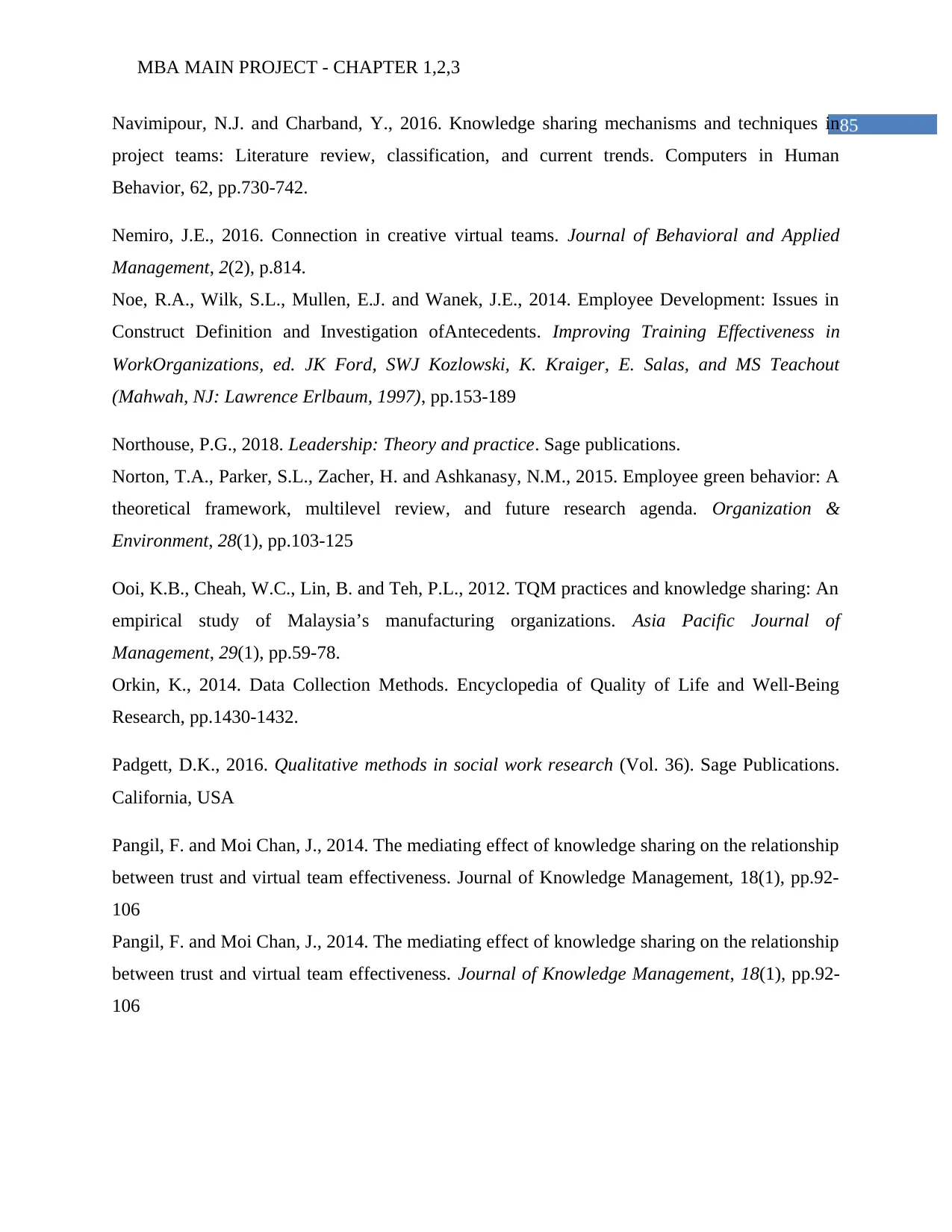
85Navimipour, N.J. and Charband, Y., 2016. Knowledge sharing mechanisms and techniques in
project teams: Literature review, classification, and current trends. Computers in Human
Behavior, 62, pp.730-742.
Nemiro, J.E., 2016. Connection in creative virtual teams. Journal of Behavioral and Applied
Management, 2(2), p.814.
Noe, R.A., Wilk, S.L., Mullen, E.J. and Wanek, J.E., 2014. Employee Development: Issues in
Construct Definition and Investigation ofAntecedents. Improving Training Effectiveness in
WorkOrganizations, ed. JK Ford, SWJ Kozlowski, K. Kraiger, E. Salas, and MS Teachout
(Mahwah, NJ: Lawrence Erlbaum, 1997), pp.153-189
Northouse, P.G., 2018. Leadership: Theory and practice. Sage publications.
Norton, T.A., Parker, S.L., Zacher, H. and Ashkanasy, N.M., 2015. Employee green behavior: A
theoretical framework, multilevel review, and future research agenda. Organization &
Environment, 28(1), pp.103-125
Ooi, K.B., Cheah, W.C., Lin, B. and Teh, P.L., 2012. TQM practices and knowledge sharing: An
empirical study of Malaysia’s manufacturing organizations. Asia Pacific Journal of
Management, 29(1), pp.59-78.
Orkin, K., 2014. Data Collection Methods. Encyclopedia of Quality of Life and Well-Being
Research, pp.1430-1432.
Padgett, D.K., 2016. Qualitative methods in social work research (Vol. 36). Sage Publications.
California, USA
Pangil, F. and Moi Chan, J., 2014. The mediating effect of knowledge sharing on the relationship
between trust and virtual team effectiveness. Journal of Knowledge Management, 18(1), pp.92-
106
Pangil, F. and Moi Chan, J., 2014. The mediating effect of knowledge sharing on the relationship
between trust and virtual team effectiveness. Journal of Knowledge Management, 18(1), pp.92-
106

86Peñarroja, V., Orengo, V., Zornoza, A., Sánchez, J. and Ripoll, P., 2015. How team feedback and
team trust influence information processing and learning in virtual teams: A moderated
mediation model. Computers in Human Behavior, 48, pp.9-16.
Quirke, B., 2017. Making the connections: using internal communication to turn strategy into
action. Routledge.
Rabey, G. (2003). The paradox of teamwork. Industrial and Commercial Training, 35(4),
pp.158-162.
Raes, E., Kyndt, E., Decuyper, S., Van den Bossche, P. and Dochy, F., 2015. An exploratory
study of group development and team learning. Human Resource Development Quarterly, 26(1),
pp.5-30.
Raziq, A. and Maulabakhsh, R., 2015. Impact of working environment on job satisfaction.
Procedia Economics and Finance, 23, pp.717-725.
Raziq, A. and Maulabakhsh, R., 2015. Impact of working environment on job satisfaction.
Procedia Economics and Finance, 23, pp.717-725
Rezvani, A., Chang, A., Wiewiora, A., Ashkanasy, N.M., Jordan, P.J. and Zolin, R., 2016.
Manager emotional intelligence and project success: The mediating role of job satisfaction and
trust. International Journal of Project Management, 34(7), pp.1112-1122.
Rose, K., Mathew, J., Millan, L. and Rabey, M. (2015). Effectiveness of team building in
organizations. Journal of Management, 46(6), pp.e2-e2.
Saad, M.S.M. and Majid, I.A., 2014. Employers’ perceptions of important employability skills
required from Malaysian engineering and information and communication technology (ICT)
graduates. Global Journal of Engineering Education, 16(3), pp.110-115.
Saleem, H., 2015. The impact of leadership styles on job satisfaction and mediating role of
perceived organizational politics. Procedia-Social and Behavioral Sciences, 172, pp.563-569
Schoorman, F.D. and Davis, J.H., 2016. Perspective: Empowerment in veterinary clinics: the role
of trust in delegation. Journal of Trust Research, 6(1), pp.91-95.
Seck, M.M. and Helton, L., 2014. Faculty development of a joint MSW program utilizing
Tuckman's model of stages of group development. Social Work with Groups, 37(2), pp.158-168.
Sekaran, U. and Bougie, R., 2016. Research methods for business: A skill building approach.
John Wiley & Sons. New jersey, USA
⊘ This is a preview!⊘
Do you want full access?
Subscribe today to unlock all pages.

Trusted by 1+ million students worldwide
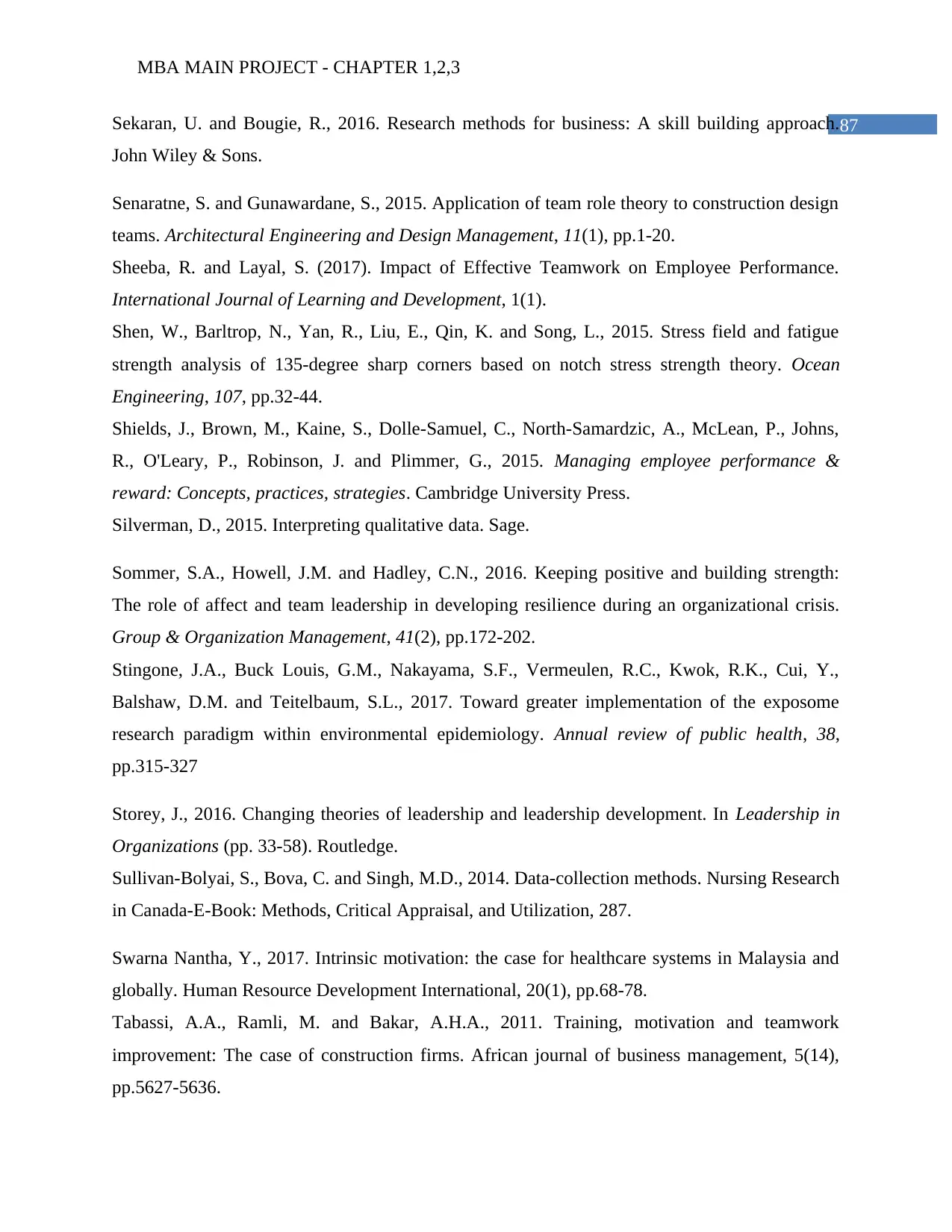
87Sekaran, U. and Bougie, R., 2016. Research methods for business: A skill building approach.
John Wiley & Sons.
Senaratne, S. and Gunawardane, S., 2015. Application of team role theory to construction design
teams. Architectural Engineering and Design Management, 11(1), pp.1-20.
Sheeba, R. and Layal, S. (2017). Impact of Effective Teamwork on Employee Performance.
International Journal of Learning and Development, 1(1).
Shen, W., Barltrop, N., Yan, R., Liu, E., Qin, K. and Song, L., 2015. Stress field and fatigue
strength analysis of 135-degree sharp corners based on notch stress strength theory. Ocean
Engineering, 107, pp.32-44.
Shields, J., Brown, M., Kaine, S., Dolle-Samuel, C., North-Samardzic, A., McLean, P., Johns,
R., O'Leary, P., Robinson, J. and Plimmer, G., 2015. Managing employee performance &
reward: Concepts, practices, strategies. Cambridge University Press.
Silverman, D., 2015. Interpreting qualitative data. Sage.
Sommer, S.A., Howell, J.M. and Hadley, C.N., 2016. Keeping positive and building strength:
The role of affect and team leadership in developing resilience during an organizational crisis.
Group & Organization Management, 41(2), pp.172-202.
Stingone, J.A., Buck Louis, G.M., Nakayama, S.F., Vermeulen, R.C., Kwok, R.K., Cui, Y.,
Balshaw, D.M. and Teitelbaum, S.L., 2017. Toward greater implementation of the exposome
research paradigm within environmental epidemiology. Annual review of public health, 38,
pp.315-327
Storey, J., 2016. Changing theories of leadership and leadership development. In Leadership in
Organizations (pp. 33-58). Routledge.
Sullivan-Bolyai, S., Bova, C. and Singh, M.D., 2014. Data-collection methods. Nursing Research
in Canada-E-Book: Methods, Critical Appraisal, and Utilization, 287.
Swarna Nantha, Y., 2017. Intrinsic motivation: the case for healthcare systems in Malaysia and
globally. Human Resource Development International, 20(1), pp.68-78.
Tabassi, A.A., Ramli, M. and Bakar, A.H.A., 2011. Training, motivation and teamwork
improvement: The case of construction firms. African journal of business management, 5(14),
pp.5627-5636.
Paraphrase This Document
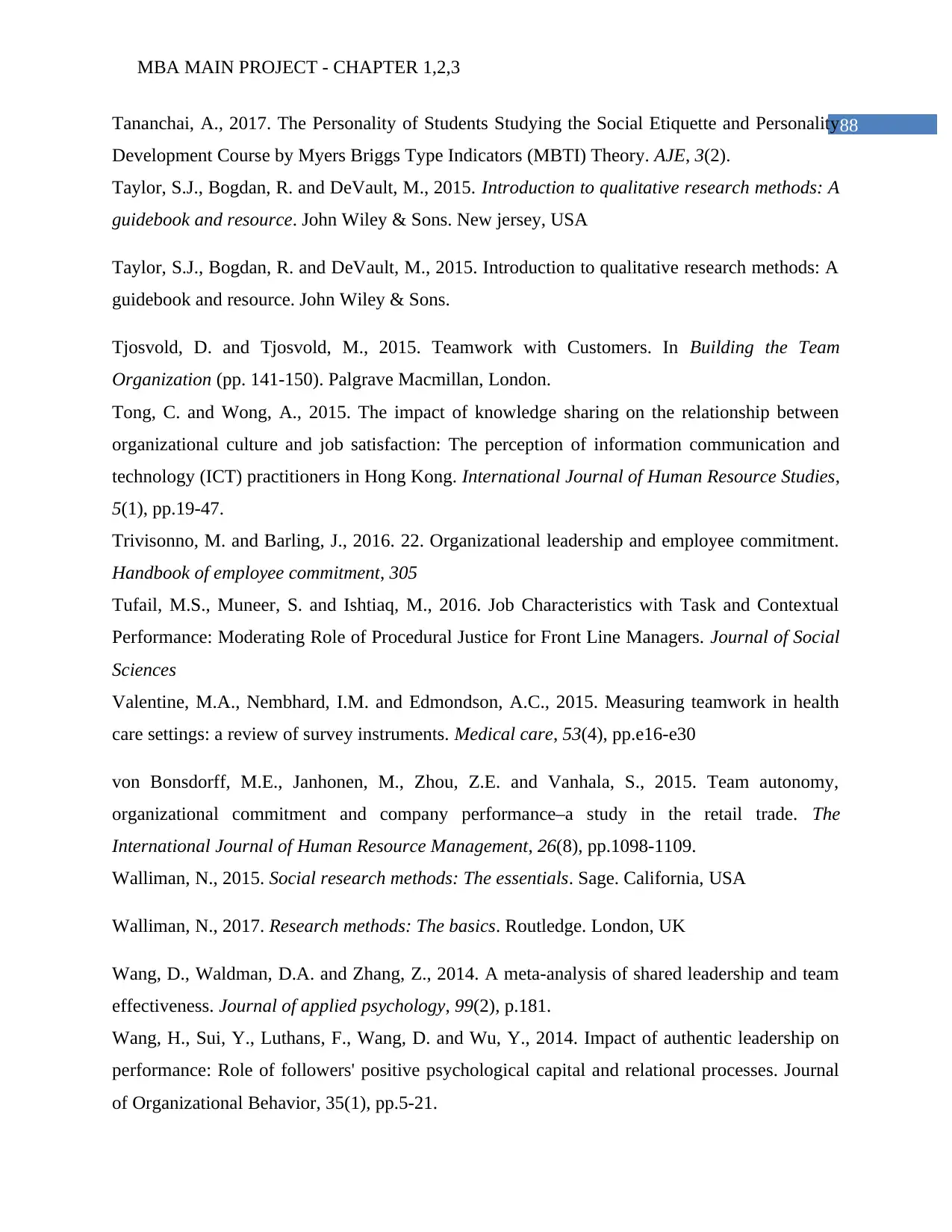
88Tananchai, A., 2017. The Personality of Students Studying the Social Etiquette and Personality
Development Course by Myers Briggs Type Indicators (MBTI) Theory. AJE, 3(2).
Taylor, S.J., Bogdan, R. and DeVault, M., 2015. Introduction to qualitative research methods: A
guidebook and resource. John Wiley & Sons. New jersey, USA
Taylor, S.J., Bogdan, R. and DeVault, M., 2015. Introduction to qualitative research methods: A
guidebook and resource. John Wiley & Sons.
Tjosvold, D. and Tjosvold, M., 2015. Teamwork with Customers. In Building the Team
Organization (pp. 141-150). Palgrave Macmillan, London.
Tong, C. and Wong, A., 2015. The impact of knowledge sharing on the relationship between
organizational culture and job satisfaction: The perception of information communication and
technology (ICT) practitioners in Hong Kong. International Journal of Human Resource Studies,
5(1), pp.19-47.
Trivisonno, M. and Barling, J., 2016. 22. Organizational leadership and employee commitment.
Handbook of employee commitment, 305
Tufail, M.S., Muneer, S. and Ishtiaq, M., 2016. Job Characteristics with Task and Contextual
Performance: Moderating Role of Procedural Justice for Front Line Managers. Journal of Social
Sciences
Valentine, M.A., Nembhard, I.M. and Edmondson, A.C., 2015. Measuring teamwork in health
care settings: a review of survey instruments. Medical care, 53(4), pp.e16-e30
von Bonsdorff, M.E., Janhonen, M., Zhou, Z.E. and Vanhala, S., 2015. Team autonomy,
organizational commitment and company performance–a study in the retail trade. The
International Journal of Human Resource Management, 26(8), pp.1098-1109.
Walliman, N., 2015. Social research methods: The essentials. Sage. California, USA
Walliman, N., 2017. Research methods: The basics. Routledge. London, UK
Wang, D., Waldman, D.A. and Zhang, Z., 2014. A meta-analysis of shared leadership and team
effectiveness. Journal of applied psychology, 99(2), p.181.
Wang, H., Sui, Y., Luthans, F., Wang, D. and Wu, Y., 2014. Impact of authentic leadership on
performance: Role of followers' positive psychological capital and relational processes. Journal
of Organizational Behavior, 35(1), pp.5-21.
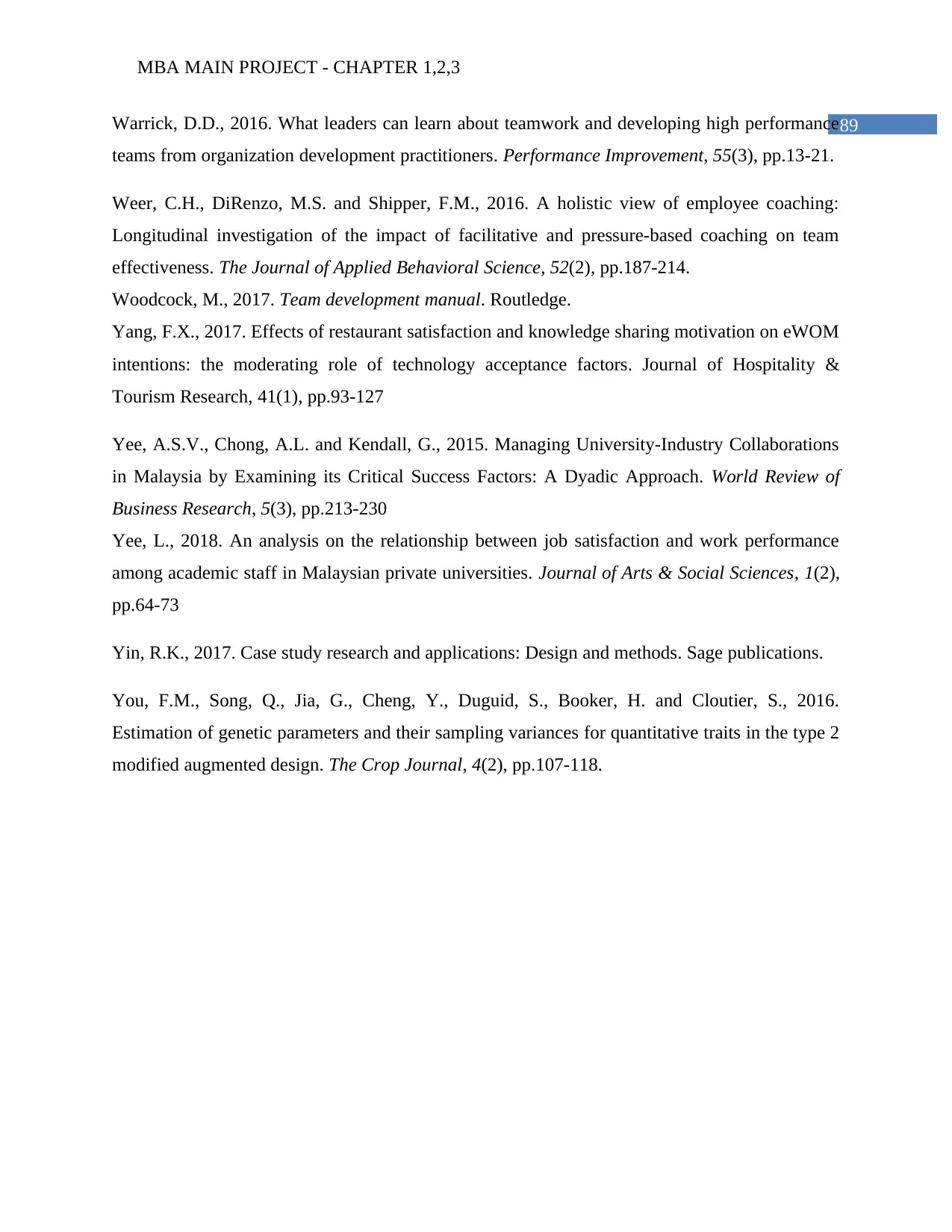
89Warrick, D.D., 2016. What leaders can learn about teamwork and developing high performance
teams from organization development practitioners. Performance Improvement, 55(3), pp.13-21.
Weer, C.H., DiRenzo, M.S. and Shipper, F.M., 2016. A holistic view of employee coaching:
Longitudinal investigation of the impact of facilitative and pressure-based coaching on team
effectiveness. The Journal of Applied Behavioral Science, 52(2), pp.187-214.
Woodcock, M., 2017. Team development manual. Routledge.
Yang, F.X., 2017. Effects of restaurant satisfaction and knowledge sharing motivation on eWOM
intentions: the moderating role of technology acceptance factors. Journal of Hospitality &
Tourism Research, 41(1), pp.93-127
Yee, A.S.V., Chong, A.L. and Kendall, G., 2015. Managing University-Industry Collaborations
in Malaysia by Examining its Critical Success Factors: A Dyadic Approach. World Review of
Business Research, 5(3), pp.213-230
Yee, L., 2018. An analysis on the relationship between job satisfaction and work performance
among academic staff in Malaysian private universities. Journal of Arts & Social Sciences, 1(2),
pp.64-73
Yin, R.K., 2017. Case study research and applications: Design and methods. Sage publications.
You, F.M., Song, Q., Jia, G., Cheng, Y., Duguid, S., Booker, H. and Cloutier, S., 2016.
Estimation of genetic parameters and their sampling variances for quantitative traits in the type 2
modified augmented design. The Crop Journal, 4(2), pp.107-118.
⊘ This is a preview!⊘
Do you want full access?
Subscribe today to unlock all pages.

Trusted by 1+ million students worldwide
Related Documents
Your All-in-One AI-Powered Toolkit for Academic Success.
+13062052269
info@desklib.com
Available 24*7 on WhatsApp / Email
![[object Object]](/_next/static/media/star-bottom.7253800d.svg)
© 2024 | Zucol Services PVT LTD | All rights reserved.



